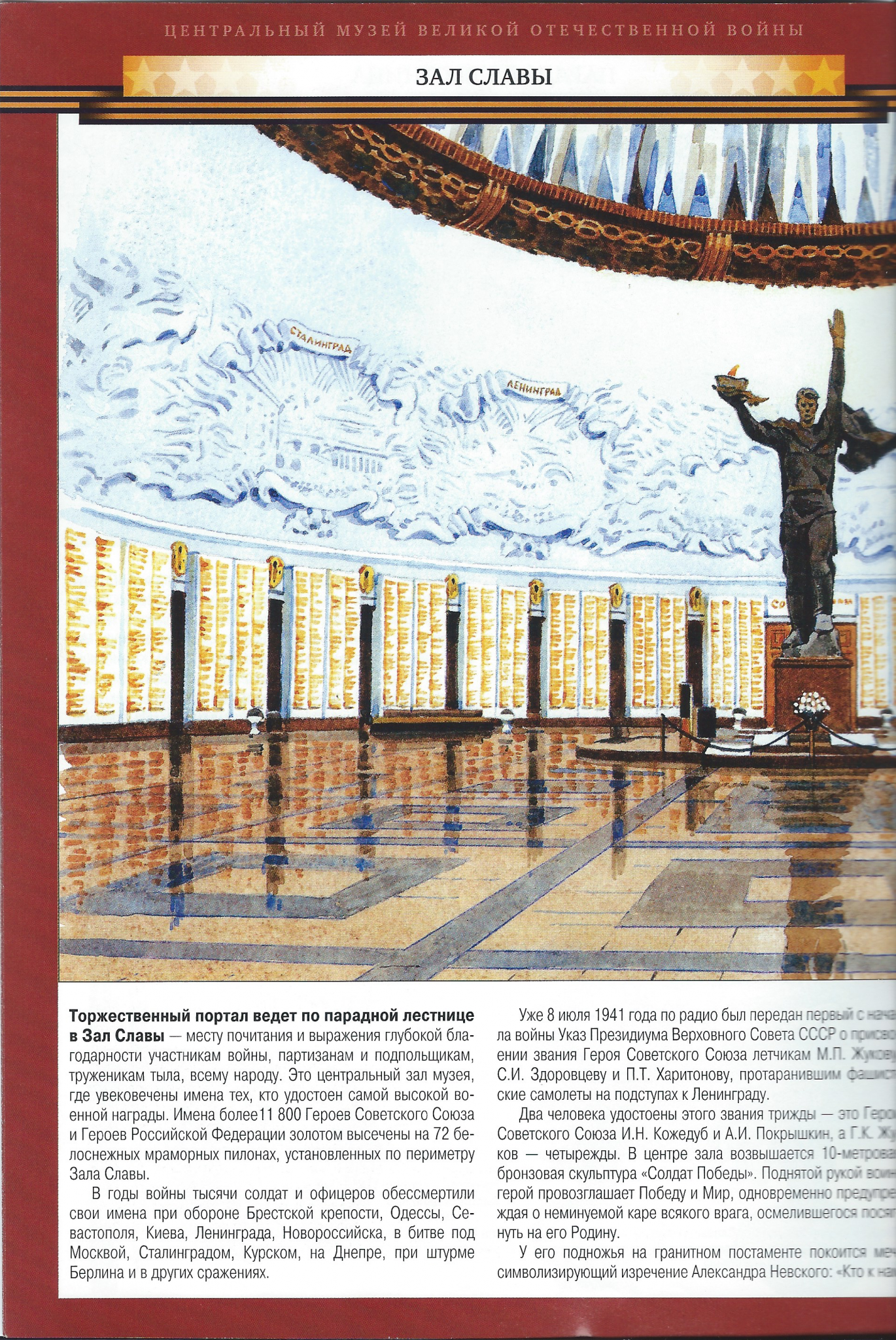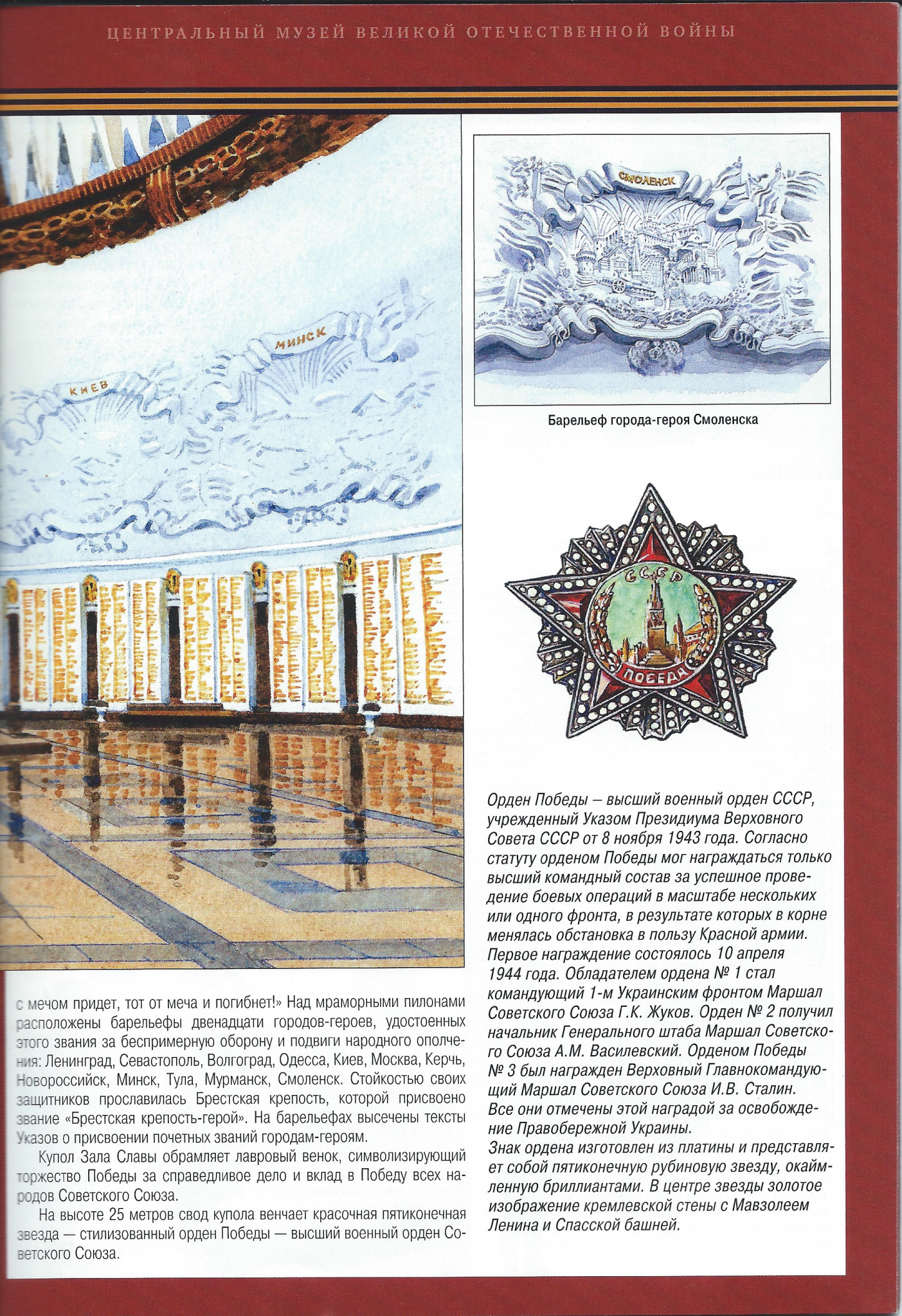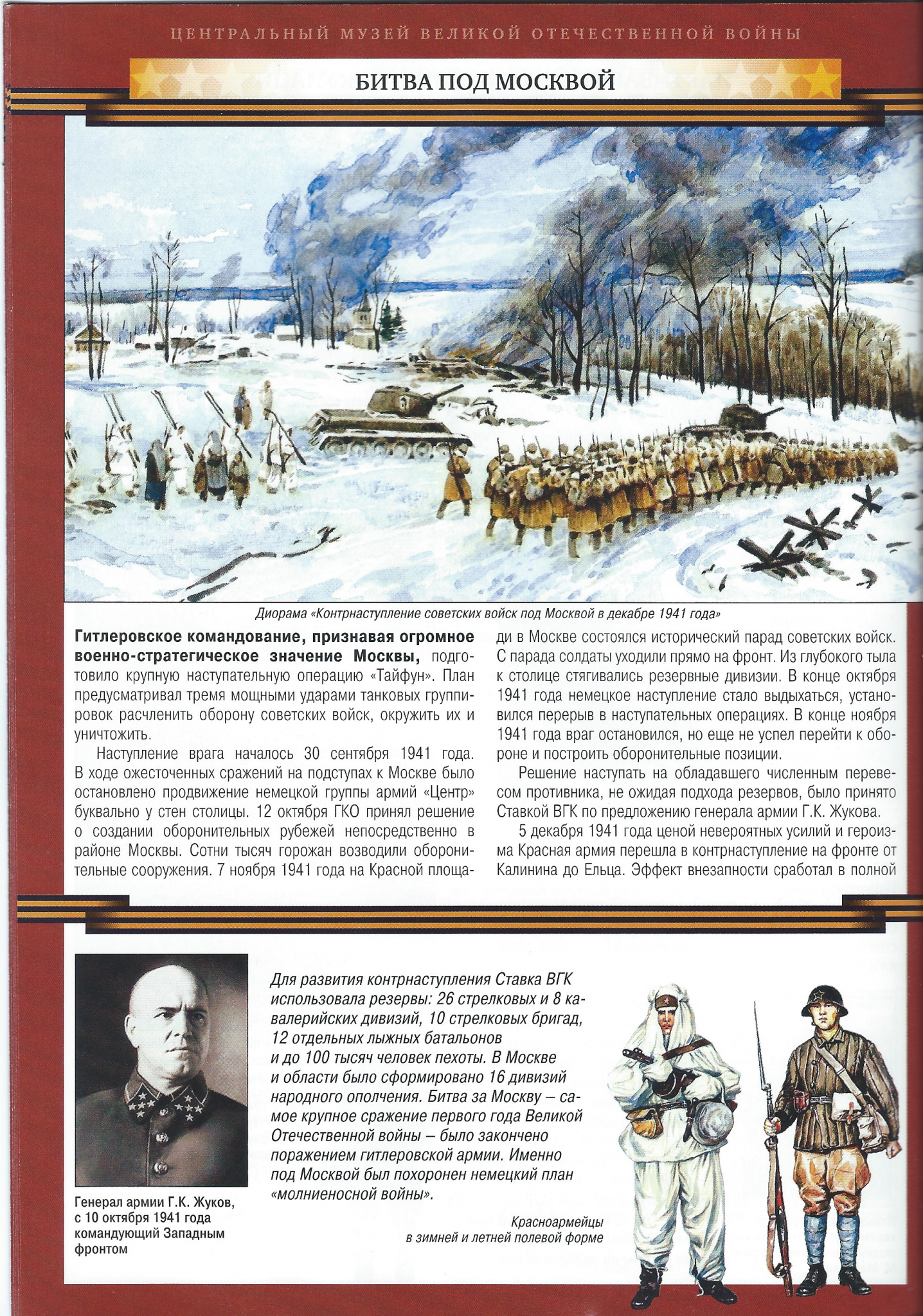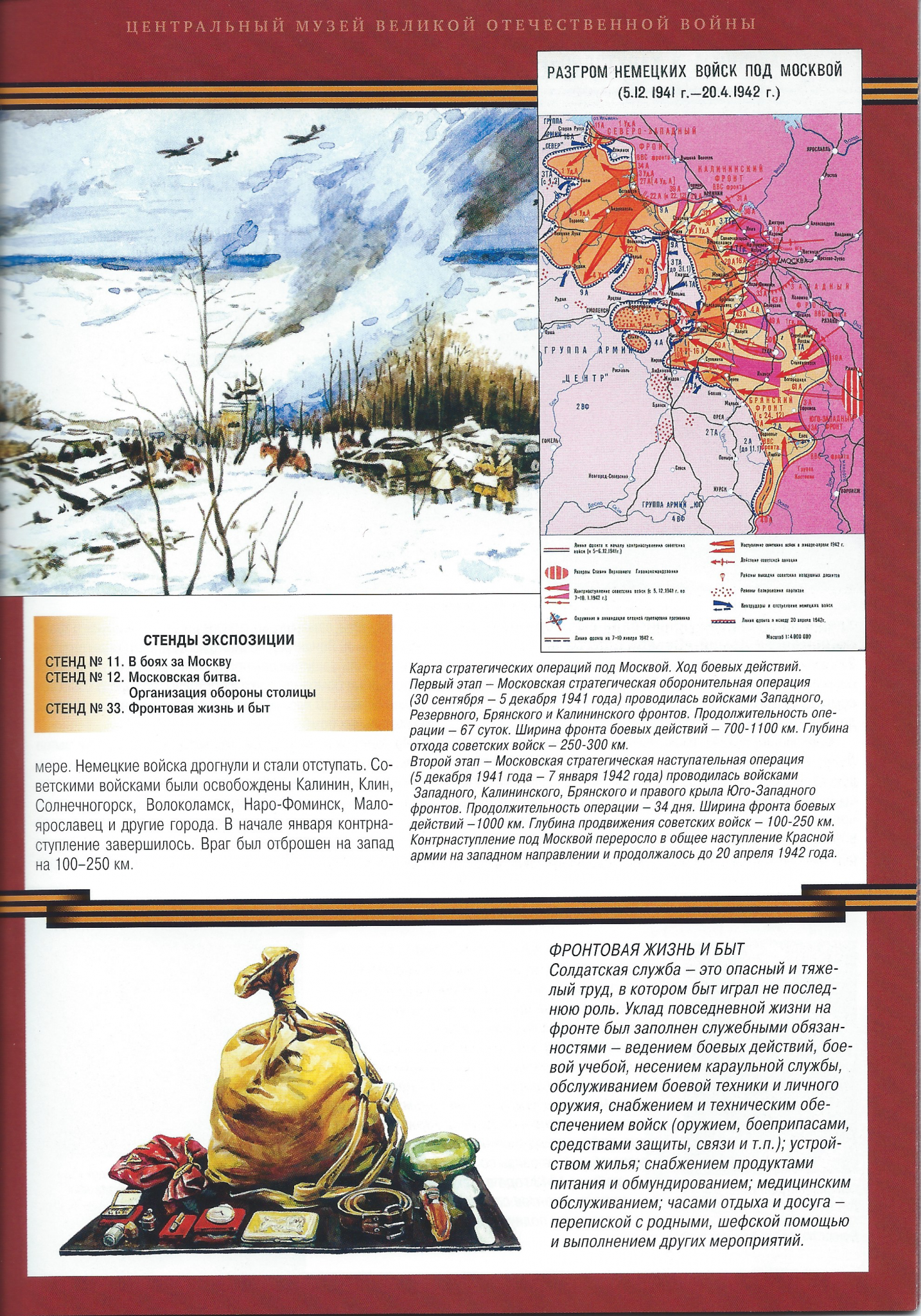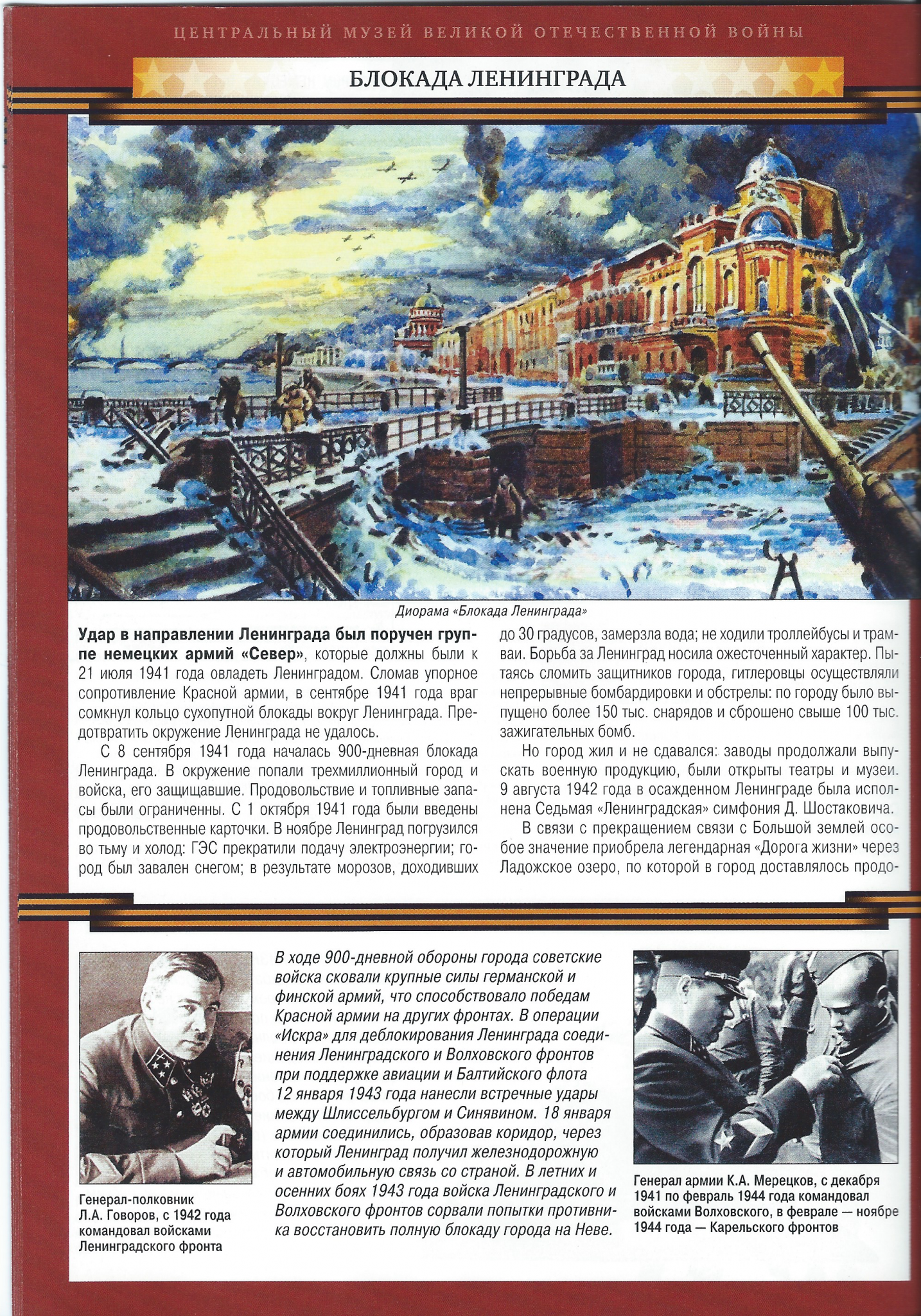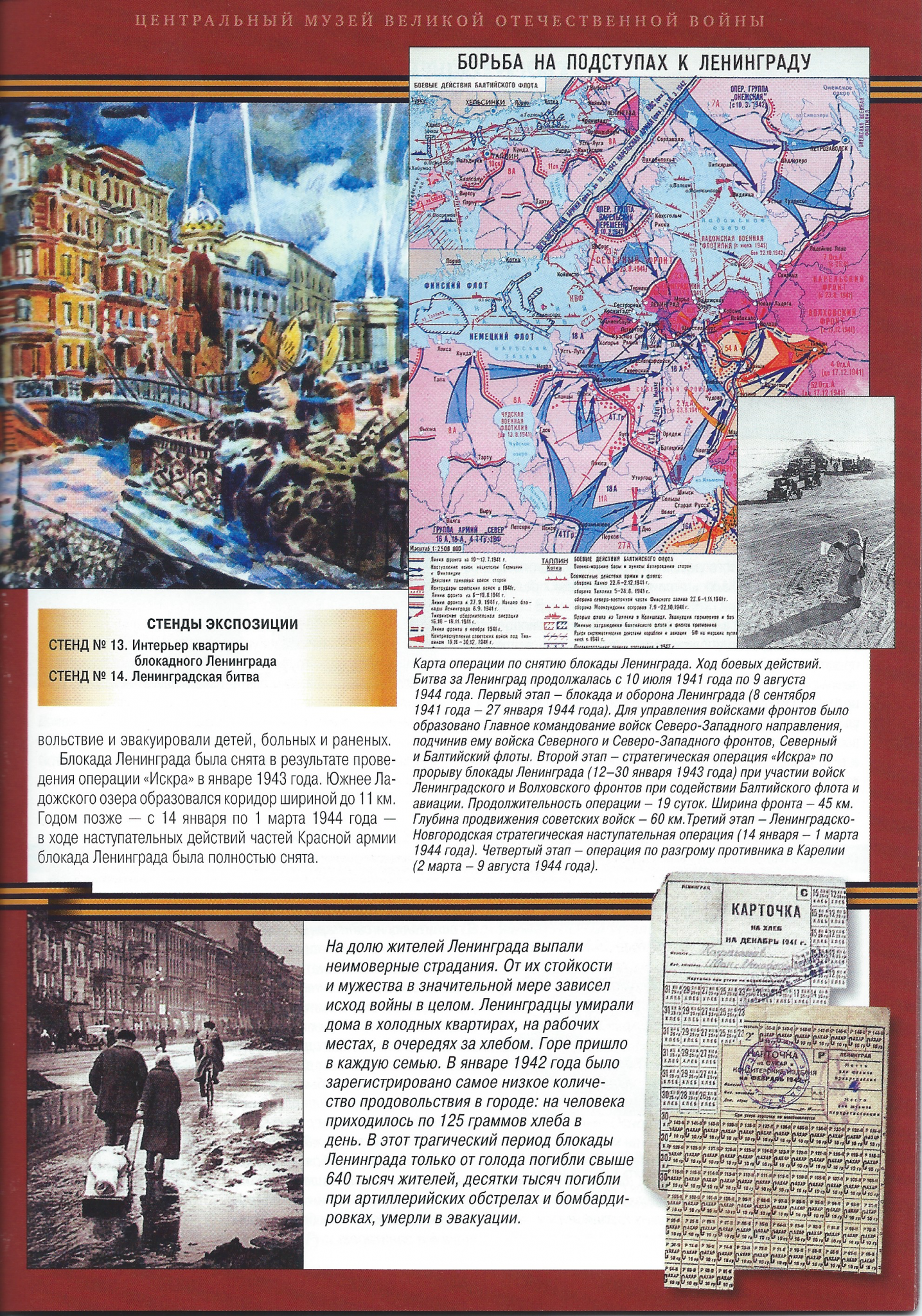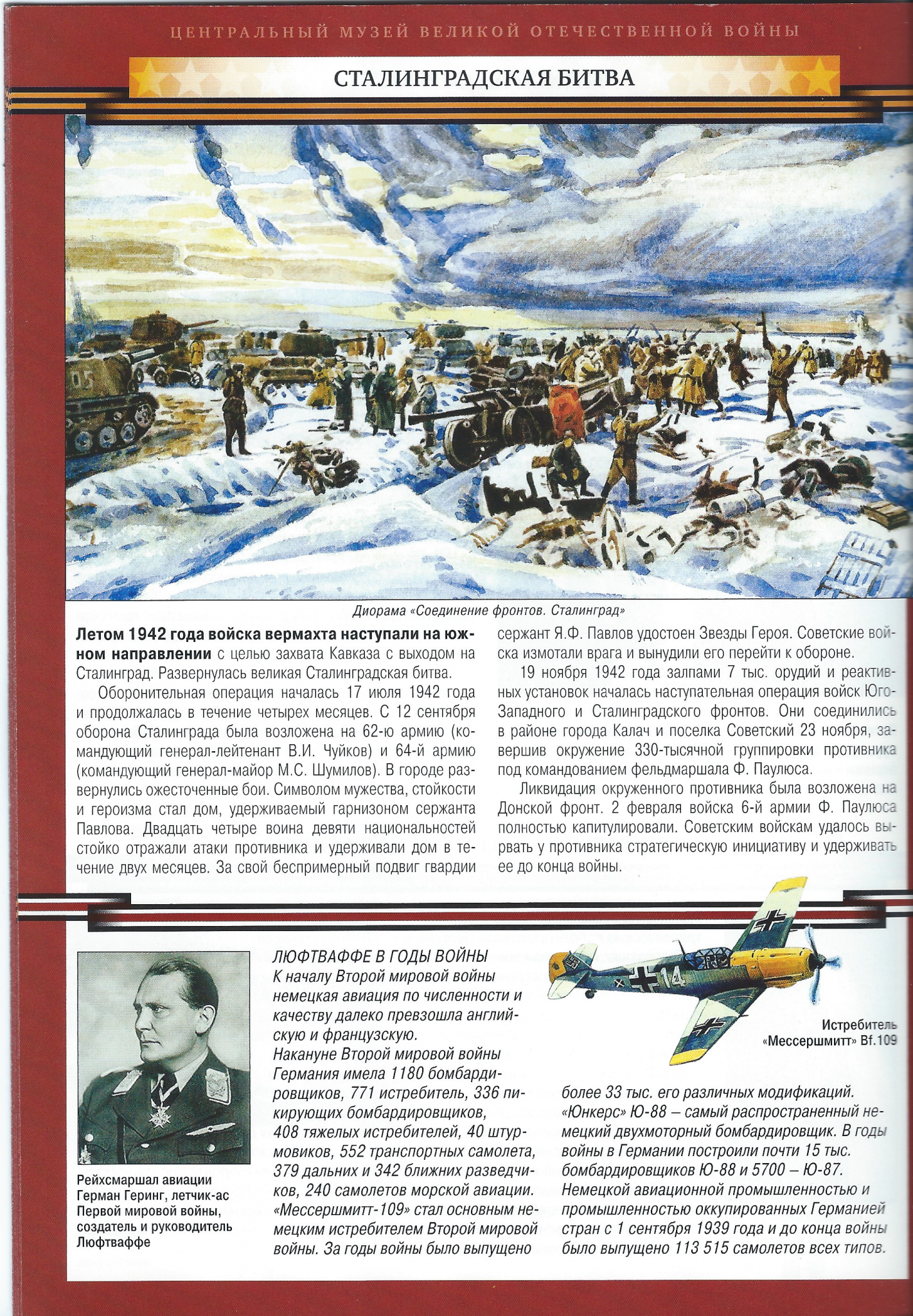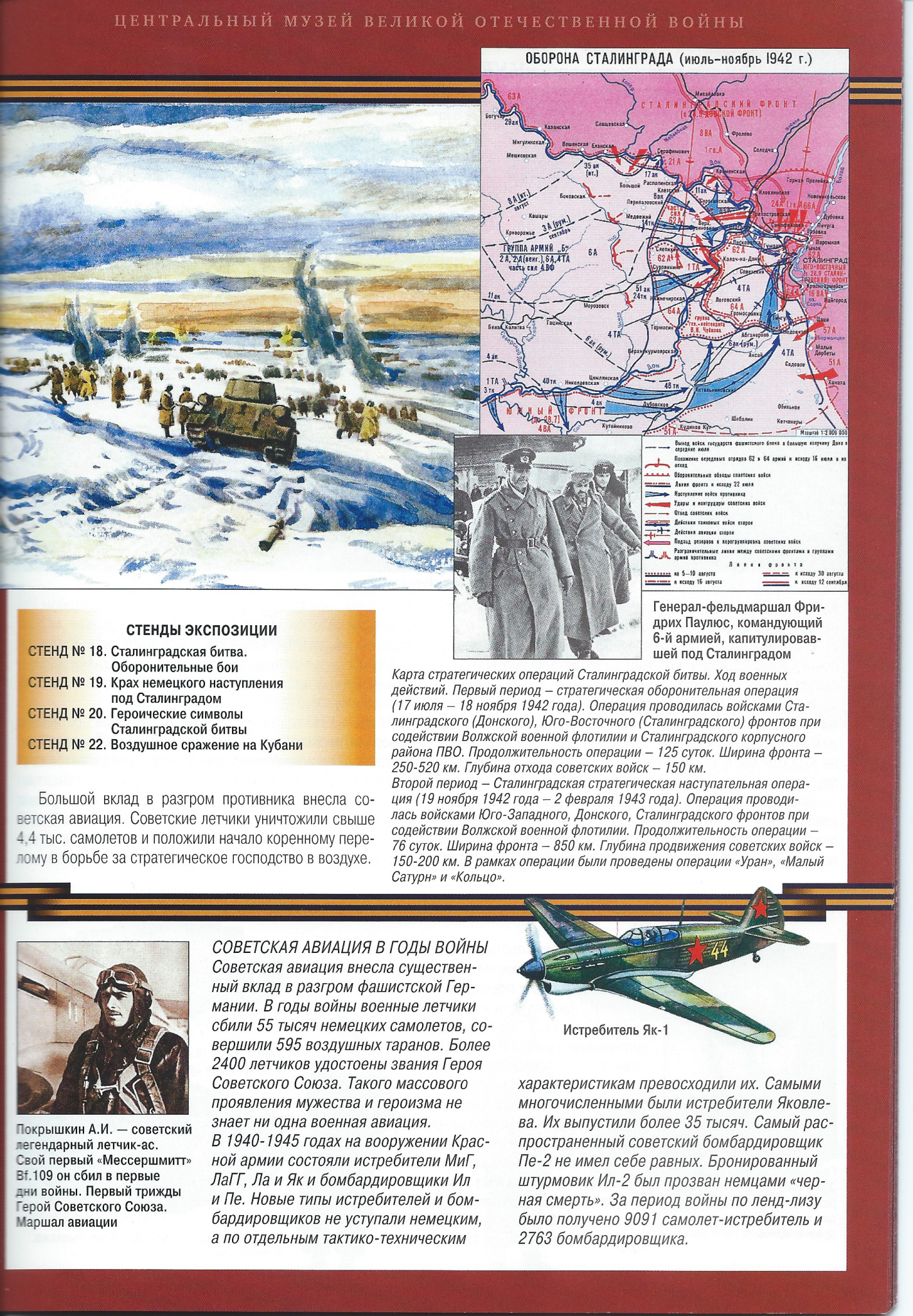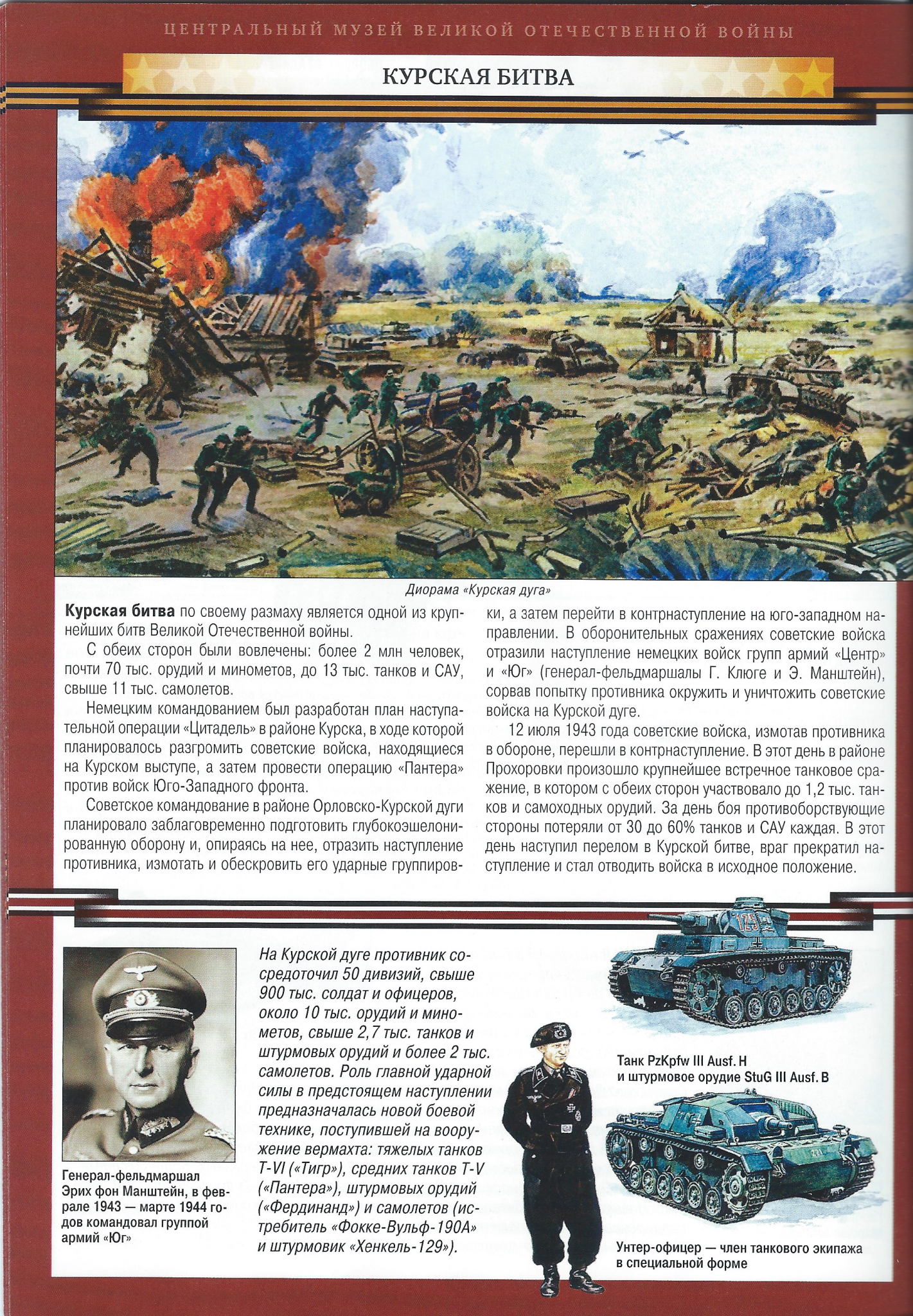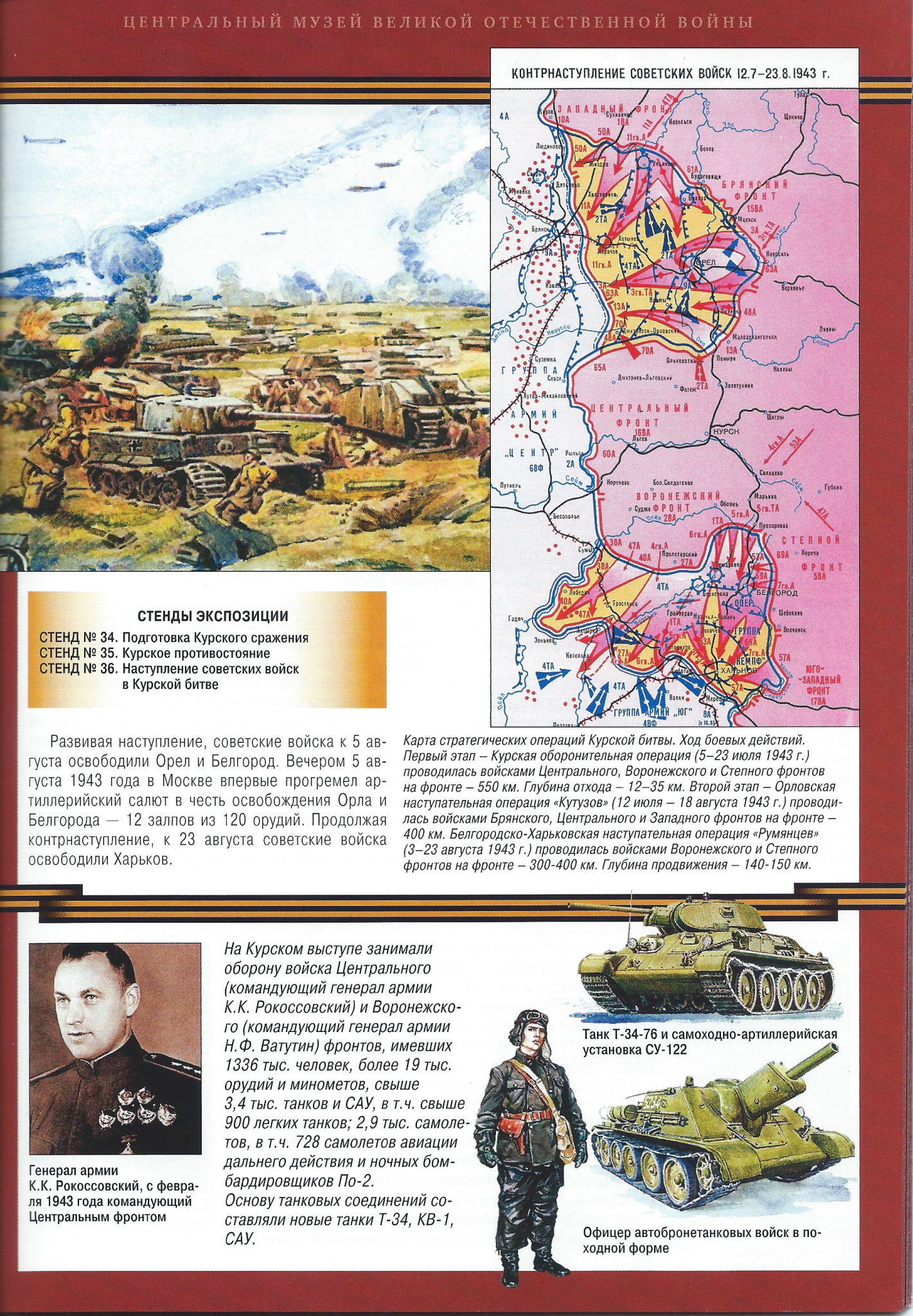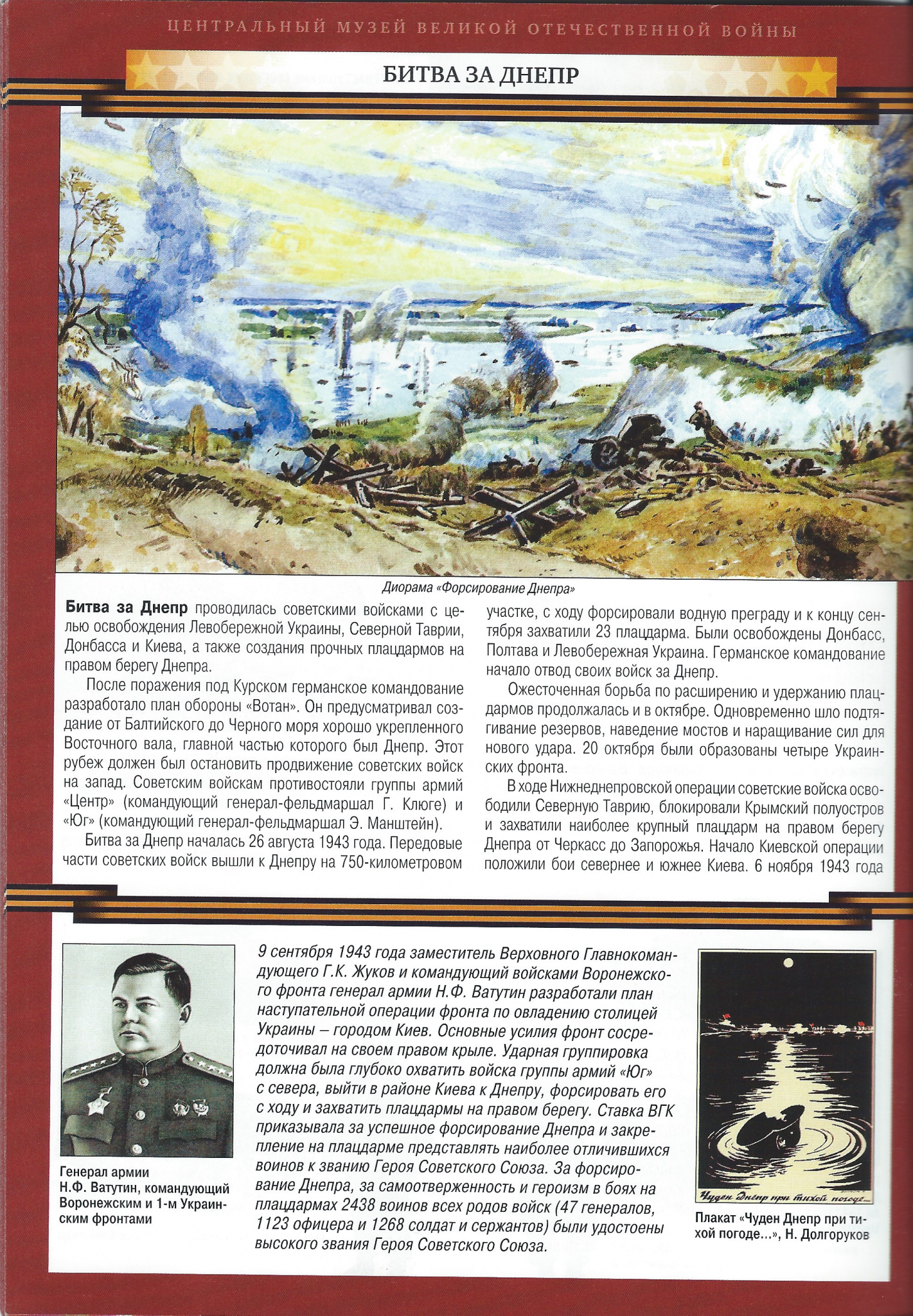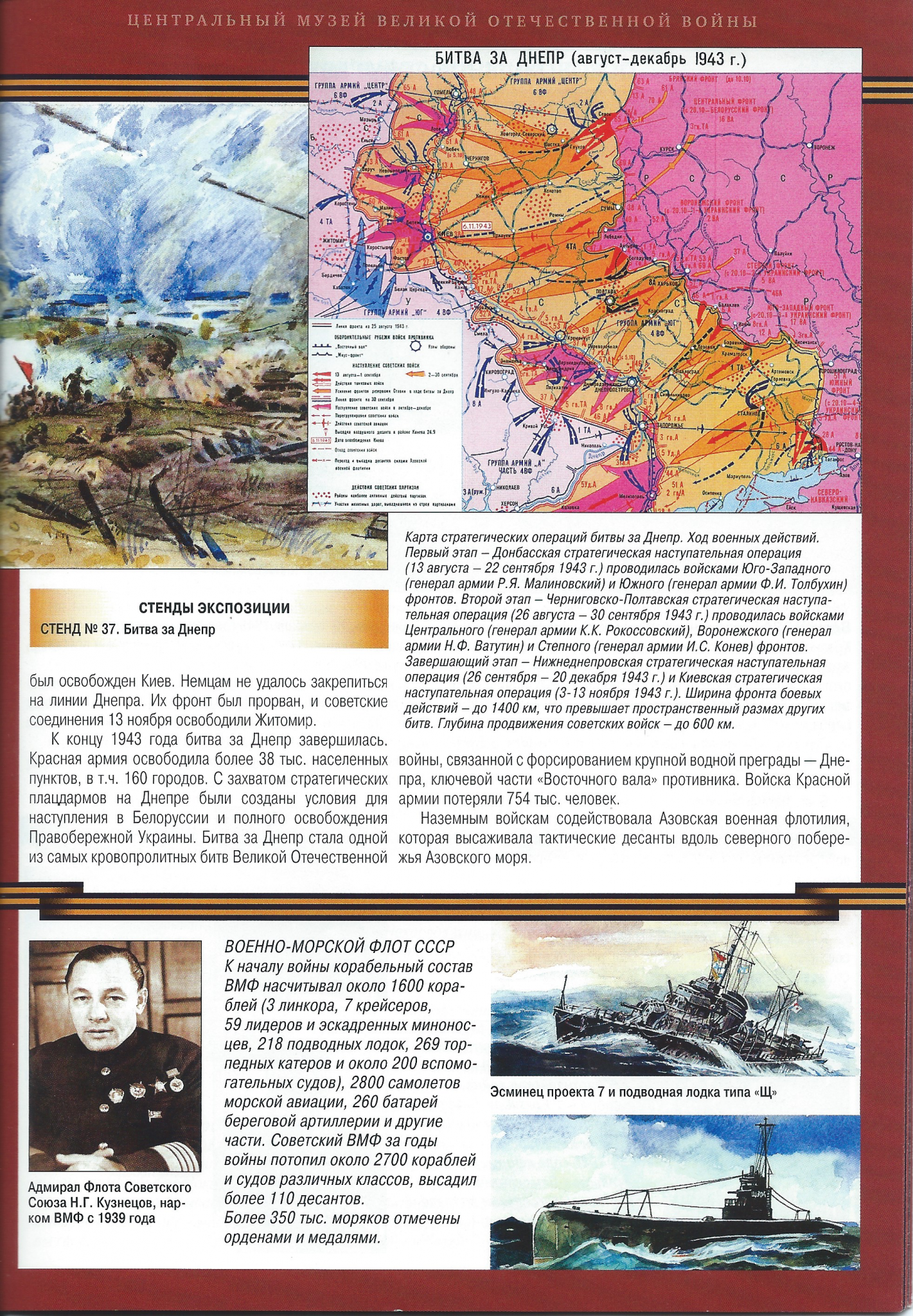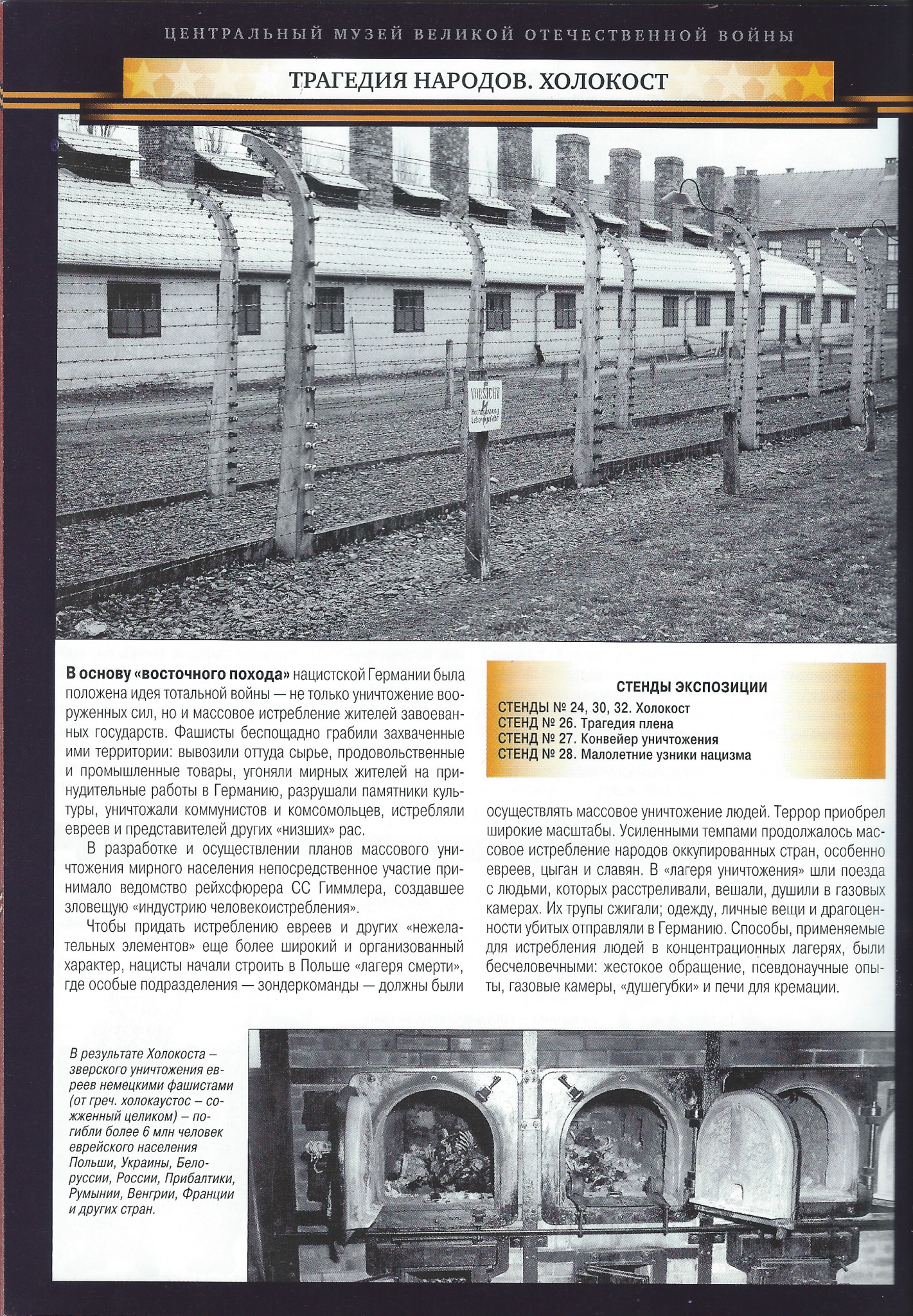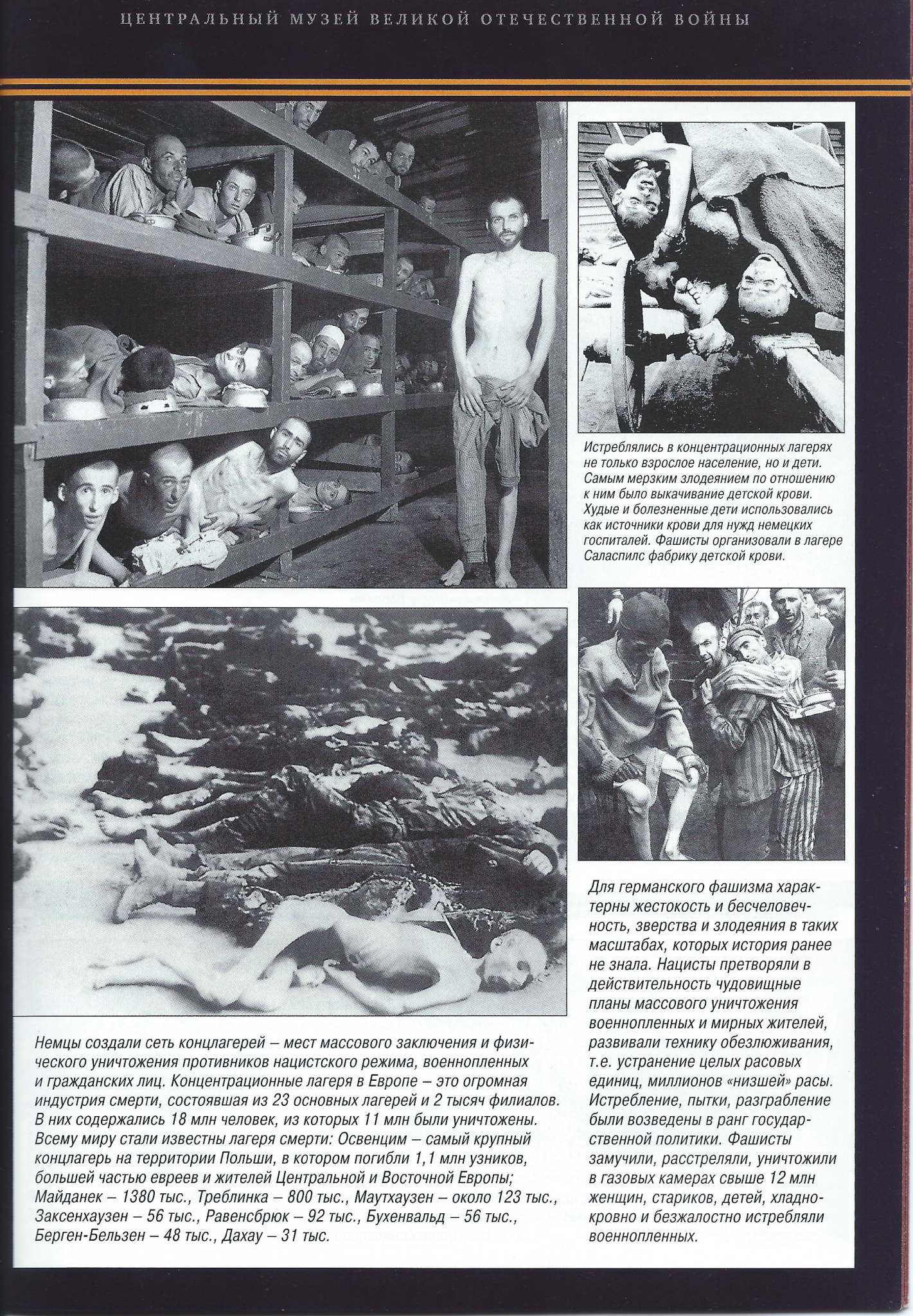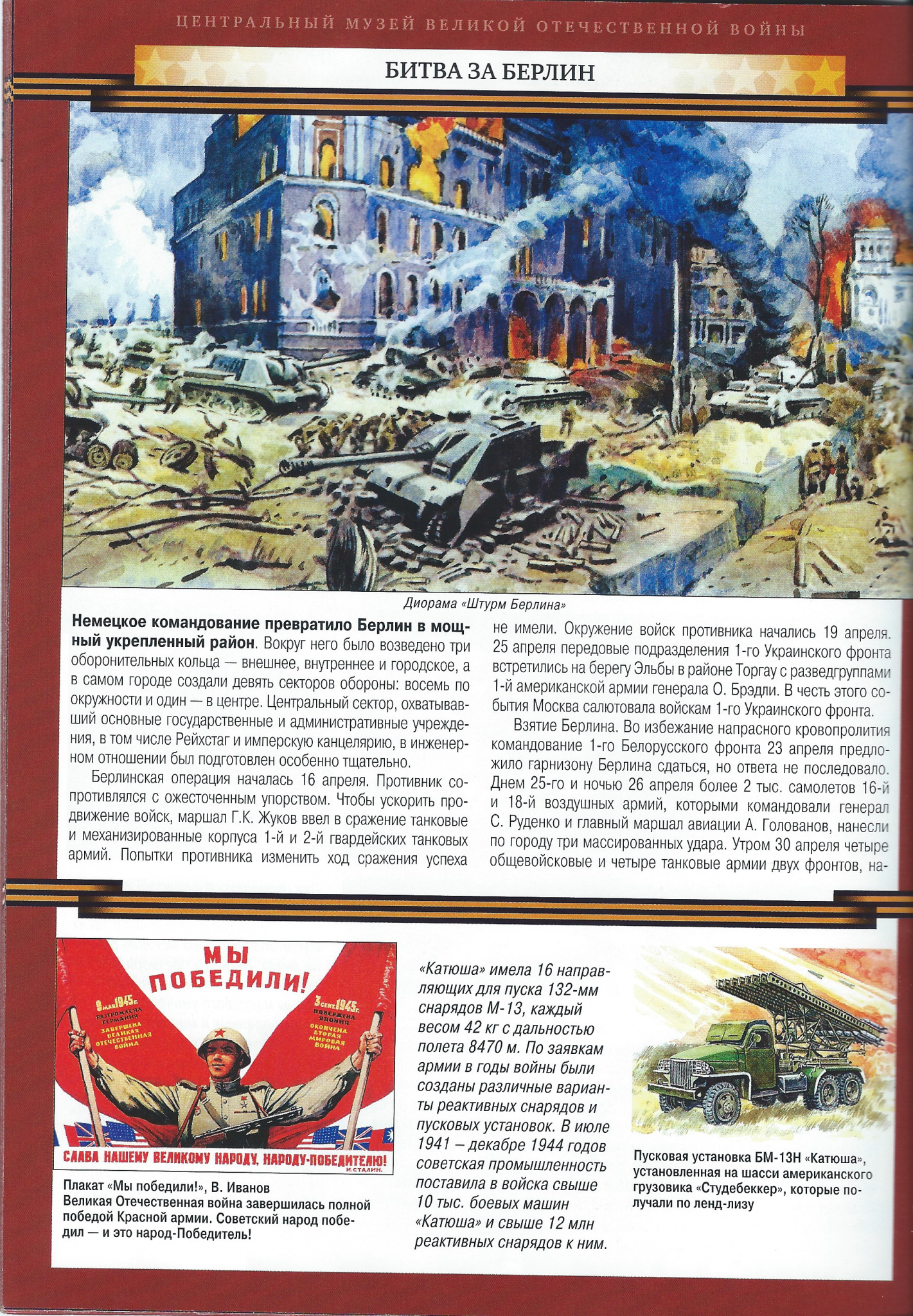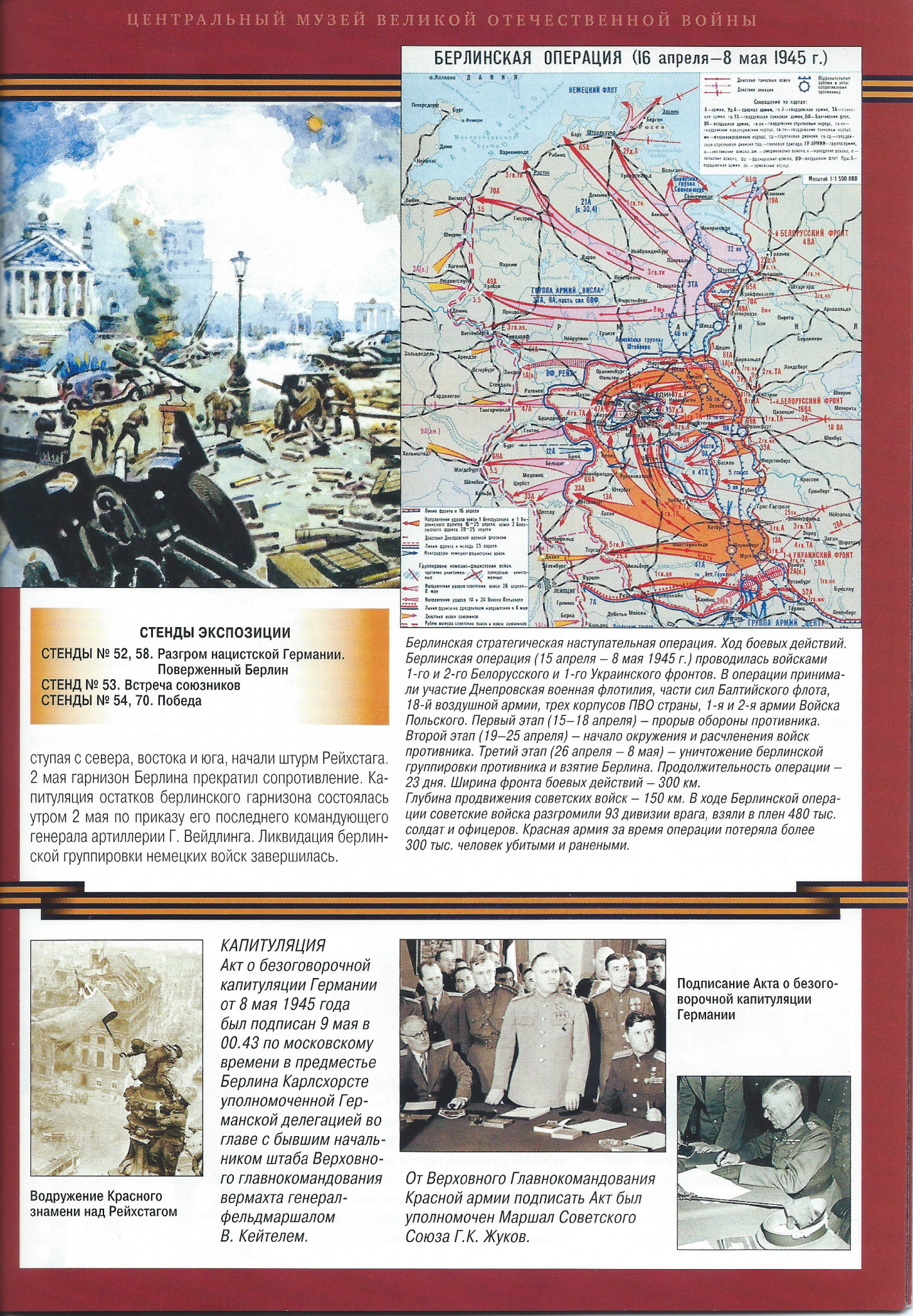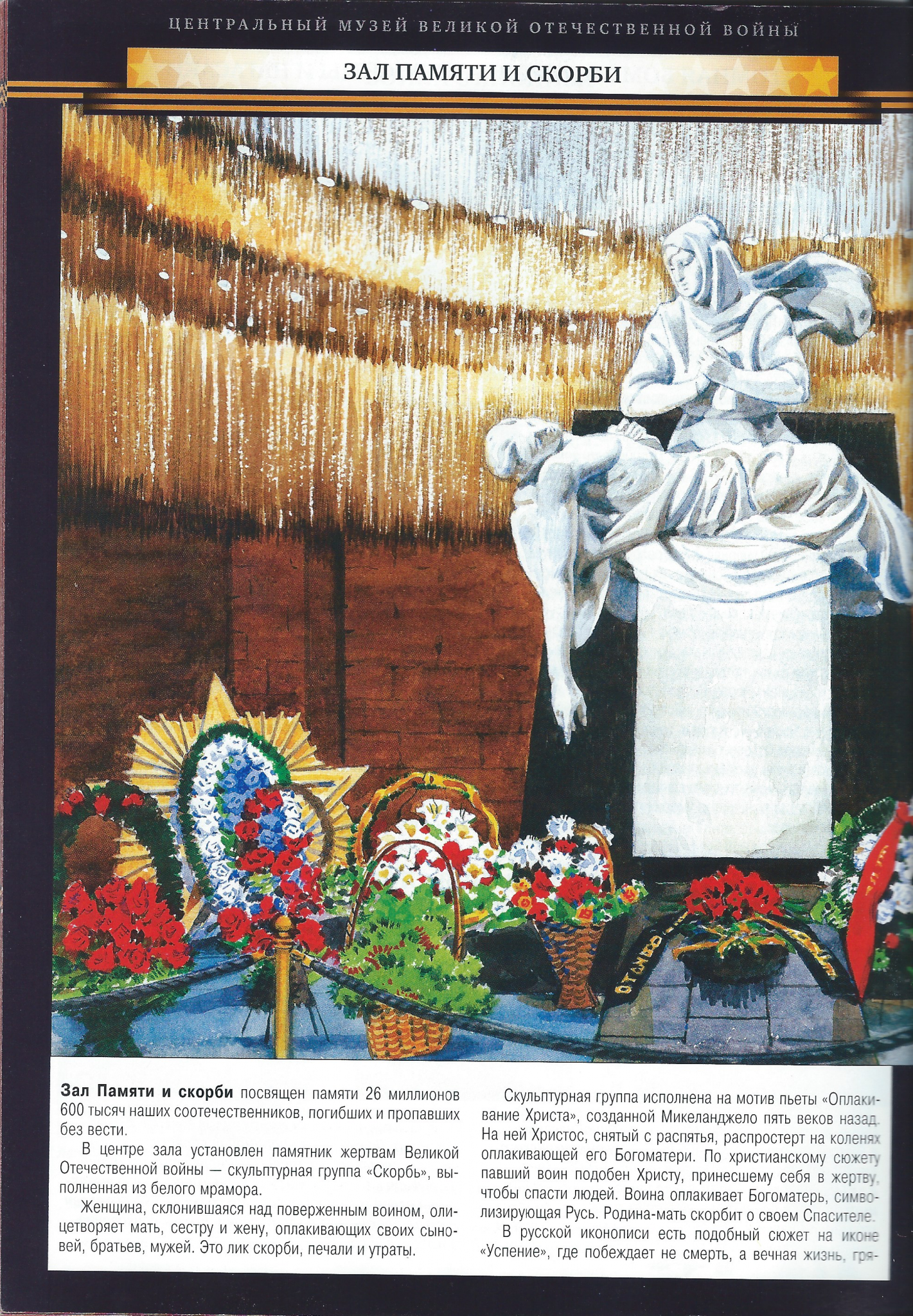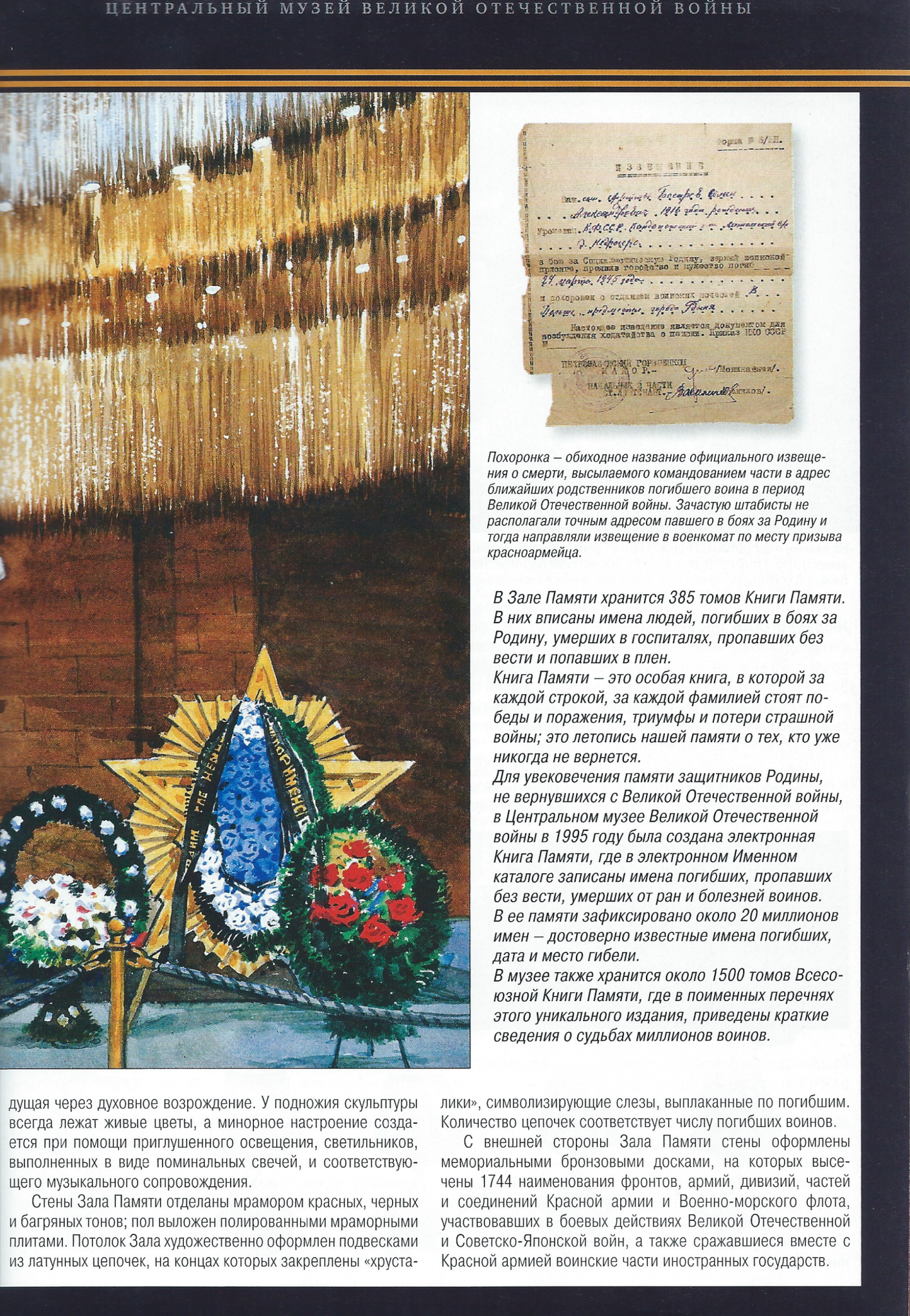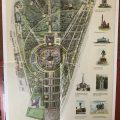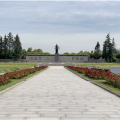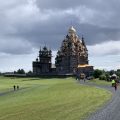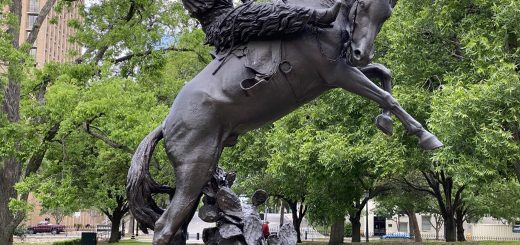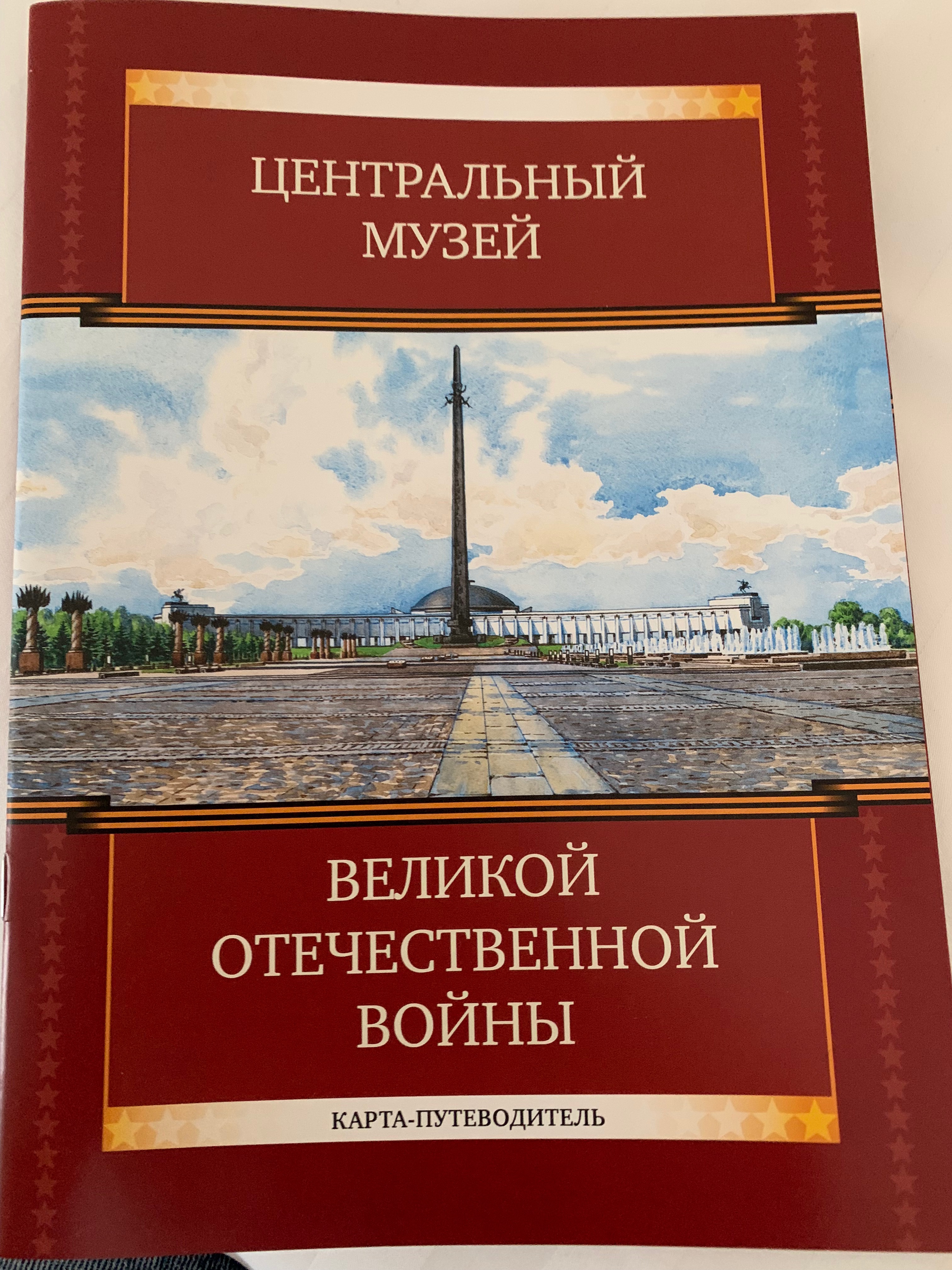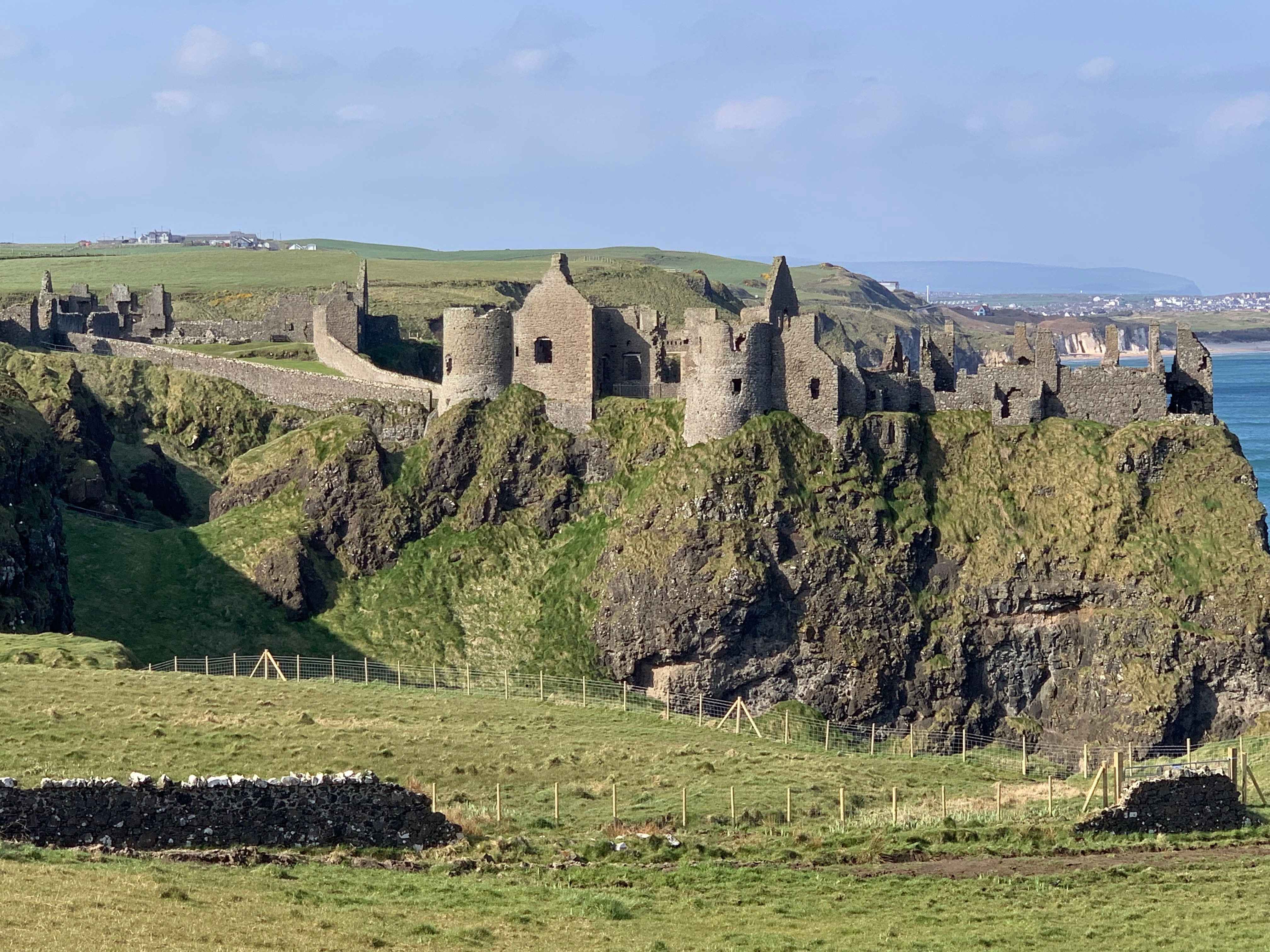Central Museum of the Great Patriotic War (ЦЕНТРАЛЬНЫЙ МУЗЕЙ ВЕЛИКОЙ ОТЕЧЕСТВЕННОЙ ВОЙНЫ) Map-Guide Translation from Russian to English
In July 2019 I had the privilege to visit Victory Park and the Museum of the Great Patriotic War in Moscow, Russia. Like many of the places in Russia there was little English translation; this included the lack of an English guide book. But the brochure that the museum had detailing the museum was very nicely done. I picked one up, determined to translate it with my really poor (almost non-existent) knowledge of the Russian language, World War II and the help of a good old-fashioned dictionary plus the Google Translate app.
I’ve visited World War II museums and memorials in the United States, Great Britain, France and now Russia. It is often enlightening to see the history from a different country’s perspective. Obviously the part of the war that U.S. historians focus on are the parts U.S. Armed Forces were engaged in. This map-guide offers a new perspective for me. There were so many battles on the Eastern Front in World War II that only the biggest ones (Stalingrad, the Siege of Leningrad, for example) are well know. The battle maps and descriptions herein described new places, battles, people and areas I had not before read about.
I’m working on an article about the museum and surrounding grounds using the photos we took during our visit. This (and education!) is the main motivation for this task. Because of the length of the translation of the guide – this article is already over 20,000 words – here is a separate post of the translation of the incredible fold-out map that was included in this map-guide.
Methodology
It has taken me a while to get around to this task. I would appreciated any input on the translations, by way of a comment at the end of this post.
The process is described below:
- Scanned each of the pages of the brochure (see the gallery below).
- Loaded each page as an image in the Google Translate app on an iPad.
- Copied the Russian and the translation into another app I use for notes, Notability.
- Compared the scanned text with what was in the brochure and adjusted. With the Google Translate app on the iPad, the words for which translation is desired are indicated by marking a passage with a finger. Often the order of the words in a paragraph are scrambled due to this method.
- A step had to be added to verify the order of the original Russian, fix the order, removed any hyphens (which appears to challenge Google translate) and then re-translate.
- The final results were then copied to this post.
- I then went back and read through the translations in context and made adjustments.
- Then, as always, my gorgeous wife read through this entire post (just the English!) and found inconsistencies which were then fixed.
I’ve attempted to contact the publisher of the brochure to gain their permission for this, but the website and contact information on the back of the brochure is no longer functional. I’m also reaching out to the museum to seek their permission for this effort. If anyone reading has a contact with the museum or the brochure publisher please let them know and leave a comment.
All of the images below were scanned at 300dpi. I’ve reduced the image size so that they will load reasonably fast. If you click on each image in the gallery it will em-bigg-en. The brochure itself is a work of art; instead of photos of the museum, there are drawings and sketches of its interior. And the verbiage tells a excellent story.
Inside front cover
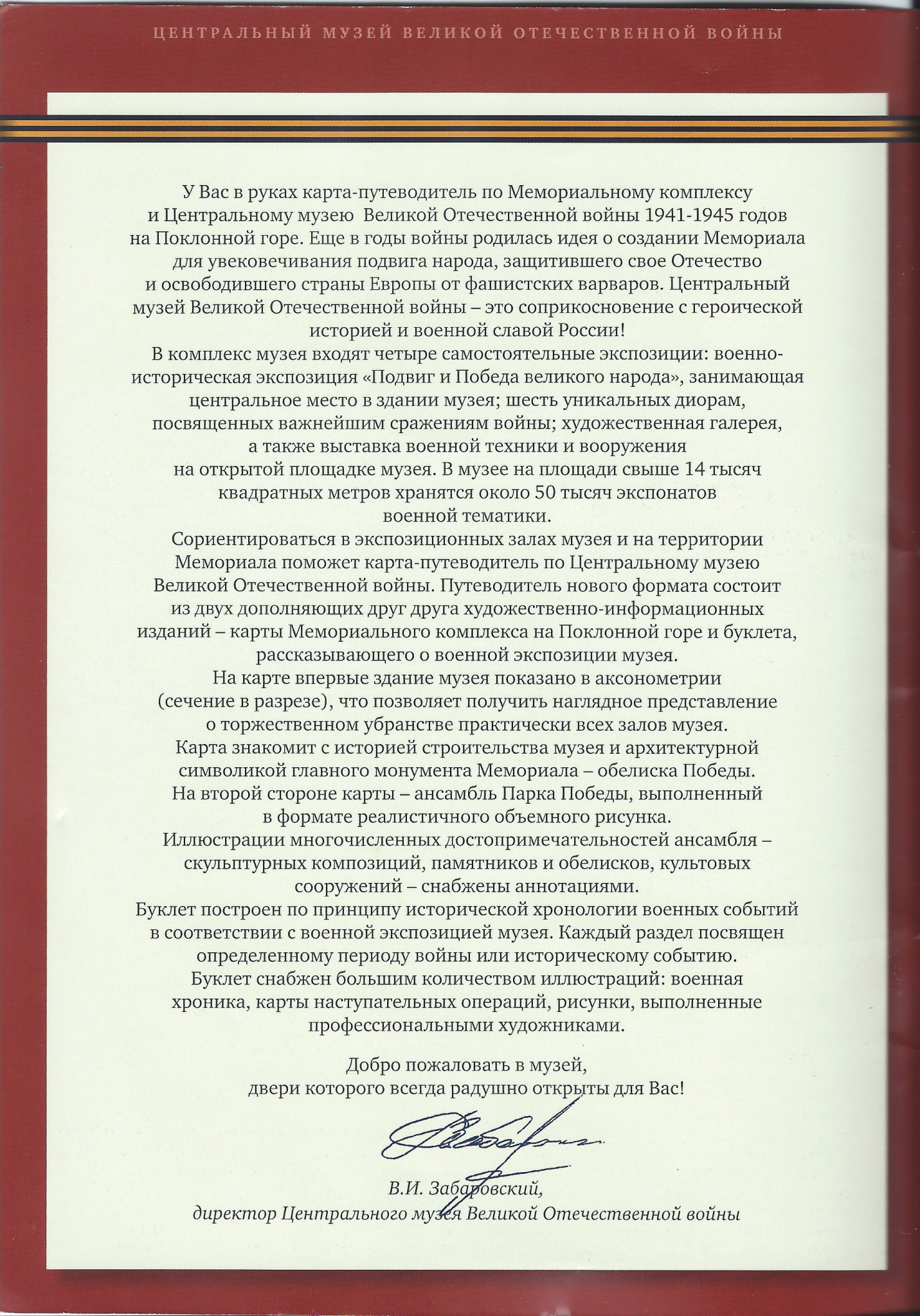
Original text: У Вас в руках карта-путеводитель по Мемориальному комплексу и Центральному музею Великой Отечественной войны 1941-1945 годов на Поклонной горе. Еще в годы войны родилась идея о создании Мемориала для увековечивания подвига народа, защитившего свое Отечество и освободившего страны Европы от фашистских варваров. Центральный музей Великой Отечественной войны — это соприкосновение с героической историей и военной славой России!
В комплекс музея входят четыре самостоятельные экспозиции: военно- историческая экспозиция «Подвиг и Победа великого народа», занимающая центральное место в здании музея; шесть уникальных диорам, посвященных важнейшим сражениям войны; художественная галерея, а также выставка военной техники и вооружения на открытой площадке музея. В музее на площади свыше 14 тысяч квадратных метров хранятся около 50 тысяч экспонатов военной тематики.
Сориентироваться в экспозиционных залах музея и на территории Мемориала поможет карта-путеводитель по Центральному музею Великой Отечественной войны. Путеводитель нового формата состоит из двух дополняющих друг друга художественно-информационных изданий карты Мемориального комплекса на Поклонной горе и буклета, рассказывающего о военной экспозиции музея. На карте впервые здание музея показано в аксонометрии (сечение в разрезе), что позволяет получить наглядное представление о торжественном убранстве практически всех залов музея. Карта знакомитс историей строительства музея и архитектурной символикой главного монумента Мемориала- обелиска Победы. На второй стороне карты ансамбль Парка Победы, выполненный в формате реалистичного объемного рисунка. Иллюстрации многочисленных достопримечательностей ансамбля скульптурных композиций, памятников и обелисков, культовых сооружений снабжены аннотациями.
Буклет построен по принципу исторической хронологии военных событий в соответствии с военной экспозицией музея. Каждый раздел посвящен определенному периоду войны или историческому событию. Буклет снабжен большим количеством иллюстраций: военная хроника, карты наступательных операций, рисунки, выполненные профессиональными художниками.
Добро пожаловать в музей, двери которого всегда радушно открыты для Вас!
В. И. Забаровский, директор Центрального музея Великой Отечественной войны
Translation: You are holding a map-guide for the Memorial complex and the Central Museum of the Great Patriotic War of 1941-1945 on Poklonnaya Hill. Even during the war years, the idea was born of creating a Memorial to perpetuate the feat of the people who defended their homeland and liberated the countries of Europe from fascist barbarians. The Central Museum of the Great Patriotic War is a touch with the heroic history and military glory of Russia!
The museum complex includes four independent expositions: the military-historical exposition “The Feat and Victory of the Great People”, which occupies a central place in the museum building; six unique dioramas dedicated to the most important battles of the war; an art gallery, as well as an exhibition of military equipment and weapons in the open area of the museum. The museum on an area of over 14 thousand square meters contains about 50 thousand exhibits of military subjects.
A guide map of the Central Museum of the Great Patriotic War will help you navigate in the exhibition halls of the museum and on the territory of the Memorial. The new format guidebook consists of two complementary art and information editions of the map of the Memorial complex on Poklonnaya Hill and a booklet telling about the museum’s military display. For the first time on a map, the museum building is shown in a perspective view (section in section), which allows you to get a visual representation of the ceremonial decoration of almost all the halls of the museum. The map introduces the history of the construction of the museum and the architectural symbols of the main monument of the Victory Obelisk Memorial. On the second side of the map is the Victory Park ensemble, made in the format of a realistic three-dimensional drawing. Illustrations of the numerous attractions of the ensemble of sculptural compositions, monuments and obelisks, places of worship are provided with annotations.
The booklet is built on the principle of historical chronology of military events in accordance with the military exhibition of the museum. Each section is dedicated to a specific period of the war or a historical event. The booklet is equipped with a large number of illustrations: a military chronicle, maps of offensive operations, drawings made by professional artists.
Welcome to the museum, whose doors are always warmly open for you!
V. I. Zabarovsky, Director of the Central Museum of the Great Patriotic War
Title: ПОКЛОННАЯ ГОРА — ИСТОРИЯ РУССКОЙ ПОБЕДЫ
Translation: WORSHIP MOUNTAIN – HISTORY OF THE RUSSIAN VICTORY

Original text: Исторически так сложилось, что Поклонная гора превратилась в знаковое место для всех поколений в дорогу Победы: в XVII веке над польскими интервентами, в XIX столетии над французской армией, а в XX над войсками гитлеровcкой коалиции.
Translation: Historically, Poklonnaya Gora turned into a symbolic place for all generations on the Victory Road: in the 17th century over the Polish invaders, in the 19th century over the French army, and in the 20th over the troops of the Hitler coalition.
Московская битва 1612 года. Осенью 1612 года у Поклонной горы расположился стан гетмана Ходкевича. Польское войско гетмана безуспешно пыталось прорваться Кремль и оказать содействие гарнизону польских интер- вентов, захвативших крепость. Главным военным событием битвы за Москву стал разгром войска Ходкевича отрядами народного ополчения под руководством князя Дмитрия По- жарского и Козымы Минина и освобождение Москвы от иноземных захватчиков. После этой победы освобождение Кремля оставалось лишь делом времени. Оккупанты еще два месяца удерживали Московский Кремль и начали сдаваться только в октябре. Окончательно Кремль был взят 4 ноября 1612 года. Эта победа стала началом возрождения Отече- ства, пережившего страшные годы Смутного времени. Русь снова стала независимой и самодержавной.
The battle of Moscow in 1612. In the fall of 1612, the camp of Hetman Khodkevich was located at Poklonnaya Gora. The Polish army of the hetman unsuccessfully tried to break through the Kremlin and assist the garrison of Polish interventionists who had seized the fortress. The main military event of the battle for Moscow was the defeat of Khodkevich’s troops by militias led by Prince Dmitry Pogarsky and Kozym Minin and the liberation of Moscow from foreign invaders. After this victory, the liberation of the Kremlin was only a matter of time. The occupiers held the Moscow Kremlin for another two months and began to surrender only in October. The Kremlin was finally taken on November 4, 1612. This victory was the beginning of the revival of the Fatherland, which survived the terrible years of the Time of Troubles. Russia again became independent and autocratic.
Отечественная война 1812 года. В 1812 году у Поклонной горы остановилась русская армия, отступавшая после Бородинского сражения. Фельдмаршал Кутузов с генералами смотрел отсюда на Москву. Неподалеку от Поклонной горы в деревне Фили Кутузов собрал военный совет, на котором было принято окончательное решение о том, что Москву необходимо отдать французским войскам. Несколько дней спустя на Поклонную гору поднялся император Франции. Зная о том, что именно на Поклонной горе встречали важных лиц и иностранных послов, Наполеон ждал там ключей от Кремля. Но его ожидания оказались тщетными. Война 1812 года закончилась победой русской армии, и император Александр I с триумфом въехал в Париж.
Patriotic War of 1812. In 1812, the Russian army stopped at Poklonnaya Gora, retreating after the battle of Borodino. Field Marshal Kutuzov with generals looked from here to Moscow. Not far from Poklonnaya Gora in the village of Fili Kutuzov gathered a military council, at which the final decision was made that Moscow should be surrendered to the French troops. A few days later, the emperor of France climbed Poklonnaya Gora. Knowing that it was on Poklonnaya Hill that important people and foreign ambassadors were met, Napoleon was waiting for the keys to the Kremlin there. But his expectations were in vain. The war of 1812 ended with the victory of the Russian army, and Emperor Alexander I triumphantly entered Paris.
Великая Отечественная Война 1941—1945 года.
По Смоленской дороге мимо Поклонной горы на запад шли на фронт солдаты. Долгих и страшных четыре года вся страна ждала победы. В ознаменование разгрома фашистских агрессоров и всемирно-исторической победы советского народа в Великой Отечественной войне было решено соорудить на Поклонной горе величественный памятник-монумент
The Great Patriotic War of 1941-1945.
On the Smolensk road past Poklonnaya Gora to the west went the soldiers to the front. For four long and terrible years, the whole country was waiting for victory. In commemoration of the defeat of the fascist aggressors and the world-historic victory of the Soviet people in the Great Patriotic War, it was decided to erect a majestic monument on Poklonnaya Hill.
Image Captions
Изгнание польских интервентов из Московского Кремля. Э. Лисснер
The expulsion of Polish interventionists from the Moscow Kremlin. E. Lissner
Наполеон на Поклонной горе ожидает депутацию. В. Верещагин
Napoleon on Poklonnaya Hill awaits deputation. V. Vereshchagin
Ополченцы. Москва, 1941 год
Militias. Moscow, 1941
Title: ЗАЛ ПОЛКОВОДЦЕВ
Translation: HALL OF THE LEADERS

Original text: Зал Полководцев открывает экспозицию музея. Здесь представлена галерея кавалеров ордена Победы, которым награждались лица высшего командного состава за успешное проведение боевых операций в масштабе одного или нескольких фронтов, в результате которых в корне менялась обстановка в пользу Красной армии.
Орденом Победы награждены: Генералиссимус Советского Союза И.В. Сталин (дважды), маршалы Советского Союза Г.К. Жуков (дважды), А.М. Василевский (дважды,) Л.А. Гово- ров, И.С. Конев, Р.Я. Малиновский, КА. Мерецков, К.К. Рокоссовский, С.К. Тимошенко, ФИ. Толбухин, генерал армии А.И. Антонов. За вклад в общую победу над фашизмом высшим военным орденом Победы были награждены и пять иностранных военачальников: генерал армии США Дуайт Дэйвид Эйзенхауэр, фельдмаршал Великобритании Бернард Лоу Монттомери, король Румынии Михай I, маршал Польши Михал Роля-Жимерский, маршал Югoславии Иосип Броз Тито.
Бронзовые бюсты советских кавалеров ордена Победы и выдающихся полководцев России установлены по периметру Зала Полководцев.
Translation: The Hall of the Leaders opens the museum. Here is a gallery of Knights of the Order of Victory, which was awarded to persons of high command for the successful conduct of military operations on the scale of one or more fronts, as a result of which the situation changed radically in favor of the Red Army.
The Order of Victory was awarded to: Generalissimo of the Soviet Union I.V. Stalin (twice), Marshals of the Soviet Union G.K. Zhukov (twice), A.M. Vasilevsky (twice) L.A. Govorov, I.S. Konev, R.Ya. Malinovsky, KA. Meretskov, K.K. Rokossovsky, S.K. Tymoshenko, FI. Tolbukhin, Army General A.I. Antonov. Five foreign military leaders were awarded the highest military order of Victory for their contribution to the overall victory over fascism: U.S. Army General Dwight David Eisenhower, Field Marshal of Great Britain Bernard Low Montgomery, King of Romania Mihai I, Marshal of Poland Michal Role-Jimersky, Marshal of Yugoslavia, Tzar Josrozito.
Bronze busts of Soviet cavaliers of the Order of Victory and prominent Russian commanders are installed around the perimeter of the General’s Hall.
Идея преемственности армий, поколений и воинской славы России нашла свое отражение в том, что в Зале Полководцев размещены штандарты русских дружин, знамена героических полков Русской армии и соединений Красной армии. На стилизованных геральдических щитах изображены русские и советские военные ордена. Почетное место среди воинских знаков отличия заняла Георгиевская лента, появившаяся в Российской империи в 1769 году вместе с Георгиевским крестом. В 1943 году она стала частью ордена Славы, которым награждались воины за личный подвиг на поле боя.
The idea of the continuity of the armies, generations and military glory of Russia was reflected in the fact that in the Hall of Regiments there were placed the standards of Russian squads, the banners of the heroic regiments of the Russian army and the Red Army formations. The stylized heraldic shields depict Russian and Soviet military orders. The place of honor among the military insignia was occupied by the St. George ribbon, which appeared in the Russian Empire in 1769 along with the St. George Cross. In 1943, it became part of the Order of Glory, which soldiers were awarded for their personal feats on the battlefield.
Image captions
Original text: Штандарт Дмитрия Донского
Translation: The standard of Dmitry Donskoy
Знамя Лейб-гвардии Гренадерского полка, 1860 год
Banner of the Life Guards Grenadier Regiment, 1860
Ротное знамя Лейб-гвардии Семеновского полка, 1701 год
Company banner of the Life Guards of the Semenovsky Regiment, 1701
Знамя 3-й гвардейской армии, 1943 год
Banner of the 3rd Guards Army, 1943
Caption under first statue – original text: Генералиссимус А.В. Суворов — великий русский полководец, не потерпевший ни одного поражения
Generalissimus A.V. Suvorov – the great Russian commander who did not suffer a single defeat
Caption under second statue – original text: Маршал Советского Союза Г.К. Жуков- четырежды Герой Советского Союза, кавалер двух орденов Победы
Marshal of the Soviet Union G.K. Zhukov – four times Hero of the Soviet Union, holder of two orders of Victory
TITLE: ПАРАДНАЯ ЛЕСТНИЦА
Translation: MAIN STAIRCASE

Original text: В центре Парадной лестницы, ведущей к величественному Залу Славы, расположено художественно-декоративное панно «Солдатская дорога Славы». Панно выполнено из цветного металла. Его обрамляют перемежающиеся ветви дуба и лавра, символизирующие стойкость воинов и славу русского оружия. Лавровая ветвь с древних времен считается символом Победы и почетной наградой за беспримерный подвиг.
На верхней площадке Парадной лестницы, перед Залом Славы, находится художественно-декоративная композиция «Щит и меч Победы». Декоративные щит, меч и ножны подарены музею Правительством Российской Федерации к 50-летию Победы. Изделия художественно оформлены в технике гравировки, чеканки, никелирования, золочения и др. Меч выполнен из знаменитой златоустовской стали. Композиция богато украшена цветными металлами: бронзой, латунью, никелем, золотом и драгоценными камнями: топазами, кварцами, турмалинами, гранатами, бериллами, аквамаринами, цитринами.
Translation: In the center of the Main Staircase leading to the majestic Hall of Fame, there is an art-decorative panel “The Soldier’s Road of Glory”. The panel is made of non-ferrous metal. It is framed by alternating branches of oak and laurel, symbolizing the staunchness of warriors and the glory of Russian weapons. Since ancient times, the laurel branch is considered a symbol of Victory and an honorary award for an unprecedented feat.
On the upper platform of the Main Staircase, in front of the Hall of Fame, there is an artistic and decorative composition “The Shield and Sword of Victory”. The decorative shield, sword and scabbard were donated to the museum by the Government of the Russian Federation on the occasion of the 50th anniversary of the Victory. The products are artistically decorated using the technique of engraving, coinage, nickel plating, gilding, etc. The sword is made of the famous Zlatoust steel. The composition is richly decorated with non-ferrous metals: bronze, brass, nickel, gold and precious stones: topazes, quartz, tourmaline, garnet, beryl, aquamarine, citrine.
Photo captions
Панно «Солдатская дорога Славы» украшено символиче-скими макетами оружия, солдатских касок, изображениями фрагментов сражений войны
The “Soldier’s Glory Road” panel is decorated with symbolic mock-ups of weapons, soldier’s helmets, and images of fragments of war battles
Светильники в форме поминальных свечей, установленные вдоль панно, напоминают о погибших защитниках Отечества
Lamps in the shape of funeral candles installed along the panel remind of the dead defenders of the Fatherland
Художественная композиция «Щит и меч Победы». На щите надлись: «Россияне, не уроним чести, и плечом к плечу сомкнемся впредь, выстоять дано нам только вместе, порознь — только умереть»
The art composition “The Shield and Sword of Victory”. On the shield: “The Russians, we will not drop the honor, and shoulder to shoulder we will continue to close, it is given to us to survive only together, separately – only to die”
Note: Some pages in the pamphlet are best viewed with two facing pages side by side. For these the entire translation follows the two page images.
TITLE: ЗАЛ СЛАВЫ
Translation: HALL OF FAME
Торжественный портал ведет по парадной лестнице в Зал Славы —месту почитания и выражения глубокой благодарности участникам войны, партизанам и подлольщикам, труженикам тыла, всему народу. Это центральный зал музея, где увековечены имена тех, кто удостоен самой высокой военной награды. Имена более 11 800 Героев Советского Союза и Героев Российской Федерации золотом высечены на 72 белоснежных мраморных пилонах, установленных по периметру Зала Славы.
В годы войны тысячи солдат и офицеров обессмертили свои имена при обороне Брестской крепости, Одессы, Севастополя, Киева, Ленинграда, Новороссийска, в битве под Москвой, Сталинградом, Курском, на Днепре, при штурме Берлина и в других сражениях.
Уже 8 июля 1941 года по радио был передан первый с начала войны Указ Президиума Верховного Совета СССР о присва ении звания Героя Советского Союза летчикам М.П. Жукову СИ. Здоровцеву и П.Т. Харитонову, протаранившим фашистские самолеты на подступах к Ленинграду.
Два человека удостоены этого звания трижды – это Герои Советского Союза И.Н. Кожедуб и А.И. Покрышкин, а Г. К. Жуков — четырежды. В центре зала возвышается 10-метрова бронзовая скульптура «Солдат Победы». Поднятой рукой воингерой провозглашает Победу и Мир, одновременно предупреждая о неминуемой каре всякого врага, осмелившегося посягнуть на его Родину.
У его подножья на гранитном постаменте покоится ме символизирующий изречение Александра Невского: «Кто к нам с мечом придет, тот от меча и погибнет!» Над мраморными пилонами расположены барельефы двенадцати городов-героев, удостоенных этого звания за беспримерную оборону и подвиги народного ополчения: Ленинград, Севастополь, Волгоград, Одесса, Киев, Москва, Керчь, Новороссийск, Минск, Тула, Мурманск, Смоленск. Стойкостью своих защитников прославилась Брестская крепость, которой присвоено звание «Брестская крепость-герой». На барельефах высечены тексты Указов о присвоении почетных званий городам-героям.
Купол Зала Славы обрамляет лавровый венок, символизирующий торжество Победы за справедливое дело и вклад в Победу всех народов Советского Союза.
На высоте 25 метров свод купола венчает красочная пятиконечная звезда —стилизованный орден Победы – высший военный орден Советского Союза.
The ceremonial portal leads up the grand staircase to the Hall of Fame — a place of veneration and expression of deep gratitude to the war veterans, partisans and vile-hunters, home front workers, and the entire people. This is the central hall of the museum, where the names of those who are awarded the highest military award are immortalized. The names of more than 11,800 Heroes of the Soviet Union and Heroes of the Russian Federation are carved in gold on 72 snow-white marble pylons installed around the perimeter of the Hall of Glory.
During the war, thousands of soldiers and officers immortalized their names during the defense of the Brest Fortress, Odessa, Sevastopol, Kiev, Leningrad, Novorossiysk, in the battle of Moscow, Stalingrad, Kursk, on the Dnieper, during the storming of Berlin and in other battles.
As early as July 8, 1941, the first decree of the Presidium of the Supreme Soviet of the USSR on awarding the rank of Hero of the Soviet Union to pilots M.P. Zhukov SI. Zdorovtseva and P.T. Kharitonov, rammed fascist aircraft on the outskirts of Leningrad.
Two people were awarded this title three times – these are Heroes of the Soviet Union I.N. Kozhedub and A.I. Pokryshkin, and G.K. Zhukov – four times. In the center of the hall stands a 10-meter bronze sculpture “Victory Soldier”. With a raised hand, the waringer proclaims Victory and Peace, while warning about the imminent punishment of any enemy who dared to encroach on his Homeland.
At its foot on a granite pedestal rests a symbolizing dictum of Alexander Nevsky: “Whoever comes to us with a sword will die by the sword!” Above the marble pylons are bas-reliefs of twelve hero cities awarded this title for unparalleled defense and feats of the people’s militia: Leningrad, Sevastopol, Volgograd, Odessa, Kiev, Moscow, Kerch, Novorossiysk, Minsk, Tula, Murmansk, Smolensk. The fortitude of its defenders became famous Brest Fortress, which was awarded the title “Brest Hero Fortress.” On the bas-reliefs the texts of Decrees on the awarding of honorary titles to heroic cities are carved.
The dome of the Hall of Fame is framed by a laurel wreath, symbolizing the triumph of Victory for a just cause and contribution to the victory of all the peoples of the Soviet Union.
At a height of 25 meters, the dome of the dome is crowned with a colorful five-pointed star — the stylized Order of Victory — the highest military order of the Soviet Union.
Image captions
Барельеф города-героя Смоленска
Bas-relief of the hero city of Smolensk
Орден Победы – высший военный орден СССР, учрежденный Указом Президиума Верховного Совета СССР от 8 ноября 1943 года. Согласно статуту орденом Победы мог награждаться только высший командный состав за успешное прове- дение боевых операций в масштабе нескольких или одного фронта, в результате которых в корне менялась обстановка в пользу Красной армии. Первое награждение состоялось 10 апреля 1944 года. Обладателем ордена No 1 стал командующий 1-м Украинским фронтом Маршал Советского Союза Г.К. Жуков. Орден No 2 получил начальник Генерального штаба Маршал Советско- Го Союза А.М. Василевский. Орденом Победы No 3 был награжден Верховный Главнокомандующий Маршал Советского Союза И.В. Сталин. Все они отмечены этой наградой за освобождение Правобережной Украины.
Знак ордена изготовлен из платины и представляет собой пятиконечную рубиновую звезду, окаймленную бриллиантами. В центре звезды золотое изображение кремлевской стены с Мавзолеем Ленина и Спасской башней.
The Order of Victory is the highest military order of the USSR, established by Decree of the Presidium of the Supreme Council of the USSR of November 8, 1943. According to the statute, only the highest command staff could be awarded the Order of Victory for the successful conduct of military operations on the scale of several or one front, as a result of which the situation changed radically in favor of the Red Army. The first award took place on April 10, 1944. The holder of the Order No. 1 was the commander of the 1st Ukrainian Front, Marshal of the Soviet Union G.K. Zhukov. Order No. 2 was received by the head of the General Staff, Marshal of the Soviet Union, A. Vasilevsky. The Order of Victory No. 3 was awarded to the Supreme Commander-in-Chief Marshal of the Soviet Union I.V. Stalin. All of them are marked with this award for the liberation of Right-Bank Ukraine.
The badge of the order is made of platinum and is a five-pointed ruby star, bordered with diamonds. In the center of the star is a golden image of the Kremlin wall with the Lenin Mausoleum and the Spasskaya Tower.
Title: ВТОРЖЕНИЕ
Translation: INVASION
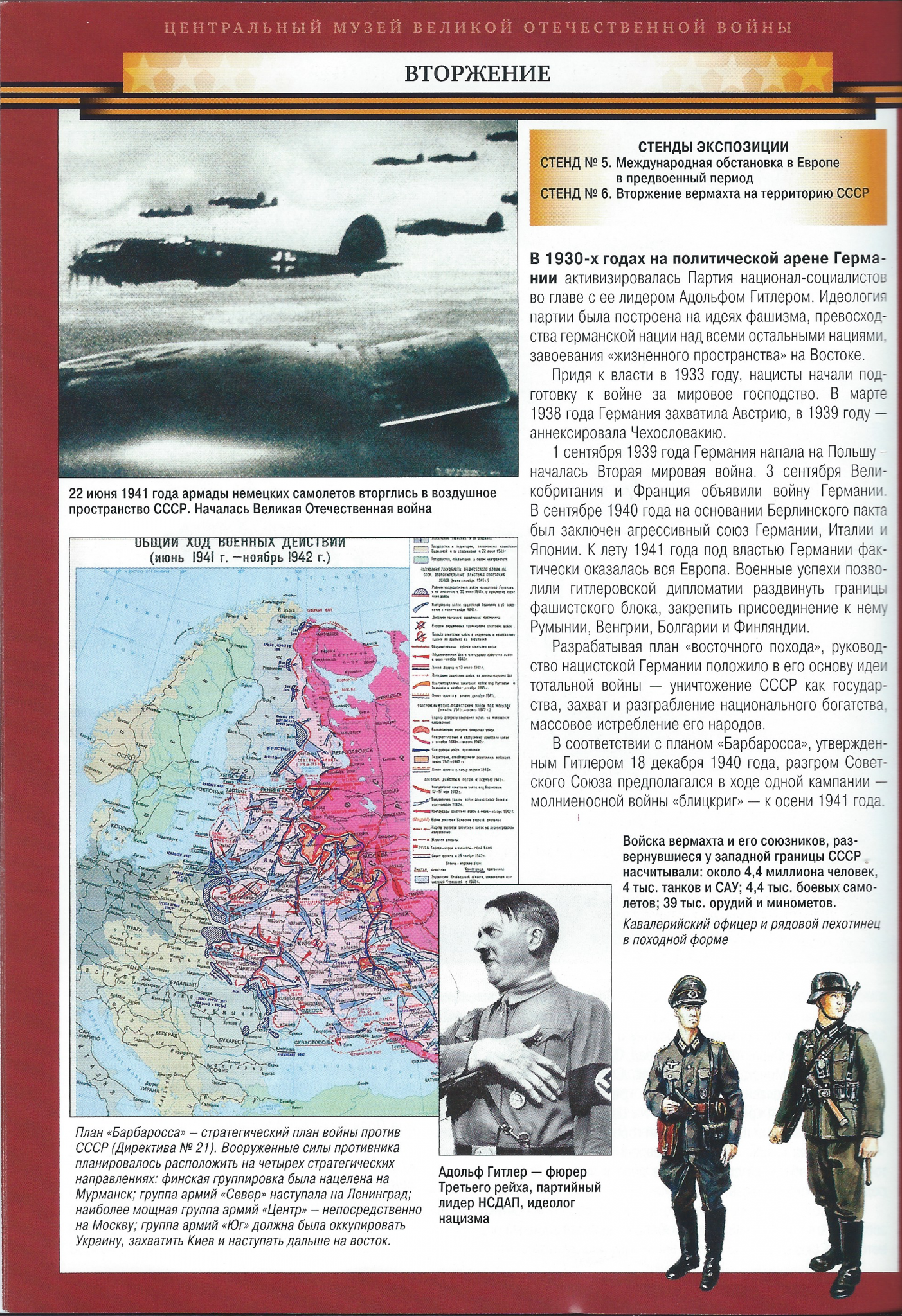
В 1930-х годах на политической арене Герма- нии активизировалась Партия национал-социалистов во главе с ее лидером Адольфом Гитлером. Идеология партии была построена на идеях фашизма, превосход- ства германской нации над всеми остальными нациями, завоевания «жизненного пространства» на Востоке.
Придя к власти в 1933 году, нацисты начали под- готовку к войне за мировое господство. В марте 1938 года Германия захватила Австрию, в 1939 году аннексировала Чехословакию.
1 сентября 1939 года Германия напала на Польшу – началась Вторая мировая война. 3 сентября Вели- кобритания и Франция объявили войну Германии. В сентябре 1940 года на основании Берлинского пакта был заключен агрессивный союз Германии, Италии и Японии. К лету 1941 года под властью Германии фак- тически оказалась вся Европа. Военные успехи позво- лили гитлеровской дипломатии раздвинуть границы фашистского блока, закрепить присоединение к нему Румынии, Венгрии, Болгарии и Финляндии.
Разрабатывая план «восточного похода», руковод- СТво нацистской Германии положило в его основу идеи тотальной войны-уничтожение СССР как государ- ства, захват и разграбление национального богатства, массовое истребление его народов.
В соответствии с планом «Барбаросса», утвержден- ным Гитлером 18 декабря 1940 года, разгром Советского Союза предполагался в ходе одной кампании молниеносной войны «блицкриг» — к осени 1941 года.
In the 1930s, the National Socialist Party, led by its leader Adolf Hitler, intensified in the political arena of Germany. The ideology of the party was built on the ideas of fascism, the superiority of the German nation over all other nations, and the conquest of “living space” in the East.
Having come to power in 1933, the Nazis began preparations for a war for world domination. In March 1938, Germany invaded Austria, in 1939 annexed Czechoslovakia.
September 1, 1939 Germany attacked Poland – the Second World War began. On September 3, Great Britain and France declared war on Germany. In September 1940, an aggressive alliance of Germany, Italy and Japan was concluded on the basis of the Berlin Pact. By the summer of 1941, virtually all of Europe was under German rule. Military successes allowed Hitler’s diplomacy to push the boundaries of the fascist bloc and secure the accession of Romania, Hungary, Bulgaria and Finland.
In developing the plan for the “Eastern campaign,” the leadership of Nazi Germany laid the foundation for the idea of total war — the destruction of the USSR as a state, the capture and plunder of national wealth, and the mass extermination of its peoples.
In accordance with the Barbarossa plan, approved by Hitler on December 18, 1940, the defeat of the Soviet Union was assumed in the course of one blitzkrieg campaign — by the fall of 1941.
СТЕНДЫ ЭКспозиции
СТЕНД No 5. Mеждународная обстановка в Европе в предвоенный период
СТЕНД No 6. Вторжение вермахта на территорию СССР
EXPOSITION STANDS
STAND No 5. The international situation in Europe in the pre-war period
STAND No 6. Wehrmacht invasion of the USSR
Map Title
ОБЩИИ ХUд ВОUEHНЫХ ДЕЙСТВИИ (июнь 1941 г. —ноябрь 1942 г.)
GENERAL UNDER THE UNIVERSAL ACTION (June 1941 — November 1942)
Map Caption
План «Барбаросса» стратегический план войны против СССР (Директива N 21). Вооруженные силы противника планировалось расположить на четырех стратегических направлениях: финская груплировка была нацелена на Мурманск;B групла армий «Север» наступала на Ленинград; наиболее мощная групла армий «Центр»-непосредственно на Москву; групла армий «Юг» должна была оккупировать Украину, захватить Киев и наступать дальше на восток.
Plan “Barbarossa” strategic plan of the war against the USSR (Directive No. 21). The enemy’s armed forces were planned to be deployed in four strategic directions: the Finnish grouping was aimed at Murmansk, the army group “North” attacked Leningrad; the most powerful army group “Center” – directly to Moscow; Army Group “South” was supposed to occupy Ukraine, capture Kiev and advance further east.
Image Captions
22 июня 1941 года армады немецких самолетов вторглись в воздушное пространство СССР. Началась Великая Отечественная война
June 22, 1941 the armada of German aircraft invaded the airspace of the USSR. The Great Patriotic War
Адольф Гитлер—фюрер Третьего рейха, партийный лидер НСДАП, идеолог нацизма
Adolf Hitler — Fuhrer of the Third Reich, party leader of the Nazi Party, ideologist of Nazism
Войска вермахта и его союзников, раз- вернувшиеся у западной границы СССР насчитывали: около 4,4 миллиона человек, 4 тыс. танков и САУ; 4,4 тыс. боевых само- летов; 39 тыс. орудий и минометов.
The troops of the Wehrmacht and its allies, deployed near the western border of the USSR, totaled: about 4.4 million people, 4 thousand tanks and self-propelled guns; 4.4 thousand combat aircraft; 39 thousand guns and mortars.
Кавалерийский офицер и рядовой пехотинец в походной форме
Cavalry officer and soldier in uniform
Title: ПРИГРАНИЧНЫЕ СРАЖЕНИЯ
Translation: BORDER BATTLES
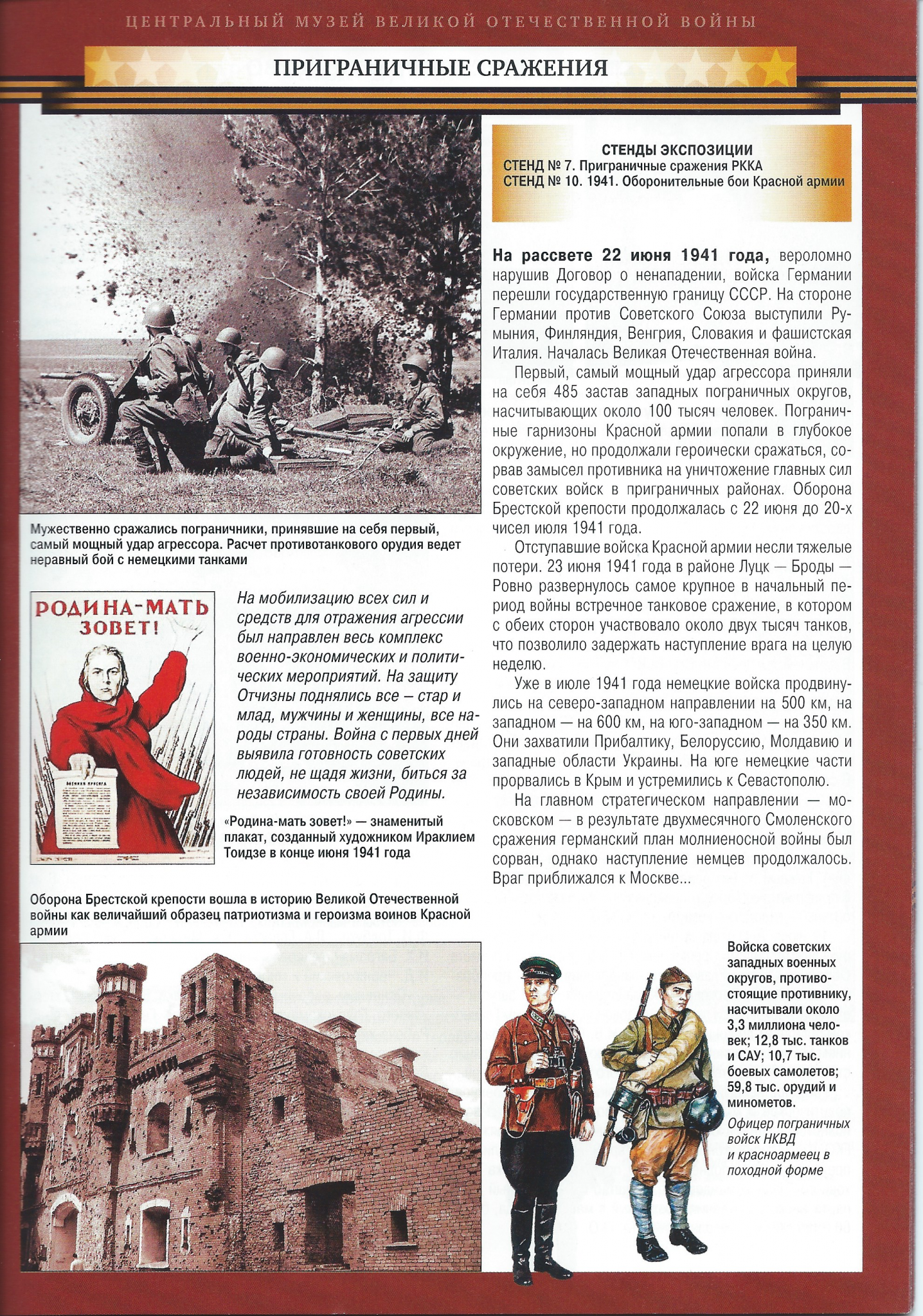
На рассвете 22 июня 1941 года, вероломно нарушив Договор о ненападении, войска Германии перешли государственную границу СССР. На стороне Германии против Советского Союза выступили Румыния, Финляндия, Венгрия, Словакия и фашистская Италия. Началась Великая Отечественная война.
Первый, самый мощный удар агрессора приняли на себя 485 застав западных пограничных округов, насчитывающих около 100 тысяч человек. Пограничные гарнизоны Красной армии попали в глубокое окружение, но продолжали героически сражаться, сорвав замысел противника на уничтожение главных сил советских войск в приграничных районах. Оборона Брестской крепости продолжалась с 22 июня до 20-х чисел июля 1941 года.
Отступавшие войска Красной армии несли тяжелые потери. 23 июня 1941 года в районе Луцк— Броды Ровно развернулось самое крупное в начальный период войны встречное танковое сражение, в котором с обеих сторон участвовало около двух тысяч танков, что позволило задержать наступление врага на целую Они захватили Прибалтику, Белоруссию, Молдавию и неделю.
Уже в июле 1941 года немецкие войска продвину- лись на северо-западном направлении на 500 км, на западном на 600км, на юго-западном— на 350 км. западные области Украины. На юге немецкие части прорвались в Крым и устремились к Севастополю.
На главном стратегическом направлении– московском в результате двухмесячного Смоленского сражения германский план молниеносной войны был сорван, однако наступление немцев продолжалось. Враг приближался к Москве…
At dawn on June 22, 1941, treacherously violating the Non-Aggression Treaty, German troops crossed the state border of the USSR. On the side of Germany, Romania, Finland, Hungary, Slovakia and fascist Italy opposed the Soviet Union. The Great Patriotic War began.
The first, most powerful blow of the aggressor was taken by 485 outposts of the western border districts, numbering about 100 thousand people. The border garrisons of the Red Army fell into deep encirclement, but continued to fight heroically, disrupting the enemy’s plan to destroy the main forces of Soviet troops in the border areas. The defense of the Brest Fortress lasted from June 22 to the 20th of July 1941.
The retreating Red Army troops suffered heavy losses. On June 23, 1941, the largest tank battle in the initial period of the war took place in the Lutsk-Brody area of Rivne, in which about two thousand tanks took part on both sides, which made it possible to delay the enemy’s advance on the whole. They captured the Baltic states, Belarus, Moldova and a week.
Already in July 1941, German troops advanced 500 km north-west, 600 km west and 350 km south-west. western regions of Ukraine. In the south, German units broke into the Crimea and rushed to Sevastopol.
In the main strategic direction – Moscow, as a result of the two-month-long battle of Smolensk, the German plan for a lightning war was foiled, but the German offensive continued. The enemy was approaching Moscow …
СТЕНДЫ ЭКспозиции
СТЕНД No 7. Приграничные сражения РККА
СТЕНД No 10. 1941. Оборонительные бои Красной армии
Exposition Stands
STAND No 7. Frontier battles of the Red Army
STAND No 10. 1941. Defensive battles of the Red Army
Image Captions
Мужественно сражались пограничники, принявшие на себя первый, самый мощный удар агрессора. Расчет противотанкового орудия ведет неравный бой с немецкими танками
The border guards fought courageously, taking on the first, most powerful blow of the aggressor. The calculation of anti-tank guns is an unequal battle with German tanks
На мобилизацию всех сил и РОДИНА-МАТЬ средств для отражения агрессии был направлен весь комплекс военно-экономических и полити- ческих мероприятий. На защиту Отчизны поднялись все-стар и млад, мужчины и женщины, все на- роды страны. Война с первых дней выявила готовность советских людей, не щадя жизни, биться за независимость своей Родины. «Родина-мать зовет!» -знаменитый плакат, созданный художником Ираклием Тоидзе в конце июня 1941 года
The whole range of military-economic and political measures was directed at mobilizing all forces and the MOTHERLAND-MOTHER for repelling aggression. All-old and young, men and women, all the peoples of the country rose to the defense of the Fatherland. The war from the first days revealed the readiness of the Soviet people, not sparing their lives, to fight for the independence of their homeland. “Motherland is calling!” – a famous poster created by the artist Irakli Toidze in late June 1941
Оборона Брестской крепости вошла в историю Великой Отечественной войны как величайший образец патриотизма и героизма воинов Красной армии
The defense of the Brest Fortress entered the history of the Great Patriotic War as the greatest example of patriotism and heroism of the soldiers of the Red Army
Войска советских западных военных округов, противо- стоящие противнику, насчитывали около 3,3 миллиона чело- век; 12,8 тыс. танков и САУ; 10,7 тыс. боевых самолетов3 59,8 тыс. орудий и минометов. Офицер пограничных войск НКВД и красноармеец в походной форме
The troops of the Soviet western military districts, opposing the enemy, totaled about 3.3 million people; 12.8 thousand tanks and self-propelled guns; 10.7 thousand combat aircraft3 59.8 thousand guns and mortars. An officer of the NKVD border troops and a Red Army soldier in military uniform
TITLE: СТРАТЕГИЧЕСКОЕ РУКОВОДСТВО
Translation: STRATEGIC MANAGEMENT
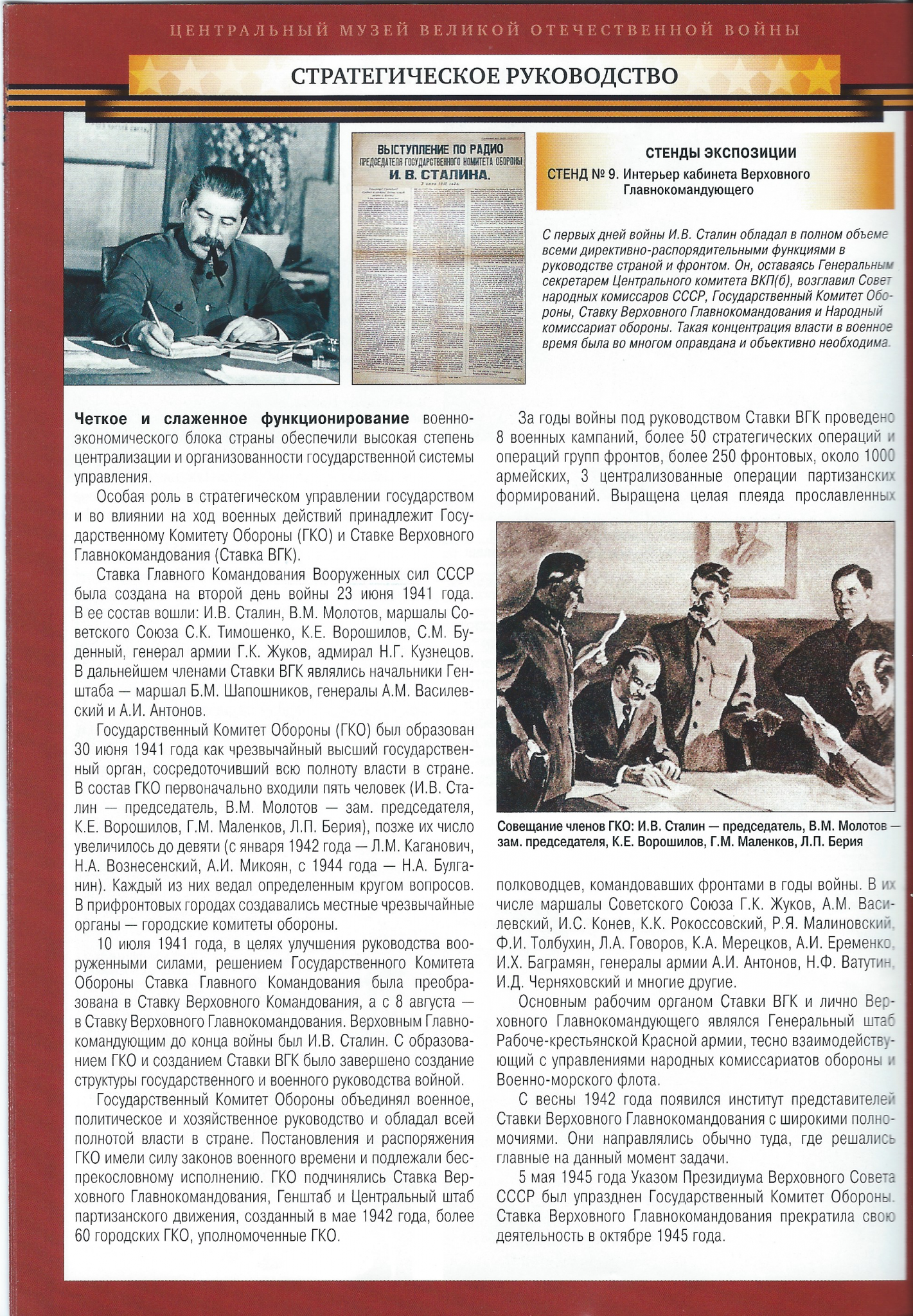
Четкое и слаженное функционирование военно- экономического блока страны обеспечили высокая степень централизации и организованности государственной системы управления.
Особая роль в стратегическом управлении государством и во влиянии на ход военных действий принадлежит Госу- дарственному Комитету Обороны (ГКО) и Ставке Верховного Главнокомандования (Ставка ВГК). Ставка Главного Командования Вооруженных сил СССР была создана на второй день войны 23 июня 1941 года. В ее состав вошли: И.В. Сталин, В.М. Молотов, маршалы Со- ветского Союза С.К. Тимошенко, K.Е. Ворошилов, С.М. Бу- денный, генерал армии Г.К. Жуков, адмирал Н.Г. Кузнецов. В дальнейшем членами Ставки ВГК являлись начальники Ген- штаба —маршал Б.М. Шапошников, генералы А.М. Василев- ский и А.И. Антонов.
Государственный Комитет Обороны (ГКО) был образован 30 июня 1941 года как чрезвычайный высший государствен- ный орган, сосредоточивший всю полноту власти в стране. В состав ГКО первоначально входили пять человек (И.В. Ста- лин председатель, В.М. Молотов- К.Е. Ворошилов, Г.М. Маленков, Л.П. Берия), позже их число увеличилось до девяти (с января 1942 года-Л.М. Каганович, Н.А. Вознесенский, А.И. Микоян, с 1944 года —Н.А. Булга- нин). Каждый из них ведал определенным кругом вопросов. В прифронтовых городах создавались местные чрезвычайные органы — городские комитеты обороны.
10 июля 1941 года, в целях улучшения руководства вооруженными силами, решением Государственного Комитета Обороны Ставка Главного Командования была преобраЗована в Ставку Верховного Командования, а с 8 августа в Ставку Верховного Главнокомандования. Верховным Главнокомандующим до конца войны был И.В. Сталин. С образова нием ГКО и созданием Ставки ВГК было завершено создание структуры государственного и военного руководства войной.
Государственный Комитет Обороны объединял военное, политическое и хозяйственное руководство и обладал всей полнотой власти в стране. Постановления и распоряжения ГКО имели силу законов военного времени и подлежали беспрекословному исполнению. ГКО подчинялись Ставка Верховного Главнокомандования, Генщштаб и Центральный штаб партизанского движения, созданный в мае 1942 года, более 60 городских ГКО, уполномоченные ГКО.
За годы войны под руководством Ставки ВГК проведено 8 военных кампаний, более 50 стратегических операций и операций групп фронтов, более 250 фронтовых, около 1000 армейских, 3 централизованные операции партизанских формирований. Выращена целая плеяда прославленны хполководцев, командовавших фронтами в годы войны. В их числе маршалы Советского Союза Г.К. Жуков, А.М. Василевский, И.С. Конев, К.К. Рокоссовский, Р.Я. Малиновский, Ф.И. Толбухин, Л.А. Говоров, К.А. Мерецков, А.И. Еременко, И.Х. Баграмян, генералы армии А.И. Антонов, Н.Ф. Ватутин, И.Д. Черняховский и многие другие.
Основным рабочим органом Ставки ВГК и лично Верховного Главнокомандующего являлся Генеральный штаб Рабоче-крестьянской Красной армии, тесно взаимодействующий с управлениями народных комиссариатов обороны и Военно-морского флота.
С весны 1942 года появился институт представителей Ставки Верховного Главнокомандования с широкими полномочиями. Они направлялись обычно туда, где решались главные на данный момент задачи.
5 мая 1945 года Указом Президиума Верховного Совета СССР был упразднен Государственный Комитет Обороны. Ставка Верховного Главнокомандования прекратила свою деятельность в октябре 1945 года.
The clear and coordinated functioning of the country’s military-economic bloc ensured a high degree of centralization and organization of the state management system.
A special role in the strategic management of the state and in influencing the course of hostilities belongs to the State Committee of Defense (GKO) and the Headquarters of the Supreme High Command (Supreme Command Headquarters). The Headquarters of the High Command of the Armed Forces of the USSR was created on the second day of the war on June 23, 1941. It included: I.V. Stalin, V.M. Molotov, Marshals of the Soviet Union S.K. Timoshenko, K.E. Voroshilov, S.M. Budenny, Army General G.K. Zhukov, Admiral N.G. Kuznetsov. Subsequently, the Chiefs of the General Staff — Marshal B.M. Shaposhnikov, generals A.M. Vasilevsky and A.I. Antonov.
The State Defense Committee (GKО) was formed on June 30, 1941 as an extraordinary supreme state body that concentrated all the power in the country. T-bills initially included five people (I.V. Stalin, chairman, V.M. Molotov- K.E. Voroshilov, G.M. Malenkov, L.P. Beria), later their number increased to nine (from January 1942 – L. M. Kaganovich, N. A. Voznesensky, A. I. Mikoyan, since 1944 – N. A. Bulganin). Each of them knew a certain range of issues. In the front-line cities, local emergency bodies were created – city defense committees.
On July 10, 1941, in order to improve the leadership of the armed forces, by decision of the State Defense Committee, the Headquarters of the High Command was transformed into the Headquarters of the Supreme Command, and from August 8, the Headquarters of the Supreme High Command. The Supreme Commander until the end of the war was I.V. Stalin. With the formation of the GKO and the creation of the Supreme Command Headquarters, the creation of a structure of state and military leadership of the war was completed.
The State Defense Committee united the military, political and economic leadership and had all the power in the country. Decisions and orders of GKOs had the force of wartime laws and were subject to unconditional execution. GKOs were subordinate to the Headquarters of the Supreme High Command, the General Staff and the Central Headquarters of the partisan movement, created in May 1942, more than 60 city GKOs authorized by GKOs.
During the war years, under the leadership of the Supreme Command Headquarters, 8 military campaigns were conducted, more than 50 strategic operations and operations of front groups, more than 250 front-line, about 1,000 army, 3 centralized operations of partisan formations. A whole galaxy of glorified warlords who commanded the fronts during the war years was grown. Among them are Marshals of the Soviet Union G.K. Zhukov A.M. Vasilevsky, I.S. Konev, K.K. Rokossovsky, R.Ya. Malinovsky, F.I. Tolbukhin, L.A. Govorov, K.A. Meretskov, A.I. Eremenko, I.Kh. Baghramyan, Army Generals A.I. Antonov, N.F. Vatutin, I.D. Chernyakhovsky and many others.
The main working body of the Supreme Command Headquarters and the Supreme Commander-in-Chief personally was the General Staff of the Workers ‘and Peasants’ Red Army, which closely interacts with the departments of the People’s Commissariats of Defense and the Navy.
In the spring of 1942, an institute of representatives of the General Headquarters of the Supreme High Command appeared with broad powers. They usually went to where the main tasks at the moment were being solved.
On May 5, 1945, the State Committee of Defense was abolished by a decree of the Presidium of the Supreme Soviet of the USSR. The headquarters of the Supreme High Command ceased operations in October 1945.
СТЕНДЫ ЭКспозиции
СТЕНД No 9. Интерьер кабинета Верховного Главнокомандующего
Exposition Stands
STAND No 9. Interior of the office of the Supreme Commander
Photo and image captions
С первых дней войны И.В. Сталин обладал в полном объеме всеми директивно-распорядительными функциями в руководстве страной и фронтом. Он, оставаясь Генеральным секретарем Центрального комитета ВКП(б), возглавил Совет народных комиссаров СССР, Государственный Комитет Обо- роны, Ставку Верховного Главнокомандования и Народный комиссариат обороны. Такая концентрация власти в военное время была во многом оправдана и обьективно необходима
From the first days of the war I.V. Stalin possessed in full all the directive and administrative functions in the leadership of the country and the front. He, remaining the Secretary General of the Central Committee of the CPSU (B.), Headed the Council of People’s Commissars of the USSR, the State Committee of Defense, the Headquarters of the Supreme High Command and the People’s Commissariat of Defense. Such a concentration of power in wartime was largely justified and objectively necessary.
Совещание членов ГКО: И.В. Сталин-председатель, В.М. Молотов зам. председателя, К.Е. Ворошилов, Г.М. Маленков, Л.П. Берия
GKO members meeting: I.V. Stalin-chairman, V.M. Molotov Deputy. Chairman K.E. Voroshilov, G.M. Malenkov, L.P. Beria
TITLE: ПАРТИЗАНСКОЕ ДВИЖЕНИЕ. ОККУПАЦИЯ
Translation: PARTISAN MOVEMENT. AN OCCUPATION
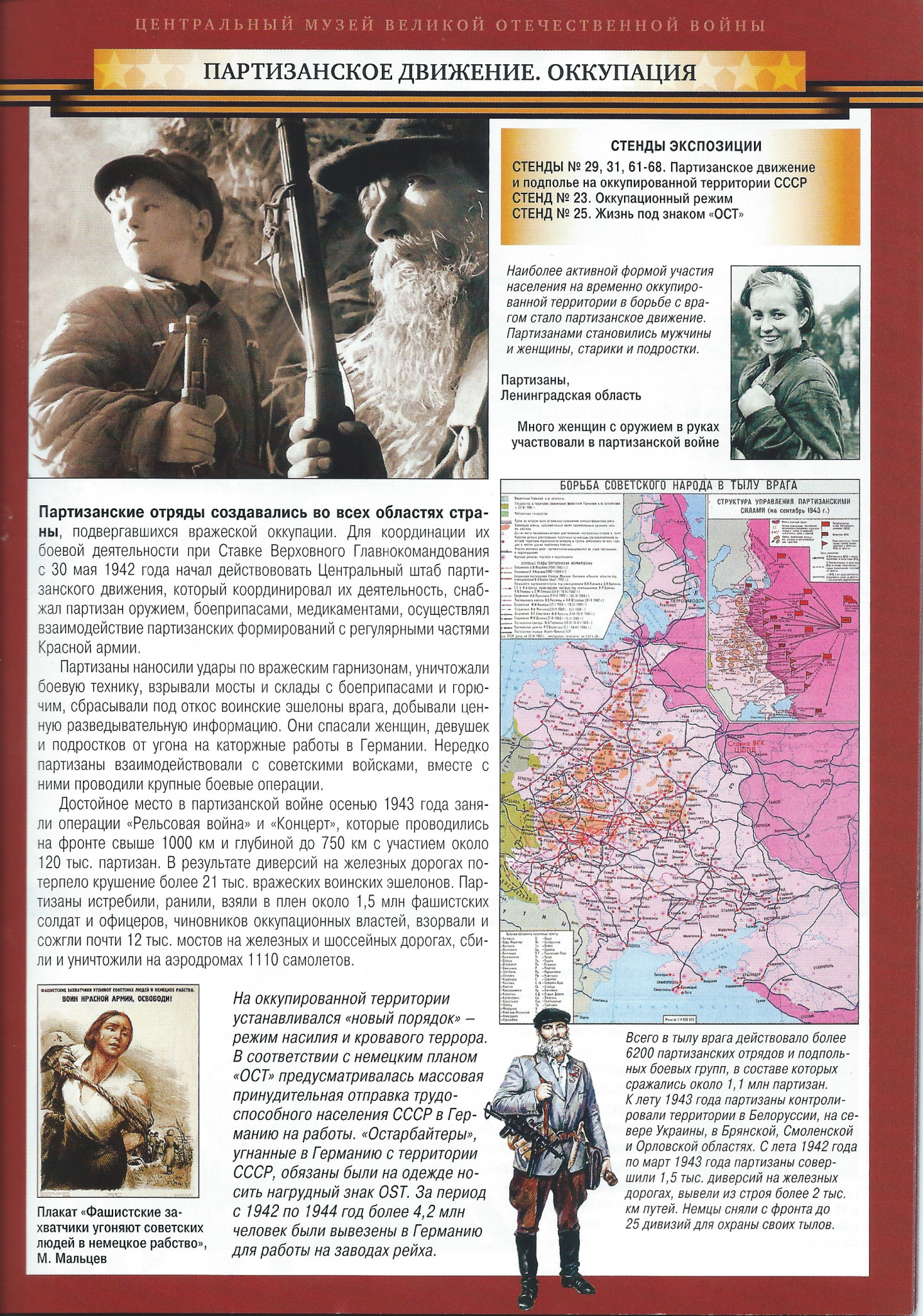
Партизанские отряды создавались во всех областях стра- ны, подвергавшихся вражеской оккупации. Для координации их боевой деятельности при Ставке Верховного Главнокомандования с 30 мая 1942 года начал действововать Центральный штаб парти- занского движения, который координировал их деятельность, снаб- жал партизан оружием, боеприпасами, медикаментами, осуществлял взаимодействие партизанских формирований с регулярными частями Красной армии.
Партизаны наносили удары по вражеским гарнизонам, уничтожали боевую технику, взрывали мосты и склады с боеприпасами и горю- чим, сбрасывали под откос воинские эшелоны врага, добывали цен- ную разведывательную информацию. Они спасали женщин, девушек и подростков от угона на каторжные работы в Германии. Нередко партизаны взаимодействовали с советскими войсками, вместе с ними проводили крупные боевые операции.
Достойное место в партизанской войне осенью 1943 года заняли операции «Рельсовая война» и «Концерт», которые проводились на фронте свыше 1000 км и глубиной до 750 км с участием около 120 тыс. партизан. В результате диверсий на железных дорогах по- терпело крушение более 21 тыс. вражеских воинских эшелонов. Партизаны истребили, ранили, взяли в плен около 1,5 млн фашистских солдат и офицеров, чиновников оккупационных властей, взорвали и сожгли почти 12 тыс. мостов на железных и шоссейных дорогах, сбили и уничтожили на аэродромах 1110 самолетов.
Partisan detachments were created in all areas of the country subjected to enemy occupation. To coordinate their combat activities at the Headquarters of the Supreme High Command, the Central Headquarters of the partisan movement began to operate on May 30, 1942, which coordinated their activities, supplied the partisans with weapons, ammunition, medicine, and carried out the interaction of partisan units with regular units of the Red Army.
The partisans attacked enemy garrisons, destroyed military equipment, blew up bridges and depots with ammunition and fuel, drove down enemy military echelons, and obtained valuable intelligence information. They saved women, girls and adolescents from hijacking in hard labor in Germany. Partisans often interacted with the Soviet troops, and carried out large-scale military operations with them.
Operations “Rail War” and “Concert” took place in the guerrilla war in the fall of 1943, which were carried out at the front over 1000 km and a depth of 750 km with the participation of about 120 thousand partisans. As a result of sabotage on the railways, more than 21 thousand enemy military echelons crashed. Partisans exterminated, wounded, captured about 1.5 million fascist soldiers and officers, officials of the occupation authorities, blew up and burned nearly 12 thousand bridges on railways and highways, shot down and destroyed 1,110 aircraft at airfields.
СТЕНДЫ ЭКСпозиции
СТЕНДЫ Nо 29, 31,61-68. Партизанское движение и подполье на оккупированной территории СССР
СТЕНД Nо 23. Оккупационный режим
СТЕНД Nо 25. Жизнь под знаком «ОСТ»
Exposition Stands
STAND Nos. 29, 31.61-68. Partisan movement and the underground in the occupied territory of the USSR
STAND No 23. Occupation regime
STAND No 25. Life under the sign “OST”
Photo and image captions
Наиболее активной формой участия населения на временно оккупиро- ванной территории в борьбе с вра- гом стало партизанское движение. Партизанами становились мужчины и женщины, старики и подростки.
The most active form of participation of the population in the temporarily occupied territory in the fight against the enemy was the partisan movement. Partisans became men and women, the elderly and adolescents. Partisans, Leningrad Region Many women with weapons in their hands participated in the partisan war
Партизаны, Ленинградская область
Partisans, Leningrad Region
Много женщин с оружием в руках участвовали в партизанской войн
Many women in arms participated in guerrilla wars
Плакат «Фашистские захватчики угоняют советских людей в немецкое рабство», М. Мальцев
Poster “Fascist invaders steal Soviet people into German slavery”, M. Maltsev
На окупированной территории устанавливался «новый порядок» режим насилия и кровавого террора. В соответствии с немецким планом «ОСТ» предусматривалась массовая принудительная отправка трудоспособного населения СССР в Германию на работы. «Остарбайтеры», угнанные в Германию с территории СССР, обязаны были на одежде носить нагрудный знак OST. За период с 1942 по 1944 год более 4,2 млн человек были вывезены в Германию для работы на заводах рейха.
In the occupied territory, a “new order” was established in a regime of violence and bloody terror. In accordance with the German “OST” plan, a mass forced dispatch of the able-bodied population of the USSR to Germany was envisaged. The Ostarbeiters, who were stolen to Germany from the territory of the USSR, were obliged to wear the OST badge on their clothes. Between 1942 and 1944, more than 4.2 million people were exported to Germany to work in the Reich factories.
Map Title and Caption
БОРЬБА СОВЕТСКОГО НАРОДА В ТЫЛУ ВРАГА
FIGHT OF THE SOVIET PEOPLE IN THE BACK OF THE ENEMY
Всего в тылу врага действовало более 6200 партизанских отрядов и подполь- ных боевых групп, в составе которых сражались около 1,1 млн партизан. К лету 1943 года партизаны контроли- ровали территории в Белоруссии, на се- вере Украины, в Брянской, Смоленской и Орловской областях. С лета 1942 года по март 1943 года партизаны совер- шили 1,5 тыс. диверсий на железных дорогах, вывели из строя более 2 тыс. км путей. Немцы сняли с фронта до 25 дивизий для охраны своих тылов.
In total, more than 6,200 partisan detachments and underground combat groups were operating behind enemy lines, in which about 1.1 million partisans fought. By the summer of 1943, partisans controlled territories in Belarus, in the north of Ukraine, in the Bryansk, Smolensk and Oryol regions. From the summer of 1942 to March 1943, partisans committed 1.5 thousand sabotage on the railways, disabled more than 2 thousand km of tracks. The Germans withdrew up to 25 divisions from the front to guard their rear.
TITLE: БИТВА ПОД МОСКВОЙ
Translation: BATTLE UNDER MOSCOW
Гитлеровское командование, признавая огромное военно-стратегическое значение Москвы, подго- товило крупную наступательную операцию «Тайфун». План предусматривал тремя мощными ударами танковых группи- ровок расчленить оборону советских войск, окружить их и уничтожить.
Наступление врага началось З0 сентября 1941 года. В ходе ожесточенных сражений на подступах к Москве было остановлено продвижение немецкой группы армий «Центр» буквально у стен столицы. 12 октября ГКО принял решение о создании оборонительных рубежей непосредственно в районе Москвы. Сотни тысяч горожан возводили оборони- тельные сооружения. 7 ноября 1941 года на Красной площади в Москве состоялся исторический парад советских войск. С парада солдаты уходили прямо на фронт. Из глубокого тыла к столице стягивались резервные дивизии. В конце октября 1941 года немецкое наступление стало выдыхаться, установился перерыв в наступательных операциях. В конце ноября 1941 года враг остановился, но еще не успел перейти к обороне и построить оборонительные позиции.
Решение наступать на обладавшего численным перевесом противника, не ожидая подхода резервов, было принято Ставкой ВГК по предложению генерала армии Г.К. Жукова.
5 декабря 1941 года ценой невероятных усилий и героизма Красная армия перешла в контрнаступление на фронте от Калинина до Ельца. Эффект внезапности сработал в полной мере. Немецкие войска дрогнули и стали отступать. Со- ветскими войсками были освобождены Калинин, Клин. Солнечногорск, Волоколамск, Наро-Фоминск, Мало- ярославец и другие города. В начале января контрна- ступление завершилось. Враг был отброшен на запад на 100-250 км
The Hitlerite command, recognizing the enormous military-strategic importance of Moscow, prepared the large-scale offensive operation Typhoon. The plan called for three powerful strikes by tank groups to disintegrate the defense of the Soviet troops, encircle them and destroy them.
The enemy offensive began on September 30, 1941. During fierce battles on the outskirts of Moscow, the advance of the German Army Group Center was stopped literally at the walls of the capital. On October 12, GKO decided to establish defensive lines directly in the Moscow region. Hundreds of thousands of citizens built defenses. On November 7, 1941, a historical parade of Soviet troops took place on Red Square in Moscow. From the parade, the soldiers went straight to the front. Reserve divisions were drawn from the deep rear to the capital. At the end of October 1941, the German offensive began to run out of steam, and a break in offensive operations was established. At the end of November 1941, the enemy stopped, but had not yet managed to go on the defensive and build defensive positions.
The decision to attack the enemy with a numerical superiority, not expecting an approach of reserves, was made by the Supreme Command at the proposal of Army General G.K. Zhukov.
On December 5, 1941, at the cost of incredible efforts and heroism, the Red Army launched a counterattack at the front from Kalinin to Yelets. The effect of surprise worked to the fullest. German troops wavered and began to retreat. Soviet troops liberated Kalinin, Klin. Solnechnogorsk, Volokolamsk, Naro-Fominsk, Malo-Yaroslavets and other cities. In early January, the counterattack ended. The enemy was driven west for 100-250 km.
Map Title and Caption
РАЗГРОМ НЕМЕЦКИХ ВОЙСК ПОд москВой (5.12 1941 г.-20.4.1942 г.)
The defeat of the German troops under Moscow (December 5, 1941-April 4, 1942)
Карта стратегических операций под Москвой. Ход боевых действий. Первый этап- Московская стратегическая оборонительная операция (30 сентября — 5 декабря 1941 года) проводилась войсками Западного, Резервного, Брянского и Калининского фронтов. Продопжительность опе- рации – 67 суток. Ширина фронта боевых действий-700-1100км. Глубина отхода советских войск-250-300 км.
Второй этап- Московская стратегическая наступательная операция ( декабря 1941 года- 7 января 1942 года) проводилась войсками Западного, Калининского, Брянского и правого крыла Юго-Западного фронтов, Продолжительность операции-34 дня. Ширина фронта боевых действий-1000 км. Глубина продвижения советских войск- 100-250 км. Контрнаступление под Москвой переросло в общее наступление Красной армии на западном направлении и продолжалось до 20 апреля 1942 года.
Map of strategic operations near Moscow. The course of hostilities. The first stage – the Moscow strategic defensive operation (September 30 – December 5, 1941) was carried out by troops of the Western, Reserve, Bryansk and Kalinin fronts. The duration of the operation is 67 days. The width of the front of hostilities is 700-1100km. The depth of the retreat of Soviet troops is 250-300 km.
The second stage – the Moscow strategic offensive operation (December 1941 – January 7, 1942) was carried out by the troops of the Western, Kalinin, Bryansk and right wing of the South-Western fronts, the duration of the operation is 34 days. The width of the battle front is 1000 km. The depth of advancement of Soviet troops is 100-250 km. The counterattack near Moscow grew into a general offensive of the Red Army in the western direction and continued until April 20, 1942.
Photo left facing
Генерал армии Г.К. Жуков, с 10 октября 1941 года командующий Западным фронтом
Army General G.K. Zhukov, from October 10, 1941 commander of the Western Front
Для развития контрнаступления Ставка ВГК использовала резервы: 26 стрелковых и 8 кавалерийских дивизий, 10 стрелковых бригад, 12 отдельных лыжных батальонов и до 100 тысяч человек пехоты. В Москве и области было сформировано 16 дивизий народного ополчения. Битва за Москву-самое крупное сражение первого года Великой Отечественной войны-было закончено поражением гитлеровской армии. Именно под Москвой был похоронен немецкий план «молниеносной войны».
For the development of the counteroffensive, the Supreme Command Headquarters used reserves: 26 rifle and 8 cavalry divisions, 10 rifle brigades, 12 separate ski battalions and up to 100 thousand infantry. 16 militia divisions were formed in Moscow and the region. The battle for Moscow — the largest battle of the first year of World War II — ended with the defeat of the Nazi army. It was near Moscow that the German plan for “lightning war” was buried.
Красноармейцы в зимней и летней полевой форме
Red Army soldiers in winter and summer field uniforms
Photo right facing
ФРОНТОВАЯ Жизнь И БЫТ
Солдатская служба-это опасный и тяжелый труд, в котором быт играл не последнюю роль. Уклад повседневной жизни на фронте был заполнен служебными обязанностями ведением боевых действий, боевой учебой, несением караульной службы, обслуживанием боевой техники и личного оружия, снабжением и техническим обеспечением войск (оружием, боеприпасами, средствами защиты, связи и т.п.); устройством жилья; снабжением продуктами питания и обмундированием; медицинским обслуживанием; часами отдыха и досуга- перепиской с родными, шефской помощью и выполнением других мероприятий.
FRONT LIFE AND LIFE
A soldier’s service is a dangerous and hard work in which life played an important role. The daily routine of life at the front was filled with official duties, conducting military operations, combat training, guarding, servicing military equipment and personal weapons, supplying and providing technical support to troops (weapons, ammunition, defense, communications, etc.); housing arrangement; food supply and uniforms; medical care; hours of rest and leisure – correspondence with relatives, patronage help and other activities.
TITLE: БЛОКАДА ЛЕНИНГРАДА
Translation: LENINGRAD BLOCKADE
Удар в направлении Ленинграда был поручен группе немецких армий «Север», которые должны были к 21 июля 1941 года овладеть Ленинградом. Сломав упорное сопротивление Красной армии, в сентябре 1941 года враг сомкнул кольцо сухопутной блокады вокруг Ленинграда. Предотвратить окружение Ленинграда не удалось.
с 8 сентября 1941 года началась 900-дневная блокада Ленинграда. В окружение попали трехмиллионный город и войска, его защищавшие. Продовольствие и топливные запасы были ограниченны. С 1 октября 1941 года были введены продовольственные карточки. В ноябре Ленинград погрузился во тьму и холод: ГЭС прекратили подачу электроэнергии; го- род был завален снегом; в результате морозов, доходивших до 30 градусов, замерзла вода; не ходили троллейбусы и трамваи. Борьба за Ленинград носила ожесточенный характер. Пытаясь сломить защитников города, гитлеровцы осуществляли непрерывные бомбардировки и обстрелы: по городу было вы- пущено более 150 тыс. снарядов и сброшено свыше 100 тыс. зажигательных бомб.
Но город жил и не сдавался: заводы продолжали выпускать военную продукцию, были открыты театры и музеи. 9 августа 1942 года в осажденном Ленинграде была исполнена Седьмая «Ленинградская» симфония Д. Шостаковича.
В связи с прекращением связи с Большой землей особое значение приобрела легендарная «Дорога жизни» через Ладожское озеро, по которой в город доставлялось продовольствие и эвакуировали детей, больных и раненых.
Блокада Ленинграда была снята в результате провдения операции «Искра» в январe 1943 года. Южнее Ладожского озера образовался коридор шириной до 11 км. Годом позже — с 14 января по 1 марта 1944 года — B xoде наступательных действий частей Красной армии блокада Ленинграда была полностью снята.
The attack in the direction of Leningrad was entrusted to the group of German armies “North”, which were to take control of Leningrad by July 21, 1941. Having broken the stubborn resistance of the Red Army, in September 1941 the enemy closed the ring of the land blockade around Leningrad. It was not possible to prevent the encirclement of Leningrad.
On September 8, 1941, the 900-day blockade of Leningrad began. The three million in the city and the troops defending it were surrounded. Food and fuel reserves were limited. From October 1, 1941, food cards were introduced. In November, Leningrad plunged into darkness and cold: hydroelectric power stations cut off power supply; the city was littered with snow; as a result of frosts reaching 30 degrees, water froze; trolleybuses and trams did not go. The struggle for Leningrad was fierce. Trying to break down the city’s defenders, the Nazis carried out continuous bombing and shelling: more than 150 thousand shells were fired around the city and more than 100 thousand incendiary bombs were dropped.
But the city lived and did not give up: factories continued to produce military products, theaters and museums were opened. On August 9, 1942, the Seventh “Leningrad” symphony of D. Shostakovich was performed in besieged Leningrad.
In connection with the termination of communications with the mainland, the legendary “Road of Life” through Lake Ladoga acquired special significance, along which food was delivered to the city and children, sick and wounded were evacuated.
The blockade of Leningrad was lifted as a result of the operation “Spark” in January 1943. South of Lake Ladoga, a corridor up to 11 km wide was formed. A year later, from January 14 to March 1, 1944, the blockade of Leningrad was completely lifted during the offensive operations of the Red Army units.
Map Title and Caption
БОРЬБА НА ПОДСТУПАХ К ЛЕНИНГРАДУ
Карта операции по снятию блокады Ленинграда. Ход боевых действий. Битва за Ленинград продолжалась с 10 июля 1941 года по 9 августа 1944 года. Первый этап- блокада и оборона Ленинграда (8 сентября 1941 года – 27 января 1944 года). Для управления войсками фронтов было образовано Главное командование войск Северо-Заладного направления, подчинив ему войска Северного и Северо-Западного фронтов, Северный и Балтийский флоты. Второй этап- стратегическая операция «Искра» по прорыву блокады Ленинграда (12-30 января 1943 года) при участии войск Ленинградского и Волховского фронтов при содействии Балтийского флота и авиации. Продолжительность операции 19 суток. Ширина фронта- 45 км. Глубина продвижения советских войск— 60 км. Третий этап – Ленинградско- Новгородская стратегическая наступательная операция (14 января- 1 марта 1944 года). Четвертый этап — операция по разгрому противника в Карелии (2 марта – 9 августа 1944 года).
FIGHT ON APPROACHES TO LENINGRAD
Map of the operation to lift the siege of Leningrad. The course of hostilities. The battle for Leningrad lasted from July 10, 1941 to August 9, 1944. The first stage is the blockade and defense of Leningrad (September 8, 1941 – January 27, 1944). To command the troops of the fronts, the High Command of the North-West Command was formed, subordinating the troops of the Northern and North-Western Fronts, the Northern and Baltic Fleets to it. The second stage is the Iskra strategic operation to break through the blockade of Leningrad (January 12-30, 1943) with the participation of the troops of the Leningrad and Volkhov fronts with the assistance of the Baltic Fleet and aviation. The duration of the operation is 19 days. The width of the front is 45 km. The depth of advancement of Soviet troops is 60 km. The third stage is the Leningrad-Novgorod strategic offensive operation (January 14 – March 1, 1944). The fourth stage is the operation to defeat the enemy in Karelia (March 2 – August 9, 1944).
Left facing photo captions
Генерал-полковник Л.А. Говоров, с 1942 года командовал войсками Ленинградского фронта
Colonel General L.A. Govorov, since 1942 he commanded the troops of the Leningrad Front
В ходе 900-дневной обороны города советские войска сковали крупные силы германской и финской армий, что способствовало победам Красной армии на других фронтах. В операции «Искра» для деблокирования Ленинграда соединения Ленинградского и Волховского фронтов при поддержке авиации и Балтийского флота 12 января 1943 года нанесли встречные удары между Шлиссельбургом и Синявином. 18 января армии соединились, образовав коридор, через который Ленинград получил железнодорожную и автомобильную связь со страной. В летних и осенних боях 1943 года войска Ленинградского и Волховского фронтов сорвали попытки противни- ка восстановить полную блокаду города на Неве.
During the 900-day defense of the city, Soviet troops fettered large forces of the German and Finnish armies, which contributed to the victories of the Red Army on other fronts. In Operation Iskra, on January 12, 1943, counterattacks were launched between Shlisselburg and Sinyavin to unblock Leningrad, connecting the Leningrad and Volkhov fronts with the support of aviation and the Baltic Fleet. On January 18, the armies joined, forming a corridor through which Leningrad received rail and road connections with the country. In the summer and autumn battles of 1943, the troops of the Leningrad and Volkhov fronts thwarted the enemy’s attempts to restore the complete blockade of the city on the Neva.
Генерал армии К.А. Мерецков, с декабря 1941 по февраль 1944 года командовал войсками Волховского, в феврале— ноябре 1944 года— Карельского фронтов
Army General K.A. Meretskov, from December 1941 to February 1944 he commanded the troops of Volkhovsky, in February – November 1944, the Karelian fronts
Right facing photo captions
На долю жителей Ленинграда выпали неимоверные страдания. От их стойкости и мужества в значительной мере зависел исход войны в целом. Ленинградцы умирали дома в холодных квартирах, на рабочих местах, в очередях за хлебом. Горе пришло в каждую семью. В январе 1942 года было зарегистрировано самое низкое количество продовольствия в городе: на человека приходилось по 125 граммов хлеба в день. В этот трагический период блокады Ленинграда только от голода погибли свыше 640 тысяч жителей, десятки тысяч погибли при артиллерийских обстрелах и бомбардировках, умерли в эвакуации.
Incredible suffering fell on the inhabitants of Leningrad. The outcome of the war as a whole largely depended on their steadfastness and courage. Leningraders died at home in cold apartments, at workplaces, in lines for bread. Grief came to every family. In January 1942, the lowest amount of food in the city was registered: 125 grams of bread per day were per person. During this tragic period of the siege of Leningrad, more than 640 thousand inhabitants died of starvation, tens of thousands died during shelling and bombing, and died in evacuation.
СТЕНДЫ ЭКСПозиции
СТЕНД No 13. Интерьер квартиры блокадного Ленинграда
СТЕНД No 14. Ленинградская битва
EXPOSITION STANDS
STAND No 13. Interior of the apartment of the besieged Leningrad
STAND No 14. Leningrad battle
Title: тЫЛ В ГОДЫ ВОЙНЫ
Translation: THE REAR IN THE WAR YEARS
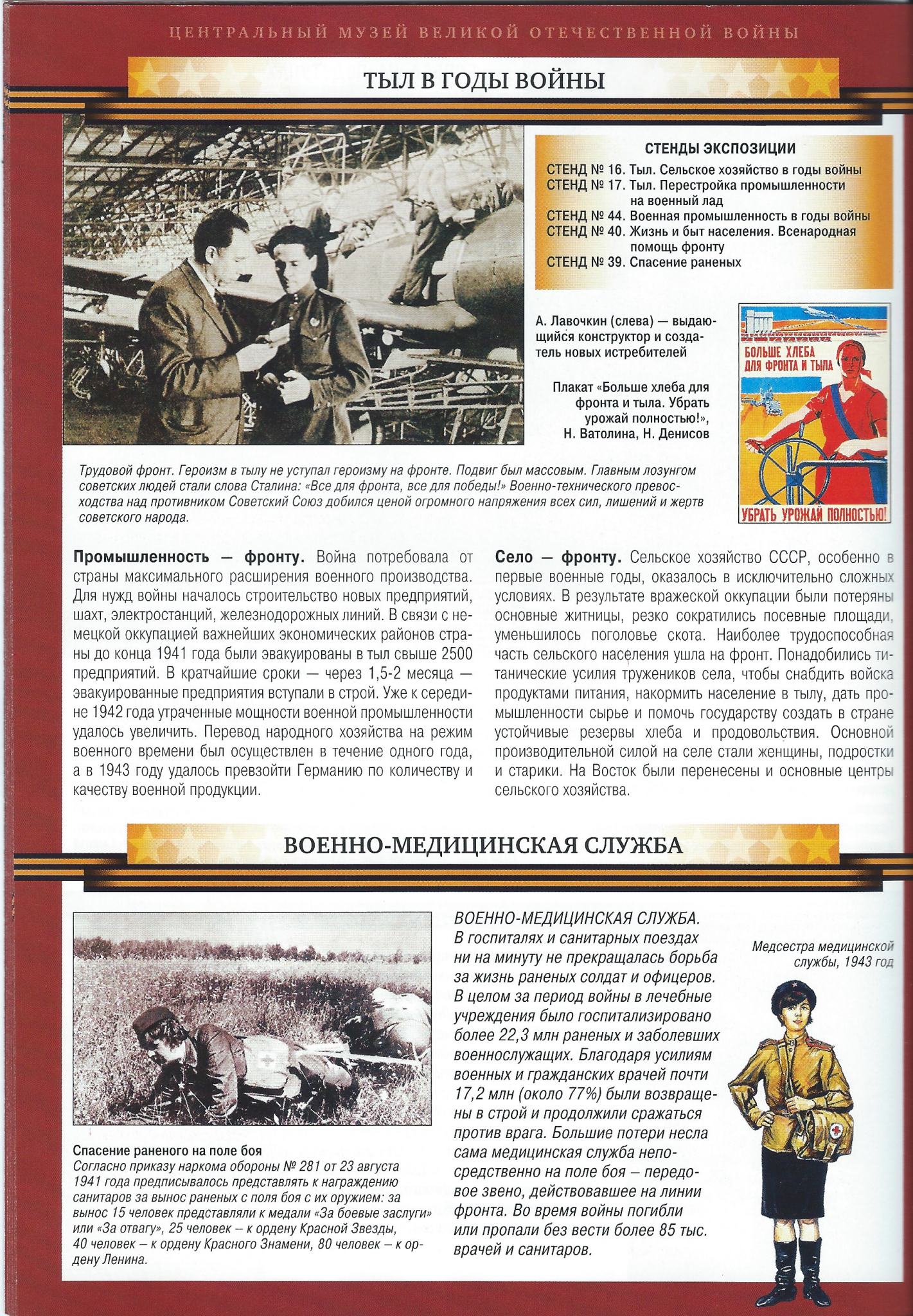
Промышленность- фронту.
Война потребовала от страны максимального расширения военного производства. Для нужд войны началось строительство новых предприятий, шахт, электростанций, железнодорожных линий. В связи с немецкой оккупацией важнейших экономических районов страны до конца 1941 года были эвакуированы в тыл свыше 2500 предприятий. В кратчайшие сроки- через 1,5-2 месяца— эвакуированные предприятия вступали в строй. Уже к середине 1942 года утраченные мощности военной промышленности удалось увеличить. Перевод народного хозяйства на режим военного времени был осуществлен в течение одного года, а в 1943 году удалось превзойти Германию по количеству и качеству военной продукции.
Industry-front.
The war demanded that the country maximize the expansion of military production. For the needs of the war, the construction of new enterprises, mines, power plants, and railway lines began. In connection with the German occupation of the most important economic regions of the country, by the end of 1941, over 2500 enterprises were evacuated to the rear. As soon as possible, after 1.5-2 months, the evacuated enterprises were put into operation. By mid-1942, the lost capacities of the military industry had been increased. The transition of the national economy to wartime was carried out within one year, and in 1943 it was possible to surpass Germany in the quantity and quality of military products.
Село — фронту. Сельское хозяйство СССР, особенно в первые военные годы, оказалось в исклюЧительно сложных условиях. В результате вражеской оккупации были потеряны основные житницы, резко сократились посевные площади, уменьшилось поголовье скота. Наиболее трудоспособная часть сельского населения ушла на фронт. Понадобились титанические усилия тружеников села, чтобы снабдить войска продуктами питания, накормить население в тылу, дать промышленности сырье и помочь государству создать в стране устойчивые резервы хлеба и продовольствия. Основной производительной силой на селе стали женщины, подростки и старики. На Восток были перенесены и основные центры сельского хозяйства.
Village to the Front. The agriculture of the USSR, especially in the early war years, turned out to be in exceptionally difficult conditions. As a result of the enemy occupation, the main granaries were lost, the acreage was sharply reduced, and the livestock number decreased. The most able-bodied part of the rural population went to the front. It took the titanic efforts of the village workers to supply the troops with food, feed the population in the rear, provide the industry with raw materials and help the state create sustainable reserves of bread and food in the country. The main productive force in the village was women, adolescents and the elderly. The main centers of agriculture were also transferred to the East.
Top section photo captions
СТЕНДЫ ЭКСпозиции
СТЕНД No 16. Тыл. Сельское хозяйство в годы войны
СТЕНД No 17. Tыл. Перестройка промышленности на военный лад
СТЕНД No 44. Военная промышленность в годы войны
СТЕНД No 40. Жизнь и быт населения. Всенародная помощь фронту
СТЕНД No 39. Спасение раненых
EXPOSITION STANDS
STAND No 16. Rear. Agriculture during the war
STAND No 17. Rear. The restructuring of industry in a military fashion
STAND No 44. Military industry during the war years
STAND No 40. Life and life of the population. National assistance to the front
STAND No 39. Rescue of the wounded
А. Лавочкин (слева)-выдаю- щийся конструктор и созда- тель новых истребителей Плакат «Больше хлеба для фронта и тыла. Убрать урожай полностыю!», Н. Ватолина, Н. Денисов
A. Lavochkin (left), an outstanding designer and creator of new fighters. Poster “More bread for the front and rear. Harvest completely! ”, N. Vatolina, N. Denisov
Трудовой фронт. Героизм в тылу не уступал героизму на фронте. Подвиг был массовым. Главным лозунгом советских людей стали слова Сталина: «Все для фронта, все для победы!» Военно-технического превосходства над противником Советский Союз добился ценой огромного напряжения всех сил, лишений и жертв Советского народа.
Labor front. Heroism in the rear was not inferior to heroism at the front. The feat was massive. The main slogan of the Soviet people were the words of Stalin: “Everything for the front, everything for the victory!” The Soviet Union achieved military-technical superiority over the enemy at the cost of tremendous exertion of all the forces, deprivations and victims of the Soviet people.
Title: ВОЕННО-МЕДИЦИНСКАЯ СЛУЖБА
Translation: MILITARY MEDICAL SERVICE
ВОЕННО-МЕДИЦИНСКАЯ СЛУЖБА.
В госпиталях и санитарных поездах ни на минуту не прекращалась борьба за жизнь раненых солдат и офицеров. В целом за период войны в лечебные учреждения было госпитализировано более 22,3 млн раненых и заболевших военнослужащих. Благодаря усилиям военных и гражданских врачей почти 17,2 млн (около 77%) были возвращены в строй и продолжили сражаться против врага. Большие потери несла сама медицинская служба непосредственно на поле боя — передовое звено, действовавшее на линии фронта. Во время войны погибли или пропали без вести более 85 тыс. врачей и санитаров.
MILITARY MEDICAL SERVICE.
In hospitals and ambulance trains, the struggle for the life of wounded soldiers and officers did not stop for a minute. In general, during the war, more than 22.3 million wounded and sick military personnel were hospitalized in medical institutions. Thanks to the efforts of military and civilian doctors, almost 17.2 million (about 77%) were returned to duty and continued to fight against the enemy. The medical service itself suffered heavy losses directly on the battlefield — the front line operating on the front line. During the war, more than 85 thousand doctors and orderlies were killed or went missing.
Lower section photo captions
Медсестра медицинской службы, 1943 год
Medical Nurse, 1943
Спасение раненого на поле боя
Согласно приказу наркома обороны No 281 от 23 августа 1941 года предписывалось представлять к награждению санитаров за вынос раненых с поля боя с их оружием: за вынос 15 человек представляли к медали «За боевые заслуги» или «За отвагу», 25 человек-к ордену Красной Звезды, 40 человек — к ордену Красного Знамени, 80 человек к ор- дену Ленина.
Salvation of a wounded man on the battlefield
According to the order of the People’s Commissar of Defense No. 281 of August 23, 1941, it was prescribed to submit to the award medics for the removal of the wounded from the battlefield with their weapons: for the removal of 15 people, the representative of the medal “For Military Merit” or “For Courage”, 25 people – to the Order of the Red Star, 40 people – to the Order of the Red Banner, 80 people to the Order of Lenin.
Title: КУЛЬТУРА —ФРОНТУ
Translation: CULTURE — FRONT
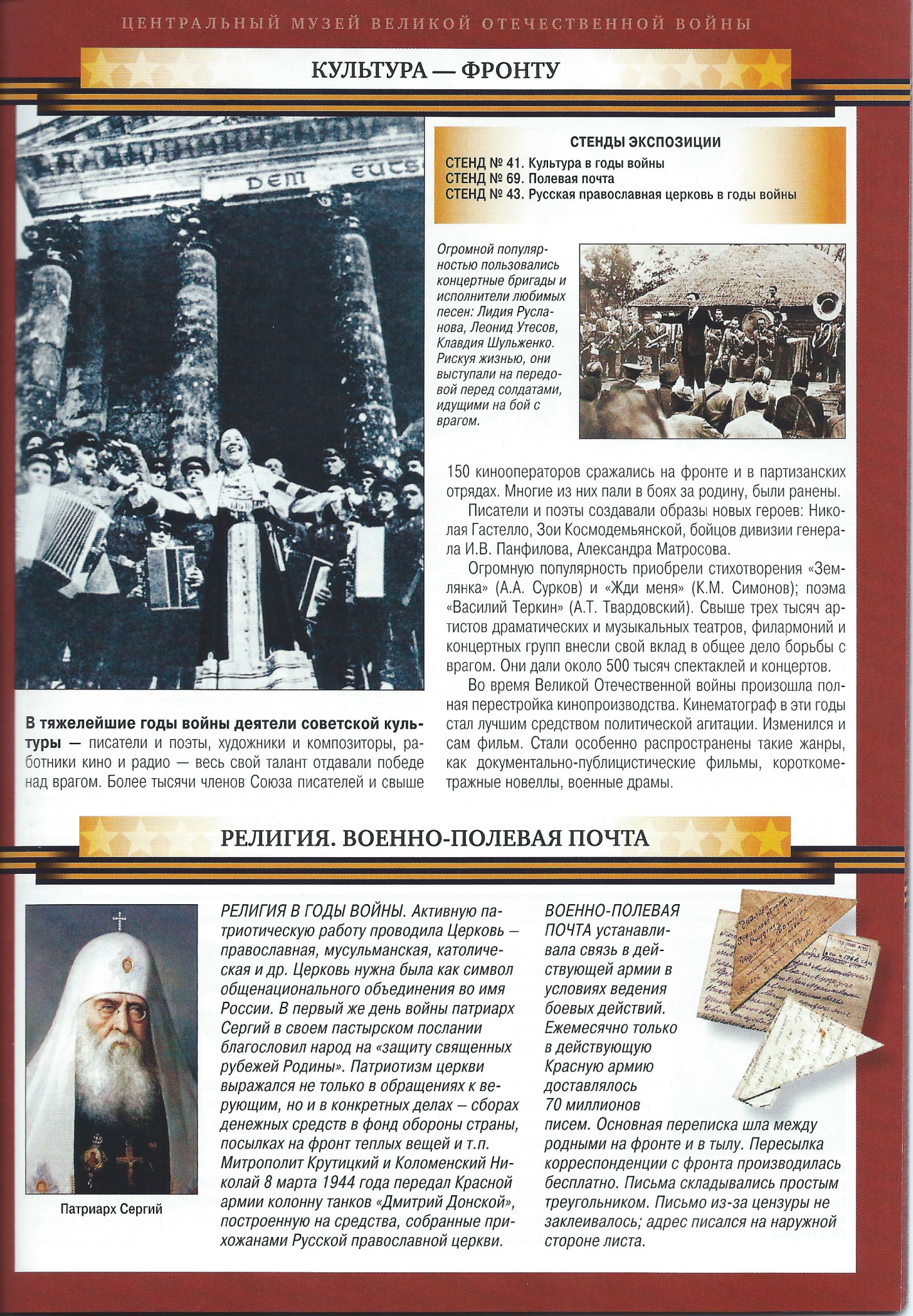
В тяжелейшие годы войны деятели советской куль- туры писатели и поэты, художники и композиторы, работники кино и радио весь свой талант отдавали победе над врагом. Более тысячи членов Союза писателей и свыше 150 кинооператоров сражались на фронте и в партизанских отрядах. Многие из них пали в боях за родину, были ранены.
Писатели и поэты создавали образы новых героев: Николая Гастелло, Зои Космодемьянской, бойцов дивизии генерала И.В. Панфилова, Александра Матросова.
Огромную популярность приобрели стихотворения «Землянка» (А.А. Сурков) и «Жди меня» (K.М. Симонов); поэма «Василий Теркин» (А.Т. Твардовский). Свыше трех тысяч артистов драматических и музыкальных театров, филармоний и концертных групп внесли свой вклад в общее дело борьбы с врагом. Они дали около 500 тысяч спектаклей и концертов.
Во время Великой Отечественной войны произошла полная перестройка кинопроизводства. Кинематограф в эти годы стал лучшим средством политической агитации. Изменился и сам фильм. Стали особенно распространены такие жанры, как документально-публицистические фильмы, короткометражные новеллы, военные драмы.
In the hardest years of the war, Soviet cultural figures, writers and poets, artists and composers, film and radio workers devoted all their talent to victory over the enemy. More than a thousand members of the Writers’ Union and over 150 cameramen fought at the front and in partisan detachments. Many of them fell in battles for their homeland, were wounded.
Writers and poets created images of new heroes: Nikolai Gastello, Zoe Kosmodemyanskaya, fighters of the division of General I.V. Panfilov, Alexander Matrosov.
The poems “Dugout” (A. A. Surkov) and “Wait for Me” (K. M. Simonov) gained immense popularity; the poem “Vasily Terkin” (A.T. Twardovsky). Over three thousand artists of drama and musical theaters, philharmonic societies and concert groups have contributed to the common cause of the fight against the enemy. They gave about 500 thousand performances and concerts.
During World War II, there was a complete overhaul of film production. Cinema in these years has become the best means of political agitation. The movie itself has changed. Genres such as documentary films, short novels, and military dramas have become especially common.
Upper half captions
СТЕНДЫ ЭКСпозиции
СТЕНД No 41. Культура в годы войны
СТЕНД No 69. Полевая почта
СТЕНД No 43. Русская православная церковь в годы войны
EXHIBITION STANDS
STAND No 41. Culture during the war years
STAND No 69. Field mail
STAND No 43. Russian Orthodox Church during the war
Огромной популярностью пользовались концертные бригады и исполнители любимых песен: Лидия Русла- нова, Леонид Утесов, Клавдия Шульженко. Рискуя жизнью, они выступали на передо- вой перед солдатами, идущими на бой с врагом.
Concert bands and performers of favorite songs were very popular: Lidia Ruslanova, Leonid Utesov, Klavdiya Shulzhenko. At the risk of their life, they were at the front line before the soldiers going to battle with the enemy.
Title: РЕЛИГИЯ. ВОЕННО-ПОЛЕВАЯ ПОЧТА
Translation: RELIGION. MILITARY MAIL
РЕЛИГИЯ В ГОДЫ ВОЙНЫ. Активную патриотическую работу проводила Церковь православная, мусульманская, католическая и др. Церковь нужна была как символ общенационального объединения во имя России. В первый же день войны патриарх Сергий в своем пастырском послании благословил народ на «защиту священных рубежей Родины». Патриотизм церкви выражался не только в обращениях к верующим, но и в конкретных делах сборах денежных средств в фонд обороны страны, посылках на фронт теплых вещей и т.п. Митрополит Крутицкий и Коломенский Николай 8 марта 1944 года передал Красной армии колонну танков «Дмитрий Донской», построенную на средства, собранные прихожанами Русской православной церкви.
RELIGION IN THE YEARS OF WAR. Active patriotic work was carried out by the Orthodox, Muslim, Catholic, and other churches. The church was needed as a symbol of a nationwide union in the name of Russia. On the very first day of the war, Patriarch Sergius in his pastoral epistle blessed the people to “protect the sacred borders of the Motherland.” The patriotism of the church was expressed not only in appeals to believers, but also in specific cases of fundraising for the country’s defense fund, sending warm things to the front, etc. On March 8, 1944, Metropolitan of Krutitsky and Kolomna Nikolai handed over to the Red Army a column of tanks “Dmitry Donskoy”, built with funds raised by parishioners of the Russian Orthodox Church.
ВОЕННО-ПОЛЕВАЯ ПОЧТА устанавливала связь в действующей армии в условиях ведения боевых действий. Ежемесячно только в действующую Красную армию доставлялось 70 миллионов писем. Основная переписка шла между родными на фронте и в тылу. Пересылка корреспонденции с фронта производилась бесплатно. Письма складывались простым треугольником. Письмо из-за цензуры не заклейвалось; адрес писался на наружной стороне листа.
MILITARY MAIL established communications in the army in the conditions of warfare. Every month, 70 million letters were delivered to the active Red Army alone. The main correspondence was between relatives at the front and in the rear. Forwarding correspondence from the front was free of charge. Letters formed a simple triangle. The letter was not sealed due to censorship; The address was written on the outside of the sheet.
Lower half captions
Патриарх Сергий
Patriarch Sergius
Title: СТАЛИНГРАДСКАЯ БИТВА
Translation: STALINGRAD BATTLE
Diorama “Connection of the Fronts. Stalingrad”
Original text: Летом 1942 года войска вермахта наступали на юж- ном направлении с целью захвата Кавказа с выходом на Сталинград. Развернулась великая Сталинградская битва.
Оборонительная операция началась 17 июля 1942 года и продолжалась в течение четырех месяцев. С 12 сентября оборона Сталинграда была возложена на 62-ю армию (ко- мандующий генерал-лейтенант В.И. Чуйков) и 64-й армию (командующий генерал-майор М.С. Шумилов). В городе раз- вернулись ожесточенные бои. Символом мужества, стойкости и героизма стал дом, удерживаемый гарнизоном сержанта Павлова. Двадцать четыре воина девяти национальностей стойко отражали атаки противника и удерживали дом в те- чение двух месяцев. За свой беспримерный подвиг гвардии сержант Я.Ф. Павлов удостоен Звезды Героя. Советские вой- ска измотали врага и вынудили его перейти к обороне.
19 ноября 1942 года залпами 7 тыс. орудий и реактивных установок началась наступательная операция войск Юго- Западного и Сталинградского фронтов. Они соединились в районе города Калач и поселка Советский 23 ноября, за- вершив окружение 330-тысячной группировки противника под командованием фельдмаршала Ф. Паулюса.
Ликвидация окруженного противника была возложена на Донской фронт. 2 февраля войска 6-й армии Ф. Паулюса полностью капитулировали. Советским войскам удалось вы- рвать у противника стратегическую инициативу и удерживать ее до конца войны.
Большой вклад в разгром противника внесла советская авиация. Советские летчики уничтожили свыше 4.4 тыс. самолетов и положили начало коренному пере- лому в борьбе за стратегическое господство в воздухе.
In the summer of 1942, the Wehrmacht troops advanced southward to capture the Caucasus with access to Stalingrad. The great battle of Stalingrad unfolded.
The defensive operation began on July 17, 1942 and continued for four months. Since September 12, the defense of Stalingrad has been assigned to the 62nd Army (commanding Lieutenant General V.I. Chuykov) and the 64th Army (commander Major General MS Shumilov). Fierce battles unfolded in the city. A symbol of courage, stamina and heroism was the house held by the garrison of Sergeant Pavlov. Twenty-four warriors of nine nationalities staunchly repelled the enemy’s attacks and held the house for two months. For his unprecedented feat of the guard, Sergeant Y.F. Pavlov awarded the Star of the Hero. Soviet troops exhausted the enemy and forced him to go on the defensive.
On November 19, 1942, in volleys of 7 thousand guns and rocket launchers, the offensive operation of the troops of the Southwestern and Stalingrad fronts began. They connected in the area of the city of Kalach and the village of Sovetskiy on November 23, completing the encirclement of the 330,000th enemy group under the command of Field Marshal F. Paulus.
The elimination of the surrounded enemy was entrusted to the Don Front. On February 2, the troops of the 6th Army of F. Paulus completely surrendered. Soviet troops managed to wrest the strategic initiative from the enemy and hold it until the end of the war.
A great contribution to the defeat of the enemy was made by Soviet aircraft. Soviet pilots destroyed over 4.4 thousand aircraft and laid the foundation for a radical turn in the struggle for strategic air supremacy.
Photo captions left facing
Рейхсмаршал авиации Герман Геринг, летчик-ас Первой мировой войны, создатель и руководитель Люфтваффе
Reichsmarschall Aviation Hermann Goering, World War I pilot, creator and leader of the Luftwaffe
ЛЮФТВАФФЕ В ГОДЫ ВОЙНЫ К началу Второй мировой войны немецкая авиация по численности и качеству далеко превзошла английскую и французскую. Накануне Второй мировой войны Германия имела 1180 бомбардировщиков, 771 истребитель, 36 пикирующих бомбардировщиков, 408 тяжелых истребителей, 40 штурмовиков, 552 транспортных самолета, 379 дальних и 342 ближних разведчиков, 240 самолетов морской авиации. «Мессершмитт-109» стал основным немецким истребителем Второй мировой войны. За годы войны было выпущено более 33 тыс. его различных модификаций. «Юнкерс» Ю-88 -самый распространенный немецкий двухмоторный бомбардировщик. В годы войны в Германии построили почти 15 тыс. бомбардировщиков Ю-88 и 5700 — Ю-87. Немецкой авиационной промышленностью и промышленностью оккупированных Германией стран с 1 сентября 1939 года и до конца войны было выпущено 113515 самолетов всех типов.
LUFTWAFFE IN THE YEARS OF WAR By the beginning of World War II, German aviation far surpassed English and French in numbers and quality. On the eve of World War II, Germany had 1,180 bombers, 771 fighters, 36 dive bombers, 408 heavy fighters, 40 attack aircraft, 552 transport aircraft, 379 long-range and 342 close reconnaissance aircraft, and 240 naval aircraft. Messerschmitt 109 became the main German fighter of World War II. During the war years more than 33 thousand of its various modifications were produced. Junkers Yu-88 is the most common German twin-engine bomber. During the war years in Germany, almost 15 thousand U-88 bombers and 5700 U-87 bombers were built. From September 1, 1939 until the end of the war, 113515 aircraft of all types were produced by the German aviation industry and the industry of the countries occupied by Germany.
Истребитель «Мессершмитт» B. 109
Fighter Messerschmitt B. 109
Map
Карта стратегических операций Сталинградской битвы. Ход военных действий. Первый период-стратегическая оборонительная операция (17 июля 18 ноября 1942 года). Операция проводилась войсками Сталинградского (Донского), Юго-Восточного (Сталинградского) фронтов при содействии Волжской военной флотилии и Сталинградского корпусного района ПВО. Продолжительность операции- 125 суток. Ширина фронта- 250-520 км. Глубина отхода советских войск— 150 км.
Второй период-Сталинградская стратегическая наступательная операция (19 ноября 1942 года- 2 февраля 1943 года). Операция проводилась войсками Юго-Западного, Донского, Сталинградского фронтов при содействии Волжской военной флотилии. Продолжительность операции 76 суток. Ширина фронта 850 км. Глубина продвижения советских войск — 150-200 км. В рамках операции были проведены операции «Уран», «Малый Сатурн» и «Кольцо»
Map of the strategic operations of the Battle of Stalingrad. The course of hostilities. The first period is a strategic defensive operation (July 17, November 18, 1942). The operation was carried out by the troops of the Stalingrad (Don), Southeast (Stalingrad) fronts with the assistance of the Volga military flotilla and the Stalingrad corps air defense district. The duration of the operation is 125 days. The width of the front is 250-520 km. The depth of retreat of Soviet troops is 150 km.
The second period is the Stalingrad strategic offensive operation (November 19, 1942 – February 2, 1943). The operation was carried out by the troops of the South-Western, Don, Stalingrad fronts with the assistance of the Volga military flotilla. The duration of the operation is 76 days. The width of the front is 850 km. The depth of advancement of Soviet troops is 150-200 km. As part of the operation, operations “Uranus”, “Small Saturn” and “Ring” were carried out
Photo captions right facing
СТЕНДЫ ЭКСпозиции
СТЕНД No 18. Сталинградская битва. Оборонительные бои
СТЕНД No 19. Крах немецкого наступления под Сталинградом
СТЕНД No 20. Героические символы Сталинградской битвы
СТЕНД No 22. Воздушное сражение на Кубани
EXHIBITION STANDS
STAND No 18. The Battle of Stalingrad. Defensive battles
STAND No 19. The collapse of the German offensive at Stalingrad
STAND No 20. Heroic characters of the Battle of Stalingrad
STAND No 22. Air battle in the Kuban
Генерал-фельдмаршал Фридрих Паулюс, командующий 6-й армией, капитулировавшей под Сталинградом
Field Marshal Friedrich Paulus, Commander of the 6th Army, capitulating at Stalingrad
Покрышкин А.И.- советский легендарный летчик-ас. Свой первый «Мессершмитт» BI.109 он сбил в первые дни войны. Первый трижды Герой Советского Союза. Маршал авиации
Pokryshkin A.I.- Soviet legendary ace pilot. He shot down his first Messerschmitt BI.109 in the early days of the war. The first three times Hero of the Soviet Union. Air Marshal
СОВЕТСКАЯ АВИАЦИЯ В ГОДЫ ВОЙНЫ Советская авиация внесла существенный вклад в разгром фашистской Гер- мании. В годы войны военные летчики сбили 55 тысяч немецких самолетов, со- вершили 595 воздушных таранов. Более 2400 летчиков удостоены звания Героя Советского Союза. Такого массового проявления мужества и героизма не знает ни одна военная авиация. В 1940-1945 годах на вооружении Красной армии состояли истребители МиГ, ЛаГГ, Ла и Як и бомбардировщики Ил и Пе. Новые типы истребителей и бомбардировщиков не уступали немецким, а по отдельным тактико-техническим характеристикам превосходили их. Самыми многочисленными были истребители Яковлева. Их выпустили более 35 тысяч. Самый распространенный советский бомбардировщик Пе-2 не имел себе равных. Бронированный штурмовик Ил-2 был прозван немцами «черная смерть». За период войны по ленд-лизу было получено 9091 самолет-истребитель и 2763 бомбардировщика.
SOVIET AIRCRAFT IN THE YEARS OF WAR Soviet aviation made a significant contribution to the defeat of fascist Germany. During the war years, military pilots shot down 55 thousand German planes, completed 595 rams. More than 2,400 pilots were awarded the title of Hero of the Soviet Union. No military aviation knows such a massive manifestation of courage and heroism. In 1940-1945, the MiG, LaGG, La and Yak fighters and the Il and Pe bombers were in service with the Red Army. New types of fighters and bombers were not inferior to the German, and surpassed them in certain tactical and technical characteristics. The most numerous were Yakovlev fighters. They were released by more than 35 thousand. The most common Soviet Pe-2 bomber was second to none. The armored attack aircraft Il-2 was nicknamed by the Germans “black death”. During the war, Lend-Lease received 9091 fighter planes and 2763 bombers.
Истребитель Як-1
Fighter Yak-1
Title: КУРСКАЯ БИТВА
Translation: KURSK BATTLE
Diorama “Kursk Bulge”
Курская битва по своему размаху является одной из круп- нейших битв Великой Отечественной войны.
С беих сторон были вовлечены: более 2 млн человек, почти 70 тыс. орудий и минометов, до 13 тыс. танков и САУ, свыше 11 тыс. самолетов.
Немецким командованием был разработан план наступа- тельной операции «Цитадель» в районе Курска, в ходе которой планировалось разгромить советские войска, находящиеся на Курском выступе, а затем провести операцию «Пантера» против войск Юго-Западного фронта.
Советское командование в районе Орловско-Курской дуги планировало заблаговременно подготовить глубокоэшелонированную оборону и, опираясь на нее, отразить наступление противника, измотать и обескровить его ударные группировки, а затем перейти в контрнаступление на юго-западном направлении. В оборонительных сражениях советские войска отразили наступление немецких войск групп армий «Центр» и «Юг» (генерал-фельдмаршалы Г. Клюге и Э. Манштейн), сорвав попытку противника окружить и уничтожить советские войска на Курской дуге.
12 июля 1943 года советские войска, измотав противника в обороне, перешли в контрнаступление. В этот день в районе Прохоровки произошло крупнейшее встречное танковое сражение, в котором с обеих сторон участвовало до 1,2 тыс. танков и самоходных орудий. За день боя противоборствующие стороны потеряли от 30 до 60% танков и САУ каждая. В этот день наступил перелом в Курской битве, враг прекратил наступление и стал отводить войска в исходное положение.
Развивая наступление, советские войска к 5 августа освободили Орел и Белгород. Вечером 5 августа 1943 года в Москве впервые прогремел артиллерийский салют в честь освобождения Орла и Белгорода – 12 залпов из 120 орудий. Продолжая контрнаступление, к 23 августа советские войска освободили Харьков.
The Battle of Kursk in its scope is one of the largest battles of the Great Patriotic War.
On both sides were involved: more than 2 million people, almost 70 thousand guns and mortars, up to 13 thousand tanks and self-propelled guns, over 11 thousand aircraft.
The German command developed a plan for the offensive operation “Citadel” in the Kursk region, during which it was planned to defeat the Soviet troops located on the Kursk ledge, and then carry out the operation “Panther” against the troops of the South-Western Front.
The Soviet command in the area of the Oryol-Kursk arch planned to prepare in advance a defense in depth and, relying on it, repel the enemy’s advance, exhaust and bleed its attack groups, and then go on a counterattack in the south-west direction. In defensive battles, Soviet troops repelled the advance of the German forces of the Army groups Center and South (Field Marshals G. Kluge and E. Manstein), foiling the enemy’s attempt to encircle and destroy Soviet troops on the Kursk Bulge.
On July 12, 1943, Soviet troops, having exhausted the enemy in defense, went over to the counteroffensive. On this day, the largest counter tank battle took place in the Prokhorovka area, in which up to 1.2 thousand tanks and self-propelled guns participated on both sides. On the day of the battle, the warring parties lost 30 to 60% of the tanks and self-propelled guns each. On this day, a turning point occurred in the Battle of Kursk, the enemy stopped the attack and began to withdraw troops to their original position.
Developing the offensive, by August 5, Soviet troops liberated Oryol and Belgorod. On the evening of August 5, 1943, an artillery salute thundered for the first time in Moscow in honor of the liberation of Orel and Belgorod — 12 salvos of 120 guns. Continuing the counterattack, by August 23, Soviet troops liberated Kharkov.
Map
КОНТРНАСТУПЛЕНИЕ СОВЕТСКИХ ВОйск 127-23 8. 1943 г.
Counter-offensive of the Soviet Army 127-23 8. 1943
Карта стратегических операций Курской битвы. Ход боевых действий. Первый этап Курская оборонительная операция (5-23 июля 1943 г.) проводилась войсками Центрального, Воронежского и Степного фронтов на фронте — 550 км. Глубина отхода- 12-35 км. Второй этап Орловская наступательная операция «Кутузов» (12 июля — 18 августа 1943г.) проводилась войсками Брянского, Центрального и Западного фронтов на фронте — 400 км. Белгородско-Харьковская наступательная операция «Румянцев» (3-23 августа 1943 г.) проводилась войсками Воронежского и Степного фронтов на фронте-300-400 км. Глубина продвижения- 140-150 км.
Map of the strategic operations of the Battle of Kursk. The course of hostilities. The first stage of the Kursk defensive operation (July 5-23, 1943) was carried out by the troops of the Central, Voronezh and Steppe fronts at the front — 550 km. Departure depth is 12-35 km. The second stage of the Oryol offensive operation “Kutuzov” (July 12 – August 18, 1943.) was carried out by the troops of the Bryansk, Central and Western fronts at the front – 400 km. Belgorod-Kharkov offensive operation “Rumyantsev” (August 3-23, 1943) was carried out by the troops of the Voronezh and Steppe fronts on the front — 300–400 km, advance depth — 140–150 km.
Left facing photo captions
Генерал-фельдмаршал Эрих фон Манштейн, в фев- рале 1943— марте 1944 го- дов командовал группой армий «Юг»
Field Marshal Erich von Manstein, from February 1943 to March 1944 he commanded Army Group South
На Курской дуге противник сосредоточил 50 дивизий, свыше 900 тыс. солдат и офицеров, около 10 тыс. орудий и минометов, свыше 2,7 тыс. танков и штурмовых орудий и более 2 тыс. самолетов. Роль главной ударной силы в предстоящем наступлении предназначалась новой боевой технике, поступившей на вооружение вермахта: тяжелых танков Т-VI («Тигр»), средних танков Т-V («Пантера»), штурмовых орудий («Фердинанд») и самолетов (истребитель «Фокке-Вульф-190А» и штурмовик «Хенкель-129»).
On the Kursk Bulge, the enemy concentrated 50 divisions, over 900 thousand soldiers and officers, about 10 thousand guns and mortars, over 2.7 thousand tanks and assault guns, and more than 2 thousand aircraft. The role of the main striking force in the upcoming offensive was intended for new military equipment that entered the arsenal of the Wehrmacht: heavy T-VI tanks (Tiger), medium T-V tanks (Panther), assault guns (Ferdinand) and aircraft (fighter Fokke-Wulf-190A and Henkel-129 attack aircraft).
Танк PаКрfw lII Aust. H и штурмовое орудие StuG III Aust. В
Tank PaKff lII Aust. H and the StuG III Aust assault gun. AT
Унтер-офицер-член танкового экипажа в специальной форме
Non-commissioned member of the tank crew in a special uniform
Right facing photo captions
СТЕНДЫ ЭКСПозиции
СТЕНД No 34. Подготовка Курского сражения
СТЕНД No 35. Курское противостояние
СТЕНД No 36. Наступление советских войск в Курской битве
EXPOSITION STANDS
STAND No 34. Preparation for the Kursk battle
STAND No 35. Kursk confrontation
STAND No 36. The offensive of the Soviet troops in the Battle of Kursk
Генерал армии К.К. Рокоссовский, с февраля 1943 года командующий Центральным фронтом
Army General K.K. Rokossovsky, from February 1943, commander of the Central Front
На Курском выступе занимали оборону войска Центрального (командующий генерал армии К.К. Рокоссовский) и Воронежского (командующий генерал армии Н.Ф. Ватутин) фронтов, имевших 1336 тыс. человек, более 19 тыс. орудий и минометов, свыше 3,4 тыс. танков и САУ, в т.ч. СВыше 900 легких танков; 2,9 тыс. самолетов, в т.ч. 728 самолетов авиации дальнего действия и ночных бомбардировщиков По-2. Основу танковых соединений составляли новые танки Т-34, КВ-1, САУ.
On the Kursk ledge, the troops of the Central (commander-in-chief of the army K.K. Rokossovsky) and Voronezh (commander-in-chief of the army N.F. Vatutin) were defending the fronts, which had 1336 thousand people, more than 19 thousand guns and mortars, over 3.4 thousand tanks and self-propelled guns, including over 900 light tanks; 2.9 thousand aircraft, including 728 long-range aircraft and Po-2 night bombers. The basis of the tank formations were new tanks T-34, KV-1, self-propelled guns.
Танк Т-34-76 и самоходно-артиллерийская установка СУ-122
Tank T-34-76 and self-propelled artillery mount SU-122
Офицер автобронетанковых войск в походной форме
Field Armored Officer
Title: БИТВА ЗА ДНЕПР
Translation: BATTLE FOR THE DNIPER
Diorama “Forcing the Dnieper”
Битва за Днепр проводилась советскими войсками с целью освобождения Левобережной Украины, Северной Таврии, Донбасса и Киева, а также создания прочных плацдармов на правом берегу Днепра.
После поражения под Курском германское командование разработало план обороны «Вотан». Он предусматривал создание от Балтийского до Черного моря хорошо укрепленного Восточного вала, главной частью которого был Днепр. Этот рубеж должен был остановить продвижение советских войск на запад. Советским войскам противостояли группы армий «Центр» (командующий генерал-фельдмаршал Г. Клюге) и «Юг» (командующий генерал-фельдмаршал Э. Манштейн).
Битва за Днепр началась 26 августа 1943 года. Передовые части советских войск вышли к Днепру на 750-километровом участке, с ходу форсировали водную преграду и к концу сентября захватили 23 плацдарма. Были освобождены Донбасс, Полтава и Левобережная Украина. Германское командование начало отвод своих войск за Днепр.
Ожесточенная борьба по расширению и удержанию плацдармов продолжалась и в октябре. Одновременно шло подтягивание резервов, наведение мостов и наращивание сил для нового удара. 20 октября были образованы четыре Украинских фронта.
В ходе Нижнеднепровской операции советские войска освободили Северную Таврию, блокировали Крымский полуостров и захватили наиболее крупный плацдарм на правом берегу Днепра от Черкасс до Запорожья. Начало Киевской операции положили бои севернее и южнее Киева. 6 ноября 1943 года был освобожден Киев. Немцам не удалось закрепиться на линии Днепра. Их фронт был прорван, и советские соединения 13 ноября освободили Житомир.
К концу 1943 года битва за Днепр завершилась Красная армия освободила более 38 тыс. населенных пунктов, в т.ч. 160 городов. С захватом стратегических плацдармов на Днепре были созданы условия для наступления в Белоруссии и полного освобождения Правобережной Украины. Битва за Днепр стала одной из самых кровопролитных битв Великой Отечественной войны, связанной с форсированием крупной водной преграды – Днепра, ключевой части «Восточного вала» противника. Войска Красной армии потеряли 754 тыс. человек.
Наземным войскам содействовала Азовская военная флотилия, которая высаживала тактические десанты вдоль северного побережья Азовского моря.
The battle for the Dnieper was carried out by Soviet troops with the goal of liberating the Left Bank of Ukraine, Northern Tavria, Donbass and Kiev, as well as creating strong bridgeheads on the right bank of the Dnieper.
After the defeat near Kursk, the German command developed the Wotan defense plan. It included the creation of a well-fortified East Wall from the Baltic to the Black Sea, the main part of which was the Dnieper. This line was supposed to stop the advance of Soviet troops to the west. The Soviet Army was opposed by Army Group Center (Commander-in-Chief Field Marshal G. Kluge) and South (Commander-General Field Marshal E. Manstein).
The battle of the Dnieper began on August 26, 1943. The advanced units of the Soviet troops reached the Dnieper on a 750-kilometer stretch, immediately crossed the water barrier, and by the end of September captured 23 bridgeheads. Donbass, Poltava and Left-Bank Ukraine were liberated. The German command began the withdrawal of its troops beyond the Dnieper.
A fierce struggle to expand and maintain bridgeheads continued in October. At the same time, there was a pulling up of reserves, building bridges and building up forces for a new strike. Four Ukrainian fronts were formed on October 20.
During the Lower Dnieper operation, Soviet troops liberated Northern Tavria, blocked the Crimean peninsula and captured the largest bridgehead on the right bank of the Dnieper from Cherkassy to Zaporozhye. The beginning of the Kiev operation was laid by fights north and south of Kiev. November 6, 1943 Kiev was liberated. The Germans failed to gain a foothold on the Dnieper line. Their front was broken, and Soviet formations liberated Zhytomyr on November 13.
By the end of 1943 the battle for the Dnieper was over. The Red Army liberated more than 38 thousand settlements, including 160 cities. With the seizure of strategic bridgeheads on the Dnieper, conditions were created for an offensive in Belarus and the complete liberation of Right-Bank Ukraine. The battle for the Dnieper has become one of the most bloody battles of the Great Patriotic War, associated with the forcing of a large water barrier – the Dnieper, a key part of the “Eastern Wall” of the enemy. The troops of the Red Army lost 754 thousand people.
The ground forces were assisted by the Azov military flotilla, which landed tactical landings along the northern coast of the Sea of Azov.
MAP
БИТВА ЗА ДНЕПР (август-декабрь 1943 г.)
THE BATTLE FOR THE DNIPER (August-December 1943)
Карта стратегических операций битвы за Днепр. Ход военных действий. Первый этап- Донбасская стратегическая наступательная операция (13 августа- 22 сентября 1943г.) проводилась войсками Юго-Западного (генерал армии Р.Я. Малиновский) и Южного (генерал армии Ф.И. Толбухин) фронтов. Второй этап — Черниговско-Полтавская стратегическая наступательная операция (26 августа- 30 сентября 1943 г.) проводилась войсками Центрального (генерал армии К.К. Рокоссовский), Воронежского (генерал армии Н. Ф. Ватутин) и Степного (rенерал армии И.С. Конев) фронтов. Завершающий этап-Нижнеднепровская стратегическая наступательная операция (26 сентября 20 декабря 1943 г.) и Киевская стратегическая наступательная операция (3-13 ноября 1943 г.). Ширина фронта боевых действий-до 1400 км, что превышает пространственный размах других битв. Глубина продвижения советских войск — до 600 км.
Map of the strategic operations of the battle of the Dnieper. The course of hostilities. The first stage – the Donbass strategic offensive operation (August 13 – September 22, 1943) was carried out by the troops of the South-Western (Army General R. Ya. Malinovsky) and Southern (Army General F. I. Tolbukhin) fronts. The second stage – the Chernihiv-Poltava strategic offensive operation (August 26 – September 30, 1943) was carried out by the troops of the Central (Army General KK Rokossovsky), Voronezh (Army General NF Vatutin) and Stepnoy (Army General I .S. Konev) fronts. The final stage is the Lower Dnieper strategic offensive operation (September 26, December 20, 1943) and the Kiev strategic offensive operation (November 3-13, 1943). The width of the battle front is up to 1400 km, which exceeds the spatial scope of other battles. The depth of advancement of Soviet troops is up to 600 km.
Left facing picture captions
Генерал армии Н.Ф. Ватутин, командующий Воронежским и 1-м Украинским фронтами
Army General N.F. Vatutin, commander of the Voronezh and 1st Ukrainian fronts
9 сентября 1943 года заместитель Верховного Главнокомандующего Г.К. Жуков и командующий войсками Воронежского фронта генерал армии Н. Ф. Ватутин разработали план наступательной операции фронта по овладению столицей Украины — городом Киев. Основные усилия фронт сосредоточивал на своем правом крыле. Ударная группировка должна была глубоко охватить войска группы армий «Юг» с севера, выйти в районе Киева к Днепру, форсировать его с ходу и захватить плацдармы на правом берегу. Ставка ВГК приказывала за услешное форсирование Днепра и закрепление на плацдарме представлять наиболее отличившихся воинов к званию Героя Советского Союза. За форсирование Днепра, за самоотверженность и героизм в боях на плацдармах 2438 воинов всех родов войск (47 генералов, 1123 офицера и 1268 солдат и сержантов) были удостоены высокого звания Героя Советского Союза. командующий
September 9, 1943 Deputy Supreme Commander G.K. Zhukov and the commander of the Voronezh Front, Army General N. F. Vatutin, developed a plan for the offensive operation of the front to seize the capital of Ukraine – the city of Kiev. The front concentrated its main efforts on its right wing. The attack group was to deeply embrace the troops of Army Group South from the north, reach the Dnieper in the Kiev region, force it on the move and capture the bridgeheads on the right bank. The headquarters of the Supreme High Command ordered for the successful crossing of the Dnieper and securing on the bridgehead to represent the most distinguished soldiers to the rank of Hero of the Soviet Union. For crossing the Dnieper, for dedication and heroism in fights on the bridgeheads, 2438 soldiers of all military branches (47 generals, 1123 officers and 1268 soldiers and sergeants) were awarded the high rank of Hero of the Soviet Union. commanding
Плакат «Чуден Днепр при тихой погоде…», Н. Долгоруков
Poster “Wonderful Dnieper in quiet weather …”, N. Dolgorukov
Right facing picture captions
СТЕНДЫ экспозиции
СТЕНД No 37. Битва за Днепр
EXHIBITION STANDS
STAND No 37. Battle of the Dnieper
Адмирал Флота Советского Союза Н.Г. Кузнецов, нарком BМФ с 1939 года
Admiral of the Fleet of the Soviet Union N.G. Kuznetsov, Commissar of the Navy since 1939
ВОЕННО-МОРСКОЙ ФЛОТ СССР
К началу войны корабельный состав ВМФ насчитывал около 1600 кораблей (3 линкора, 7 крейсеров, 59 лидеров и эскадренных миноносцев, 218 подводных лодок, 269 торпедных катеров и около 200 вспомогательных судов), 2800 самолетов морской авиации, 260 батарей береговой артиллерии и другие части. Советский ВМФ за годы войны потопил около 2700 кораблей и судов различных классов, высадил более 110 десантов. Более 350 тыс. моряков отмечены орденами и медалями.
USSR MILITARY Fleet
By the beginning of the war, the naval fleet consisted of about 1,600 ships (3 battleships, 7 cruisers, 59 leaders and destroyers, 218 submarines, 269 torpedo boats and about 200 auxiliary vessels), 2,800 naval aircraft, 260 coastal batteries artillery and other parts. During the war years, the Soviet Navy sank about 2700 ships and vessels of various classes, landed more than 110 landing parties. More than 350 thousand sailors are awarded with orders and medals.
Эсминец проекта 7 и подводная лодка типа «Щ»
Project 7 destroyer and Shch submarine
Title: ОСВОБОЖДЕНИЕ СТРАН ЕВРОПЫ
Translation: LIBERATION OF EUROPEAN COUNTRIES

Весной 1944 года начался этап непосредственного участия Красной армии в освобождении стран Европы от фашистских захватчиков. В боях за пределами своей страны участвовали около 7 млн советских воинов. В ожесточенных боях с противником Красная армия потеряла свыше 3 млн солдат и офицеров.
Румыния. 31 августа советские войска вступили в Бухарест. Полное освобождение страны завершилось 25 октября 1944 года.
Болгария. 15 сентября советские части и солдаты Народно- освободительной армии Болгарии вступили в Софию.
Чехословакия. 6 октября 1944 года части Красной армии вступили на территорию Словакии. В ходе Восточно-Карпатской операции была оказана помощь Словацкому национальному восстанию. Красная армия освободила Закарпатскую Украину, часть Восточной Словакии.
Югославия. 20 октября 1944 года совместными действиями советских и югославских войск был освобожден Белград — столица Югославии.
Венгрия. 13 февраля 1945 года Красная армия освободила Будапешт и совместно с болгарскими и румынскими войсками в апреле 1945 года завершила освобождение Венгрии.
Польша. 17 января 1945 года Варшава была освобождена Советскими войсками и 1-й армией Войска Польского. В ходе Висло-Одерской операции были освобождены западные и южные районы Польши.
Австрия. 16 марта 1945 года началась Венская наступательная операция. 13 апреля 1945 года штурмом была взята Вена.
In the spring of 1944, the stage of direct participation of the Red Army in the liberation of European countries from the Nazi invaders began. About 7 million Soviet soldiers participated in battles outside their own country. In fierce battles with the enemy, the Red Army lost over 3 million soldiers and officers.
Romania. On August 31, Soviet troops entered Bucharest. The full liberation of the country ended on October 25, 1944.
Bulgaria. On September 15, Soviet units and soldiers of the People’s Liberation Army of Bulgaria entered Sofia.
Czechoslovakia. On October 6, 1944, units of the Red Army entered Slovakia. During the East Carpathian operation, assistance was given to the Slovak National Uprising. The Red Army liberated Transcarpathian Ukraine, part of Eastern Slovakia.
Yugoslavia. On October 20, 1944, through joint actions of Soviet and Yugoslav troops, Belgrade, the capital of Yugoslavia, was liberated.
Hungary. On February 13, 1945, the Red Army liberated Budapest and, together with the Bulgarian and Romanian forces, completed the liberation of Hungary in April 1945.
Poland. January 17, 1945 Warsaw was liberated by Soviet troops and the 1st Army of the Polish Army. During the Wisło-Oder operation, the western and southern regions of Poland were liberated.
Austria. On March 16, 1945, the Vienna offensive operation began. On April 13, 1945, Vienna was stormed.
Map
ВОЕННЫЕ ДЕЙСТВИЯ В ЕВРОПЕ (июнь 1944г.- май 1945г.)
MILITARY ACTIONS IN EUROPE (June 1944 – May 1945)
Карта стратегических операций Красной армии по освобождению Европы. Белорусская операция (23 июня-29 августа 1944 г.) Красная армия вступила на территорию Польши. Львовско-Сандомирская операция (13 июля- 29 августа 1944г.) освобождены юго-восточные районы Польши. Ясско-Кишиневская операция (20-29 августа 1944 г.) выведена из фашистского блока Румыния. Восточно-Карпатская операция (8 сентября- 28 октября 1944г.)- освобождены Закарпатская Украина и часть территории Словакии. Прибалтийская операция (14 сентября- 24 ноября 1944 г.)-почти полностью освобождена Прибалтика. Висло-Одерская операция (12 января 3 февраля 1945г.) освобождена большая часть Польши, советские войска вступили на территорию Германии.
Map of the strategic operations of the Red Army to liberate Europe. The Belarusian operation (June 23-August 29, 1944) The Red Army entered Poland. The Lviv-Sandomierz operation (July 13-August 29, 1944) liberated the southeastern regions of Poland. The Iasi-Chisinau operation (August 20-29, 1944) was withdrawn from the fascist block of Romania. East Carpathian operation (September 8 – October 28, 1944) – Transcarpathian Ukraine and part of the territory of Slovakia were liberated. Baltic operation (September 14 – November 24, 1944) – the Baltic states are almost completely liberated. The Wisla-Oder operation (January 12, February 3, 1945) liberated most of Poland, Soviet troops entered German territory.
СТЕНДЫ ЭКСпозиции
СТЕНД No 49. Освобождение Румынии, Болгарии, Югославии
СТЕНД N0 50. Oсвобождение Польши, Чехословакии
СТЕНД No 51. Освобождение Венгрии, Австрии
EXPOSITION STANDS
STAND No 49. Liberation of Romania, Bulgaria, Yugoslavia
STAND N0 50. Liberation of Poland, Czechoslovakia
STAND No 51. Liberation of Hungary, Austria
Photo captions
Маршал Советского Союза И.С. Конев. С именем Конева связаны блестящие победы на заключительном этапе войны —в Висло- Одерской, Берлинской и Пражской операциях. 57 раз салютовала Москва войскам И.С. Конева
Marshal of the Soviet Union I.S. Koneva. The name Koneva is associated with brilliant victories at the final stage of the war — in the Wislo-Oder, Berlin and Prague operations. Moscow saluted I.S. Koneva 57 times.
Борьба Народно-освободительной армии Югославии (НОАЮ) начина- лась как партизанская война. 28 сентября — 21 октября 1944 года советские войска совместно с НОАЮ освободили Югославию. 7 марта 1945 года сформировано правительство Демократической Федеративной Югославии во главе с Иосипом Броз Тито.
The struggle of the People’s Liberation Army of Yugoslavia (NOAU) began as a guerrilla war. September 28 – October 21, 1944, Soviet troops, together with the NOAU, liberated Yugoslavia. On March 7, 1945, the government of Democratic Federated Yugoslavia was formed, headed by Josip Broz Tito.
Иосип Броз Тито, мар- шал Югославии. С июля 1941 года Верховный главнокомандующий Народно-освободительной армии Югославии. Осенью 1945 года стал кавалером ордена Победы
Josip Broz Tito, Marshal of Yugoslavia. Since July 1941, the Supreme Commander of the People’s Liberation Army of Yugoslavia. In the fall of 1945 he became a holder of the Order of Victory
Title: АНТИГИТЛЕРОВСКАЯ КОАЛИЦИЯ
Translation: ANTIHITLER COALITION
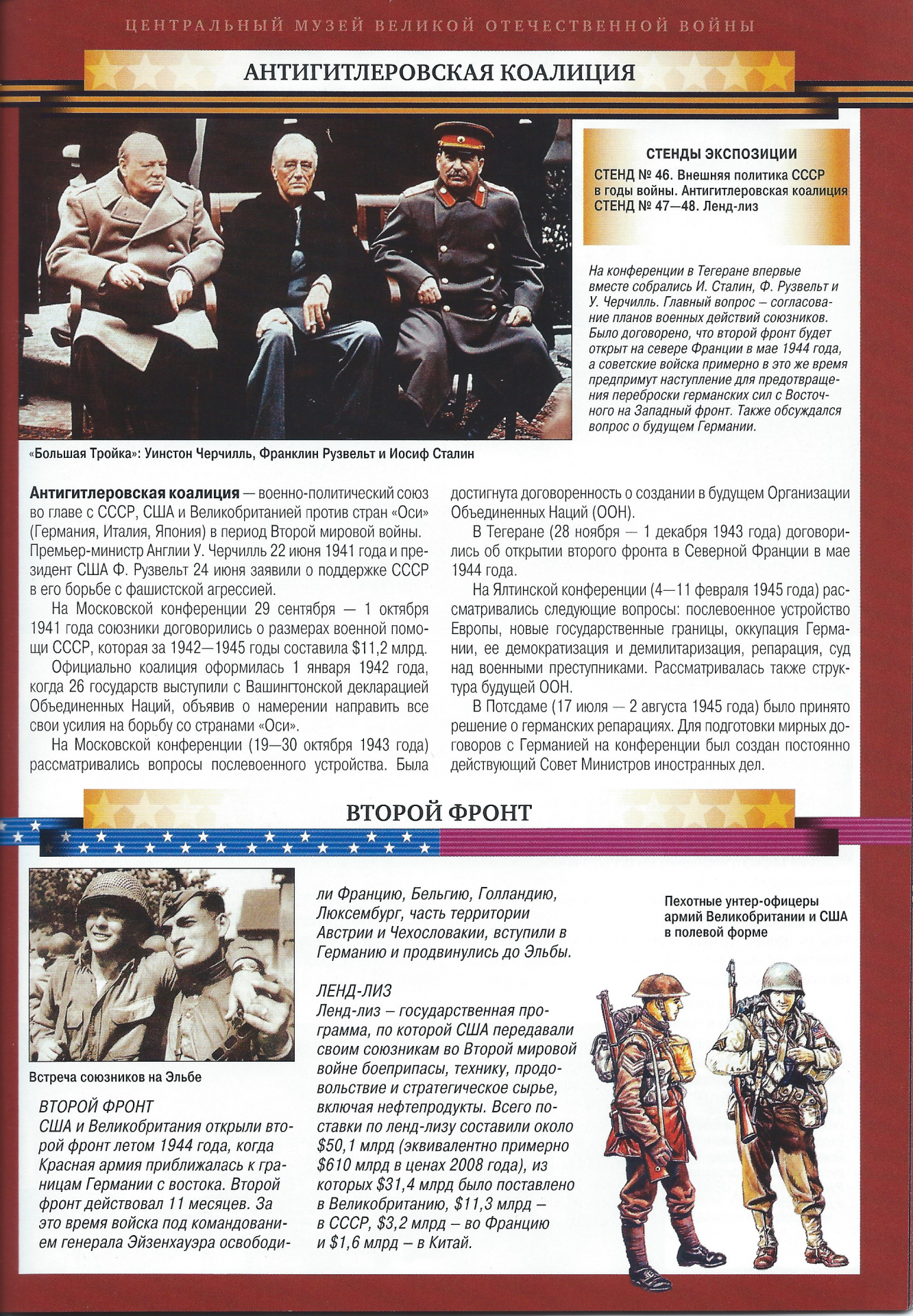
Антигитлеровская коалиция военно-политический союз во главе с СССР, США и Великобританией против стран «Оси» (Германия, Италия, Япония) в период Второй мировой войны. Премьер-министр Англии У. Черчилль 22 июня 1941 года и президент США Ф. Рузвельт 24 июня заявили о поддержке СССР в его борьбе с фашистской агрессией.
На Московской конференции 29 сентября 1 октября 1941 года союзники договорились о размерах военной помощи СССР, которая за 1942—1945 годы составила S11,2 млрд.
Официально коалиция оформилась 1 января 1942 года, когда 26 государств выступили с Вашингтонской декларацией Обьединенных Наций, объявив о намерении направить все свои усилия на борьбу со странами «Оси».
На Московской конференции (19—30 октября 1943 года) рассматривались вопросы послевоенного устройства. Была достигнута договоренность о создании в будущем Организации Объединенных Наций (О0Н).
В Тегеране (28 ноября -1 декабря 1943 года) договорились об открытии второго фронта в Северной Франции в мае 1944 года.
На Ялтинской конференции (4—11 февраля 1945 года) рассматривались следующие вопросы: послевоенное устройство Европы, новые государственные границы, оккупация Германии, ее демократизация и демилитаризация, репарация, суд над военными преступниками. Рассматривалась таюже структура будущей ООН.
В Потсдаме (17 июля 2 августа 1945 года) было принято решение о германских репарациях. Для подготовки мирных договоров с Германией на конференции был создан постоянно действующий Совет Министров иностранных дел.
The anti-Hitler coalition is a military-political union led by the USSR, USA and Great Britain against the Axis countries (Germany, Italy, Japan) during the Second World War. British Prime Minister W. Churchill on June 22, 1941 and US President F. Roosevelt on June 24 announced support for the USSR in its fight against fascist aggression.
At the Moscow Conference on September 29, October 1, 1941, the Allies agreed on the amount of military assistance to the USSR, which for the years 1942-1945 amounted to S11.2 billion.
The coalition officially took shape on January 1, 1942, when 26 states issued the Washington Declaration of the United Nations, announcing their intention to direct all their efforts to the struggle against the Axis countries.
At the Moscow Conference (October 19-30, 1943), questions of the post-war structure were considered. It was agreed to establish a future United Nations (OH).
In Tehran (November 28 – December 1, 1943), they agreed to open a second front in Northern France in May 1944.
At the Yalta Conference (February 4–11, 1945), the following issues were considered: the post-war structure of Europe, new state borders, the occupation of Germany, its democratization and demilitarization, reparation, and the trial of war criminals. The structure of the future UN was also considered.
In Potsdam (July 17, August 2, 1945), a decision was made on German reparations. To prepare peace treaties with Germany, a permanent Council of Foreign Ministers was created at the conference.
Top section photo captions
СТЕНДЫ экспозиции
СТЕНД No 46. Внешняя политика СССР в годы войны. Антигитлеровская коалиция
СТЕНД No 47-48. Ленд-лиз
Exposition STANDS
STAND No 46. Foreign policy of the USSR during the war. Anti-Hitler coalition
STAND No 47-48. Lend lease
На конференции в Тегеране впервые вместе собрались И. Сталин, Ф. Рузвельт и У. Черчилль. Главный вопрос- согласование планов военных действий союзников. Было договорено, что второй фронт будет открыт на севере Франции в мае 1944 года, а советские войска примерно в это же время предлримут наступление для предотвращения переброски германских сил с Восточного на Заладный фронт. Также обсуждался вопрос о будущем Германии.
At a conference in Tehran, I. Stalin, F. Roosevelt and W. Churchill gathered for the first time. The main issue is the coordination of the Allied war plans. It was agreed that a second front would be opened in northern France in May 1944, and at about the same time, Soviet troops would launch an offensive to prevent the transfer of German forces from the East to the Zaladny (Western?) Front. They also discussed the future of Germany.
«Большая Тройка»: Уинстон Черчилль, Франклин Рузвельт и Иосиф Сталин
The Big Three: Winston Churchill, Franklin Roosevelt and Joseph Stalin
Title: ВТОРОЙ ФРОНТ
Translation: SECOND FRONT
ВТОРОЙ ФРОНТ
США и Великобритания открыли второй фронт летом 1944 года, когда Красная армия приближалась к границам Германии с востока. Второй фронт действовал 11 месяцев. За это время войска под командованием генерала Эйзенхауэра освободили Францию, Бельгию, Голландию, Люксембург, часть территории Австрии и Чехословакии, вступили в Германию и продвинулись до Эльбы.
The United States and Great Britain opened a second front in the summer of 1944, when the Red Army was approaching German borders from the east. The second front operated for 11 months. During this time, troops under the command of General Eisenhower liberated France, Belgium, Holland, Luxembourg, part of the territory of Austria and Czechoslovakia, entered Germany and advanced to the Elbe.
ЛЕНД-ЛИЗ
Ленд-лиз — государственная про- грамма, по которой США передавали своим союзникам во Второй мировой войне боеприпасы, технику, продовольствие и стратегическое сырье, включая нефтепродукты. Всего поставки по ленд-лизу составили около $50,1 млрд (эквивалентно примерно $610 млрд в ценах 2008 года), из которых $31,4 млрд было поставлено в Великобританию, $11,3 млрд— СССР, $3,2 млрд-во Францию и $1,6 млрд – в Китай.
LEND-LEASE
Lend-Lease is a state program through which the United States transferred ammunition, equipment, food, and strategic raw materials, including petroleum products, to its allies in World War II. In total, Lend-Lease deliveries amounted to about $50.1 billion (equivalent to approximately $610 billion in 2008 prices), of which $31.4 billion was delivered to the UK, $11.3 billion to the USSR, $3.2 billion to France and $1.6 billion – to China.
Bottom section photo captions
Встреча союзников на Эльбе
Allied meeting on the Elbe
Пехотные унтер-офицеры армий Великобритании и США в полевой форме
Field infantry non-commissioned officers of the armies of Great Britain and the USA
Title: ТРАГЕДИЯ НАРОДОВ. ХОЛОКОСТ
Translation: TRAGEDY OF PEOPLES. HOLOCAUST
В основу «восточного похода» нацистской Германии была положена идея тотальной войны – не только уничтожение вооруженных сил, но и массовое истребление жителей завоеванных государств. Фашисты беспощадно грабили захваченные ими территории: вывозили оттуда сырье, продовольственные и промышленные товары, угоняли мирных жителей на принудительные работы в Германию, разрушали памятники культуры, уничтожали коммунистов и комсомольцев, истребляли евреев и представителей других «Низших» рас.
В разработке и осуществлении планов массового уничтожения мирного населения непосредственное участие при- нимало ведомство рейхсфюрера СС Гиммлера, создавшее зловещую «индустрию человекоистребления».
Чтобы придать истреблению евреев и других «нежелательных элементов» еще более широкий и организованный характер, нацисты начали строить в Польше «лагеря смерти», где особые подразделения — зондеркоманды — должны были осуществлять массовое уничтожение людей. Террор приобрел широкие масштабы. Усиленными темпами продолжалось массовое истребление народов оккупированных стран, особенно евреев, цыган и славян. В «лагеря уничтожения» шли поезда с людьми, которых расстреливали, вешали, душили в газовых камерах. Их трупы сжигали; одежду, личные вещи и драгоценности убитых отправляли в Германию. Способы, применяемые для истребления людей в концентрационных лагерях, были бесчеловечными: жестокое обращение, псевдонаучные опыты, газовые камеры, «душегубки» и печи для кремации.
The basis of the “eastern campaign” of Nazi Germany was the idea of a total war – not only the destruction of the armed forces, but also the mass extermination of the inhabitants of the conquered states. The Nazis mercilessly robbed the territories they seized: they exported raw materials, food and industrial goods from there, drove civilians to forced labor in Germany, destroyed cultural monuments, destroyed communists and Komsomol members, exterminated Jews and representatives of other “Lower” races.
In the development and implementation of plans for the mass extermination of civilians, direct involvement was played by the SS Reichsfuhrer Himmler’s department, which created the ominous “human extermination industry.”
To make the extermination of Jews and other “undesirable elements” even more broad and organized, the Nazis began to build “death camps” in Poland, where special units – sonderkommands – were to carry out mass extermination of people. Terror has become widespread. The mass extermination of the peoples of the occupied countries, especially Jews, Roma and Slavs, continued at an accelerated pace. Trains with people who were shot, hung, and strangled in gas chambers were going to the “extermination camps”. Their corpses were burned; clothes, personal belongings and valuables of the dead were sent to Germany. The methods used to exterminate people in concentration camps were inhuman: abuse, pseudo-scientific experiments, gas chambers, “gas chambers” (not sure why this is repeated in quotes) and cremation furnaces.
СТЕНДЫ ЭКСПозиции
СТЕНДЫ No 24, 30, 32. Холокост
СТЕНД No 26. Tрагедия плена
СТЕНД No 27. Kонвейер уничтожения
СТЕНД No 28. Mалолетние узники нацизма
Exposition STANDS
STANDS No 24, 30, 32. Holocaust
STAND No 26. Tragedy of captivity
STAND No 27. Destruction conveyor
STAND No 28. Young prisoners of Nazism
Photo captions left facing
В результате Холокоста- зверского уничтожения евреев немецкими фашистами (от греч. холокаустос со- жженный целиком) по- гибли более 6 млн человек еврейского населения Польши, Украины, Бело- руссии, России, Прибалтики, Румынии, Венгрии, Франции и других стран.
As a result of the Holocaust – brutal extermination of Jews by German fascists (from the Greek ‘Holocaustos’ – burned entirely) more than 6 million people of the Jewish population of Poland, Ukraine, Belarus, Russia, the Baltic states, Romania, Hungary, France and other countries were killed.
Right facing photo captions
Немцы создали сеть концлагерей- мест массового заключения и физического уничтожения противников нацистского режима, военнопленных и гражданских лиц. Концентрационные лагеря в Европе это огромная индустрия смерти, состоявшая из 23 основных лагерей и 2 тысяч филиалов. В них содержались 18 млн человек, из которых 11 млн были уничтожены. Всему миру стали известны лагеря смерти: Освенцим-самый крупный концлагерь на территории Польши, в котором погибли 1,1 млн узников, большей частью евреев и жителей Центральной и Восточной Европы; Майданек – 1380 тыс., Треблинка-800 тыс., Маутхаузен -около 123 ты., Заксенхаузен 56 тыс., Равенсбрюк – 92 ты., Бухенвальд — 56 тыс., Берген-Бельзен 48 тыс., Дахау – 31 тыс.
The Germans created a network of concentration camps, places of mass detention and physical destruction of opponents of the Nazi regime, prisoners of war and civilians. Concentration camps in Europe is a huge death industry, consisting of 23 main camps and 2 thousand branches. They contained 18 million people, of which 11 million were destroyed. The death camps became known to the whole world: Auschwitz, the largest concentration camp in Poland, which killed 1.1 million prisoners, mostly Jews and residents of Central and Eastern Europe; Majdanek – 1380 thousand, Treblinka – 800 thousand, Mauthausen – about 123 thousand, Sachsenhausen – 56 thousand, Ravensbrück – 92 thousand, Buchenwald – 56 thousand, Bergen-Belsen – 48 thousand, Dachau – 31 thousand
Истреблялись в концентрационных лагерях не только взрослое население, но и дети. Самым мерзким злодеянием по отношению к ним было выкачивание детской крови. Худые и болезненные дети использовались как источники крови для нужд немецких госпиталей. Фашисты организовали в лагере Саласпилс фабрику детской крови.
Not only the adult population, but also children were exterminated in concentration camps. The most vile crime in relation to them was the pumping of children’s blood. Skinny and sickly children were used as blood sources for the needs of German hospitals. The Nazis organized a children’s blood factory in the Salaspils camp.
Для германского фашизма характерны жестокость и бесчеловечность, зверства и злодеяния в таких масштабах, которых история ранее не знала. Нацисты претворяли в действительность чудовищные планы массового уничтожения военнопленных и мирных жителей, развивали технику обезлюживания, т.е. устранение целых расовых единиц, миллионов «низшей» расы. Истребление, пытки, разграбление были возведены в ранг государственной политики. Фашисты замучили, расстреляли, уничтожили в газовых камерах свыше 12 млн женщин, стариков, детей, хладно- кровно и безжалостно истребляли военнопленных.
German fascism is characterized by cruelty and inhumanity, atrocities and atrocities on a scale that history did not previously know. The Nazis put into effect the monstrous plans for the mass extermination of prisoners of war and civilians, developed the technique of depopulation, i.e. elimination of whole racial units, millions of “lower” races. Extermination, torture, and looting were elevated to the rank of state policy. The Nazis tortured, shot, and destroyed over 12 million women, old people, children in gas chambers, and exterminated prisoners of war in cold blood and ruthlessly.
Title: БИТВА ЗА БЕРЛИН
Translation: BATTLE FOR BERLIN
Diorama “The storm of Berlin”
Немецкое командование превратило Берлин в мощный укрепленный район. Вокруг него было возведено три оборонительных кольца— внешнее, внутреннее и городское, а в самом городе создали девять секторов обороны: восемь по окружности и один-в центре. Центральный сектор, охватывавший основные государственные и административные учреждения, в том числе Рейхстаг и имперскую канцелярию, в инженерном отношении был подготовлен особенно тщательно.
Берлинская операция началась 16 апреля. Противник сопротивлялся с ожесточенным упорством. Чтобы ускорить проДВИжение войск, маршал Г.К. Жуков ввел в сражение танковые и механизированные корпуса 1-й и 2-й гвардейских танковых армий. Попытки противника изменить ход сражения успеха не имели. Окружение войск противника начались 19 апреля. 25 апреля передовые подразделения 1-го Украинского фронта Встретились на берегу Эльбы в районе Торгау с разведгруппами 1-й американской армии генерала О. Брадли. В честь этого события Москва салютовала войскам 1-го Украинского фронта.
Взятие Берлина. Во избежание напрасного кровопролития командование 1-го Белорусского фронта 23 апреля предложило гарнизону Берлина сдаться, но ответа не последовало. Днем 25-го и ночью 26 апреля более 2 тыс. самолетов 16-й и 18-й воздушных армий, которыми командовали генерал С. Руденко и главный маршал авиации А. Голованов, нанесли по городу три массированных удара. Утром 30 апреля четыре общевойсковые и четыре танковые армии двух фронтов, наступая с севера, востока и юга, начали штурм Рейхстага. 2 мая гарнизон Берлина прекратил сопротивление. Капитуляция остатков берлинского гарнизона состоялась утром 2 мая по приказу его последнего командующего генерала артиллерии Г. Вейдлинга. Ликвидация берлинской группировки немецких войск завершилась.
The German command turned Berlin into a powerful fortified area. Three defensive rings were erected around it – external, internal and urban, and nine defense sectors were created in the city itself: eight in a circle and one in the center. The central sector, which covered the main state and administrative institutions, including the Reichstag and the imperial chancellery, was especially carefully prepared in engineering terms.
The Berlin operation began on April 16th. The enemy resisted with fierce perseverance. To expedite the advance of the troops, Marshal G.K. Zhukov brought into battle the tank and mechanized corps of the 1st and 2nd Guards Tank Armies. The enemy’s attempts to change the course of the battle were unsuccessful. The encirclement of enemy troops began on April 19. On April 25, the advanced units of the 1st Ukrainian Front met on the banks of the Elbe in the Torgau region with reconnaissance groups of the 1st American Army, General O. Bradley. In honor of this event, Moscow saluted the troops of the 1st Ukrainian Front.
The capture of Berlin. To avoid unnecessary bloodshed, the command of the 1st Belorussian Front invited the garrison of Berlin to surrender on April 23, but there was no answer. On the day of the 25th and night of April 26, more than 2 thousand aircraft of the 16th and 18th air armies commanded byGeneral S. Rudenko and Chief Air Marshal A. Golovanov inflicted three massive attacks on the city. On the morning of April 30, four combined arms and four tank armies of two fronts, advancing from the north, east and south, launched an assault on the Reichstag. On May 2, the garrison of Berlin ceased resistance. The surrender of the remnants of the Berlin garrison took place on the morning of May 2 on the orders of his last commander of artillery general G. Weidling. The liquidation of the Berlin group of German troops has ended.
Map
БЕРЛИНСКАЯ ОПЕРАЦИЯ (16 апреля —8 мая 1945 г.)
BERLIN OPERATION (April 16 — May 8, 1945)
Берлинская стратегическая наступательная операция. Ход боевых действий. Берлинская операция (15 апреля —8 мая 1945 г.) проводилась войсками 1-го и 2-го Белорусского и 1-го Украинского фронтов. В операции принимали участие Днепровская военная флотилия, части сил Балтийского флота, 18-й воздушной армии, трех корпусов ПВО страны, 1-я и 2-я армии Войска Польского. Первый этап (15-18 апреля) прорыв обороны противника. Второй этап (19-25 апреля) начало окружения и расчленения войск противника. Третий этап (26 апреля 8 мая) уничтожение берлинской группировки противника и взятие Берлина. Продолжительность операции 23 дня. Ширина фронта боевых действий 300 км. Глубина продвижения советских войск— 150 км. В ходе Берлинской операции советские войска разгромили 93 дивизии врага, взяли в плен 480 тыс. солдат и офицеров. Красная армия за время операции потеряла более 300 тыс. человек убитыми и ранеными.
Berlin strategic offensive operation. The course of hostilities. The Berlin operation (April 15 — May 8, 1945) was carried out by troops of the 1st and 2nd Belorussian and 1st Ukrainian fronts. The Dnieper naval flotilla, part of the forces of the Baltic Fleet, the 18th Air Army, three air defense corps of the country, the 1st and 2nd Army of the Polish Army took part in the operation. The first stage (April 15-18) is the breakthrough of the enemy’s defense. The second stage (April 19-25) began the encirclement and dismemberment of enemy forces. The third stage (April 26, May 8) the destruction of the enemy’s Berlin group and the capture of Berlin. The duration of the operation is 23 days. The width of the battle front is 300 km. The depth of advancement of Soviet troops is 150 km. During the Berlin operation, Soviet troops defeated 93 enemy divisions and captured 480 thousand soldiers and officers. The Red Army during the operation lost more than 300 thousand people killed and wounded.
СТЕНДЫ ЭКСпозиции
СТЕНДЫ No 52, 58. Разгром нацистской Германии. Поверженный Берлин
СТЕНД No 53. Встреча союзников
СТЕНДЫ No 54, 70. Победа
EXHIBITION STANDS
STANDS No 52, 58. The defeat of Nazi Germany. Defeated Berlin
STAND No 53. Meeting of the Allies
STAND No 54, 70. Victory
Photo captions left facing
Плакат «Мы победили!», В. Иванов Великая Отечественная война завершилась полной победой Красной армии. Советский народ победил и это народ-Победитель!
The poster “We won!”, V. Ivanov The Great Patriotic War ended with the complete victory of the Red Army. The Soviet people defeated and this is the Victorious people!
«Катюша» имела 16 направляющих для пуска 132-мм снарядов М-13, каждый весом 42 кг с дальностью полета 8470 м. По заявкам армии в годы войны были созданы различные варианты реактивных снарядов и пусковых установок. В июле 1941- декабре 1944 годов советская промышленность поставила в войска свыше 10 тыс. боевых машин «Катюша» и СВыше 12 млн реактивных снарядов к ним.
Katyusha had 16 guides for launching 132-mm M-13 shells, each weighing 42 kg with a flight range of 8470 m. At the request of the army, various versions of rockets and launchers were created during the war. In July 1941- December 1944, Soviet industry delivered more than 10 thousand Katyusha combat vehicles and over 12 million rockets to them in the troops.
Пусковая установка БМ-13H «Катюша», установленная на шасси американского грузовика «Студебеккер», которые получали по ленд-лизу
BM-13H Katyusha launcher mounted on the chassis of the Studebaker American truck, which was received through a lend-lease
Photo captions right facing
Водружение Красного знамени над Рейхстагом
Raising the Red Banner over the Reichstag
КАПИТУЛЯЦИЯ
Акт о безоговорочной капитуляции Германии от 8 мая 1945 года был подписан 9 мая в 00.43 по московскому времени в предместье Берлина Карлсхорсте уполномоченной Германской делегацией во главе с бывшим начальником штаба Верховно- го главнокомандования вермахта генерал- фельдмаршалом В. Кейтелем.
CAPITULATION
The act of unconditional surrender of Germany dated May 8, 1945 was signed on May 9 at 00.43 Moscow time on the outskirts of Berlin Karlshorst by the authorized German delegation led by the former chief of staff of the Supreme Command of the Wehrmacht, General Field Marshal W. Keitel.
От Верховного Главнокомандования Красной армии подписать Акт был уполномочен Маршал Советского Союза Г.К. Жуков.
From the Supreme High Command of the Red Army to sign the Act was authorized by Marshal of the Soviet Union G.K. Zhukov.
Подлисание Акта о безоговорочной капитуляции Германии
German Unconditional Surrender
Title: ВОЙНА С ЯПОНИЕЙ
Translation: WAR WITH JAPAN
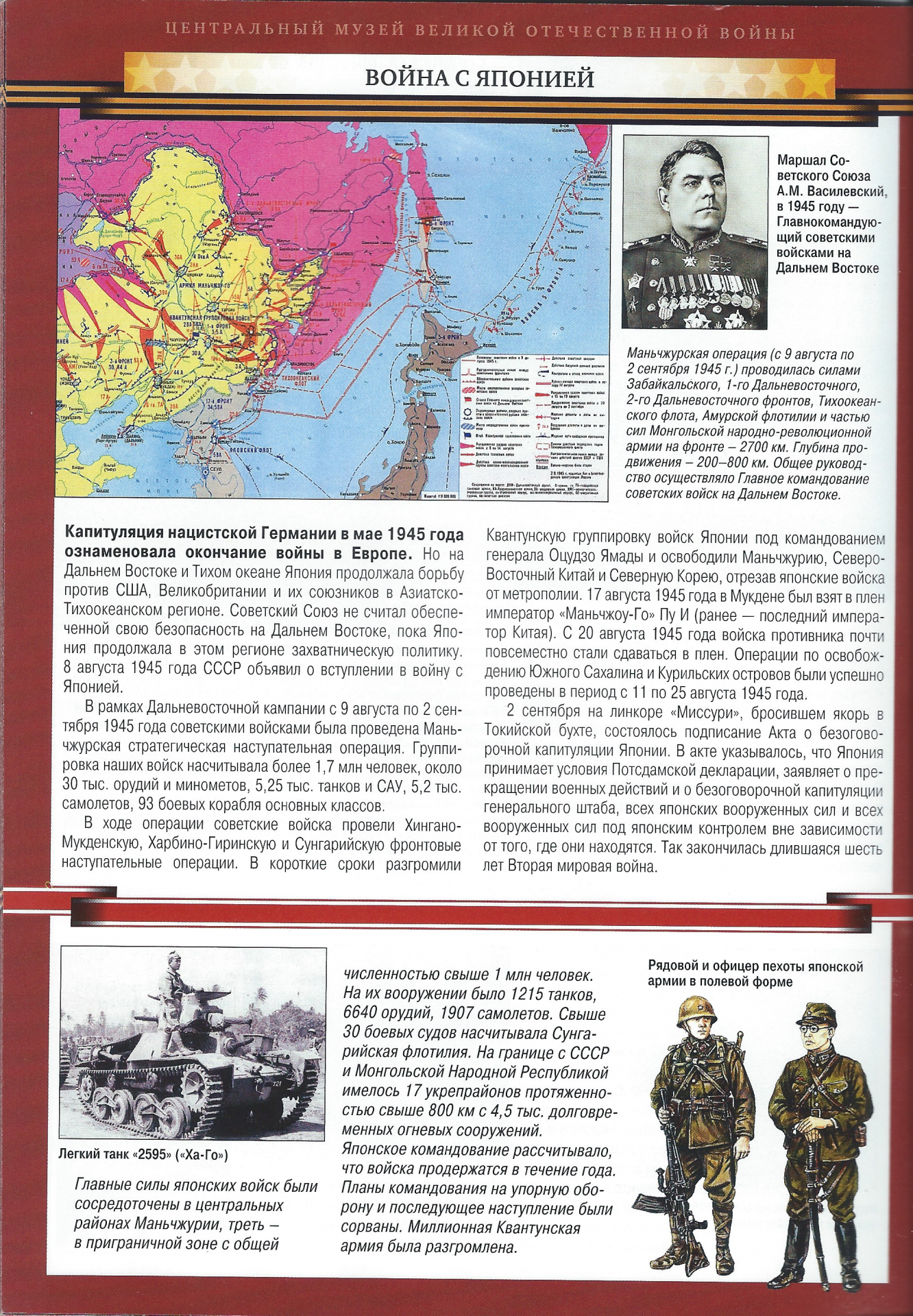
Капитуляция нацистской Германии в мае 1945 года ознаменовала окончание войны в Европе. Но на Дальнем Востоке и Тихом океане Япония продолжала борьбу против США, Великобритании и их союзников в Азиатско- Тихоокеанском регионе. Советский Союз не считал обеспеченной свою безопасность на Дальнем Востоке, пока Япония продолжала в этом регионе захватническую политику. августа 1945 года СССР объявил о вступлении в войну с Японией.
В рамках Дальневосточной кампании с 9 августа по 2 сентября 1945 года советскими войсками была проведена Маньчкурская стратегическая наступательная операция. Группировка наших войск насчитывала более 1,7 млн человек, около 30 тыс. орудий и минометов, 5,25 тыс. танков и САУ, 5,2 тыс. самолетов, 93 боевых корабля основных классов.
В ходе операции советские войска провели Хингано- Мукденскую, Харбино-Гиринскую и Сунгарийскую фронтовые наступательные операции. В короткие сроки разгромили Квантунскую группировку войск Японии под командованием генерала Оцудзо Ямады и освободили Маньчжурию, Северо- Восточный Китай и Северную Корею, отрезав японские войска от метрополии. 17 августа 1945 года в Мукдене был взят в плен император «Маньчжоу-Го» Пу И (ранее- последний император Китая). С 20 августа 1945 года войска противника почти повсеместно стали сдаваться в плен. Операции по освобождению Южного Сахалина и Курильских островов были успешно проведены в период с 11 по 25 августа 1945 года.
2 сентября на линкоре «Миссури», бросившем якорь в Токийской бухте, состоялось подлисание Акта о безоговорочной капитуляции Японии. В акте указывалось, что Япония принимает условия Потсдамской декларации, заявляет о прекращении военных действий и о безоговорочной капитуляции генерального штаба, всех японских вооруженных сил и всех вооруженных сил под японским контролем вне зависимости от того, где они находятся. Так закончилась длившаяся шесть лет Вторая мировая война.
The surrender of Nazi Germany in May 1945 marked the end of the war in Europe. But in the Far East and the Pacific, Japan continued to struggle against the United States, Britain, and their allies in the Asia-Pacific region. The Soviet Union did not consider its security in the Far East ensured while Japan continued its aggressive policy in this region. August 1945, the USSR announced the entry into the war with Japan.
As part of the Far Eastern campaign, from August 9 to September 2, 1945, the Soviet troops carried out the Manchkur strategic offensive operation. The grouping of our troops totaled more than 1.7 million people, about 30 thousand guns and mortars, 5.25 thousand tanks and self-propelled guns, 5.2 thousand aircraft, 93 warships of the main classes.
During the operation, Soviet troops carried out the Khingan-Mukden, Harbin-Girin and Sungaria frontal offensive operations. In a short time, they defeated the Kwantung group of forces of Japan under the command of General Otsuzo Yamada and liberated Manchuria, Northeast China and North Korea, cutting off Japanese troops from the metropolis. On August 17, 1945, the Emperor of Manzhou-Guo Pu Yi (formerly the last emperor of China) was captured in Mukden. Since August 20, 1945, enemy forces almost everywhere began to surrender. The operations to liberate South Sakhalin and the Kuril Islands were successfully carried out between August 11 and 25, 1945.
On September 2, the Missouri battleship, which anchored in Tokyo Bay, was attacked by an act of unconditional surrender of Japan. The act stated that Japan accepts the terms of the Potsdam Declaration, announces the cessation of hostilities and the unconditional surrender of the General Staff, all Japanese armed forces and all armed forces under Japanese control, regardless of where they are located. Thus ended the six-year-old Second World War.
Map
Маньчкурская операция (с 9 августа по 2 сентября 1945 г.) проводилась силами Забайкальского, 1-го Дальневосточного, 2-го Дальневосточного фронтов, Тихоокеанского флота, Амурской флотилии и частью сил Монгольской народно-революционной армии на фронте- 2700 км. Глубина про- движения- 200-800 км. Общее руководство осуществляло Главное командование советских войск на Дальнем Востоке.
The Manchkur operation (from August 9 to September 2, 1945) was carried out by the forces of the Transbaikal, 1st Far Eastern, 2nd Far Eastern fronts, the Pacific Fleet, the Amur Flotilla and part of the forces of the Mongolian People’s Revolutionary Army at the front – 2700 km. Depth of advancement is 200-800 km. General management was carried out by the High Command of the Soviet troops in the Far East.
Photo Captions
Маршал Советского Союза А.М. Василевский, в 1945 году — Главнокомандующий советскими войсками на Дальнем Востоке
Marshal of the Soviet Union A.M. Vasilevsky, in 1945 – Commander-in-Chief of Soviet troops in the Far East
Легкий танк «2595» («Ха-Го»)
Light tank “2595” (“Ha-Go”)
Главные силы японских войск были сосредоточены в центральных районах Маньчжурии, треть – в приграничной зоне с общей численностью свыше 1 млн человек. На их вооружении было 1215 танков, 6640 орудий, 1907 самолетов. Свыше 30 боевых судов насчитывала Сунгарийская флотилия. На границе с СССР и Монгольской Народной Республикой имелось 17 укрепрайонов протяженностью свыше 800 км с 4,5 тыс. долговременных огневых сооружений. Японское командование рассчитывало, что войска продержатся в течение года. Планы командования на упорную оборону и последующее наступление были сорваны. Миллионная Квантунская армия была разгромлена.
The main forces of the Japanese troops were concentrated in the central regions of Manchuria, a third – in the border zone with a total number of over 1 million people. They were armed with 1215 tanks, 6640 guns, 1907 aircraft. Over 30 warships totaled the Sungarian flotilla. On the border with the USSR and the Mongolian People’s Republic, there were 17 fortified areas with a length of over 800 km with 4,500 long-term firing structures. The Japanese command hoped that the troops would last for a year. The plans of the command for stubborn defense and the subsequent offensive were frustrated. The millionth Kwantung army was defeated.
Рядовой и офицер пехоты яnонской армии в полевой форме
Private and field infantry officer of the Japanese army
Title: АТОМНАЯ БОМБАРДИРОВКА ХИРОСИМЫ И НАГАСАКИ
Translation: ATOMIC BOMBARDMENT of HIROSHIMA and NAGASAKI
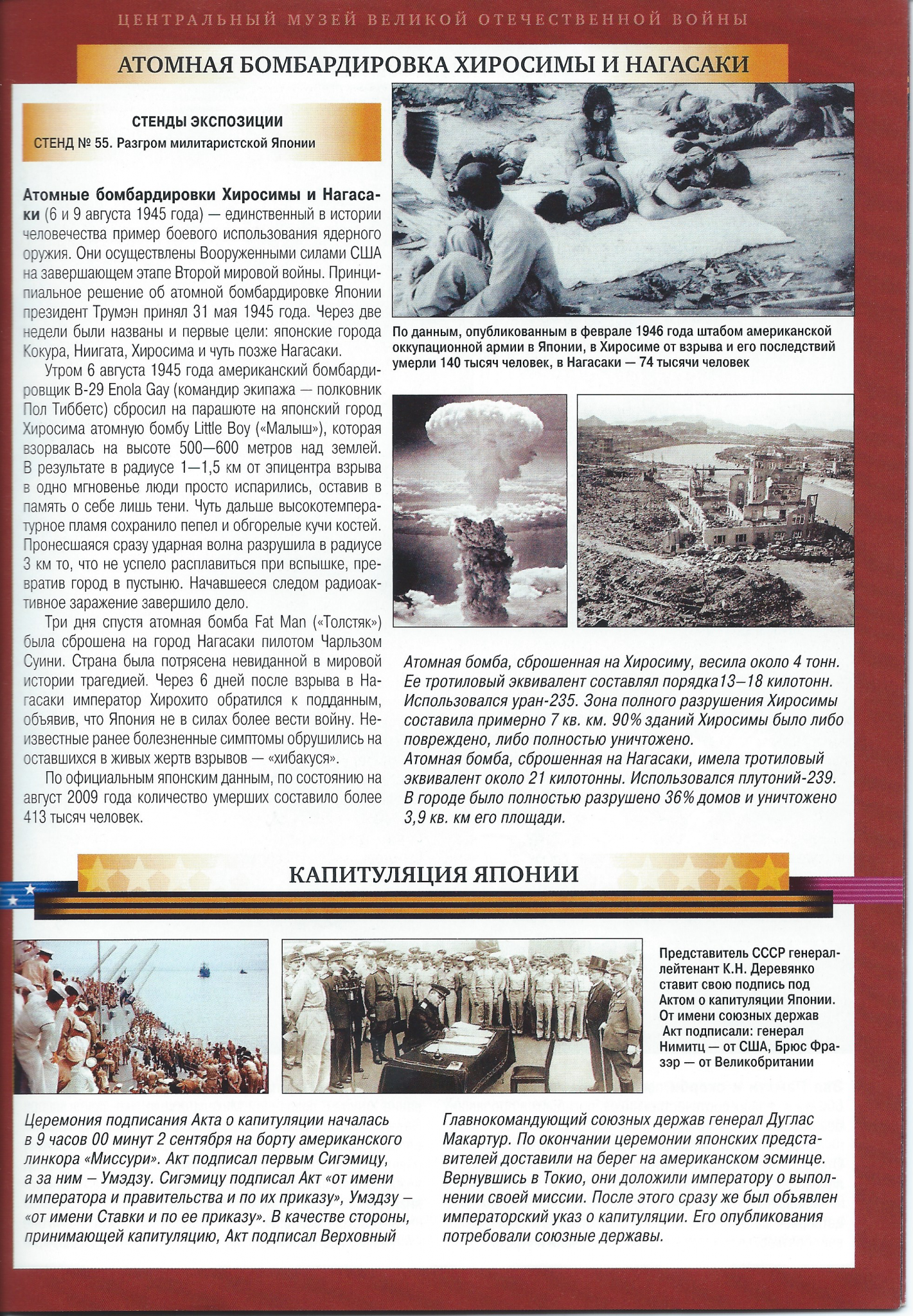
Атомные бомбардировки Хиросимы и Нагасаки (6 и 9 августа 1945 года) — единственный в истории человечества пример боевого использования ядерного оружия. Они осуществлены Вооруженными силами США на завершающем этапе Второй мировой войны. Принци- пиальное решение об атомной бомбардировке Японии президент Трумэн принял 31 мая 1945 года. Через две недели были названы и первые цели: японские города Кокура, Ниигата, Хиросима и чуть позже Нагасаки.
Утром 6 августа 1945 года американский бомбарлдировщик В-29 Enola Gay (командир экипажа полковник Пол Тиббетс) сбросил на парашюте на японский город Хиросима атомную бомбу Little Boy («Малыш»), которая взорвалась на высоте 500—600 метров над землей. В результате в радиусе 1—1,5 км от эпицентра взрыва в одно мгновенье люди просто испарились, оставив в память о себе лишь тени. Чуть дальше высокотемпературное пламя сохранило пепел и обгорелые кучи костей. Пронесшаяся сразу ударная волна разрушила в радиусе 3 км то, что не успело расплавиться при вспышке, превратив город в пустыню. Начавшееся следом радиоакТивное заражение завершило дело.
Три дня спустя атомная бомба Fat Man («Толстяк») была сброшена на город Нагасаки пилотом Чарльзом Суини. Страна была потрясена невиданной в мировой истории трагедией. Через 6 дней после взрыва в Нагасаки император Хирохито обратился к подданным, объявив, что Япония не в силах более вести войну. Неизвестные ранее болезненные симптомы обрушились на Оставшихся в живых жертв взрывов- «хибакуся».
По официальным японским данным, по состоянию на август 2009 года количество умерших составило более 413 тысяч человек.
The atomic bombing of Hiroshima and Nagasaki (August 6 and 9, 1945) is the only example in the history of mankind of the combat use of nuclear weapons. They were carried out by the US Armed Forces at the final stage of World War II. President Truman made a fundamental decision on the atomic bombing of Japan on May 31, 1945. Two weeks later, the first goals were announced: the Japanese cities of Kokura, Niigata, Hiroshima and a little later Nagasaki.
On the morning of August 6, 1945, the American B-29 bomber Enola Gay (crew commander Colonel Paul Tibbets) parachuted the Little Boy atom bomb (“Kid”) on the Japanese city of Hiroshima, which exploded at an altitude of 500-600 meters above the ground. As a result, in an instant 1–1.5 km from the epicenter of the explosion, people simply evaporated, leaving only a shadow in their memory. A little further, the high-temperature flame retained the ashes and charred piles of bones. The shock wave that swept through immediately destroyed within a radius of 3 km that which had not time to melt during the outbreak, turning the city into a desert. The radioactive contamination that began next ended the case.
Three days later, the Fat Man atomic bomb (“Fat Man”) was dropped on the city of Nagasaki by pilot Charles Sweeney. The country was shocked by a tragedy unprecedented in world history. 6 days after the explosion in Nagasaki, Emperor Hirohito turned to his subjects, announcing that Japan was no longer able to wage war. Unknown previously painful symptoms hit the surviving victims of the Hibakusha bombings.
According to official Japanese data, as of August 2009, the number of deaths amounted to more than 413 thousand people.
СТЕНДЫ ЭКспозиции
СТЕНД No 55. Разгром милитаристской Японии
EXPOSITION STANDS
STAND No 55. The defeat of militaristic Japan
Top Section photo captions
По данным, опубликованным в феврале 1946 года штабом американской умерли 140 тысяч человек, в Нагасаки— 74 тысячи человек оккупационной армии в Японии, в Хиросиме от взрыва и его последствий
According to data published in February 1946 by the American headquarters, 140 thousand people died, in Nagasaki – 74 thousand people of the occupying army in Japan, in Hiroshima from the explosion and its consequences
Атомная бомба, сброшенная на Хиросиму, весила около 4 тонн. Ее тротиловый эквивалент составлял порядка 13-18 килотонн. Использовался уран-235. Зона полного разрушения Хиросимы составила примерно 7 кв. км. 90% зданий Хиросимы было либо повреждено, либо полностью уничтожено.
Атомная бомба, сброшенная на Нагасаки, имела тротиловый эквивалент около 21 килотонны. Использовался плутоний-239. В городе было полностью разрушено 36% домов и уничтожено 3.9 кв. км его площади.
The atomic bomb dropped on Hiroshima weighed about 4 tons. Its TNT equivalent was about 13-18 kilotons. Uranium-235 was used. The area of complete destruction of Hiroshima was approximately 7 square kilometers. 90% of Hiroshima’s buildings were either damaged or completely destroyed.
The atomic bomb dropped on Nagasaki had a TNT equivalent of about 21 kilotons. Plutonium-239 was used. In the city, 36% of the houses were completely destroyed and 3.9 square kilometers of its area were destroyed.
Title: КАПИТУЛЯЦИЯ ЯПОНИИ
Translation: CAPITULATION OF JAPAN
Церемония подписания Акта о капитуляции началась в 9 часов 00 минут 2 сентября на борту американского линкора «Миссури». Акт подписал первым Сигэмицу, а за ним — Умэдзу. Сигэмицу подписал Акт «от имени императора и правительства и по их приказу», Умэдзу— «от имени Ставки и по ее приказу». В качестве стороны, принимающей капитуляцию, Акт подписал Верховный Главнокомандующий союзных держав генерал Дуглас Макартур. По окончании церемонии японских представителей доставили на берег на американском эсминце. Вернувшись в Токио, они доложили императоруо выполнении своей мисси. После этого сразу же был объявлен императорский указ о капитуляции. Eго опубликования потребовали союзные державы.
The ceremony of signing the Act of Surrender began at 9:00 on September 2 aboard the American battleship Missouri. The act was first signed by Shigemitsu, followed by Umezu. Shigemitsu signed the Act “on behalf of the emperor and the government and on their orders”, Umezu – “on behalf of the Headquarters and on her orders.” As the party accepting surrender, the Act was signed by the Supreme Commander of the Allied Powers, General Douglas MacArthur. At the end of the ceremony, Japanese representatives were brought ashore in an American destroyer. Returning to Tokyo, they reported to the emperor about their mission. After that, an imperial decree of surrender was immediately announced. Allied powers demanded its publication.
Представитель СССР генераллейтенант К.Н. Деревянко ставит свою подпись под Актом о капитуляции Японии. От имени союзных держав Акт подписали: генерал Нимитц — от США, Брюс Фразэр — от Великобритании
Representative of the USSR General Lieutenant K.N. Derevianko puts his signature on the Japan Surrender Act. On behalf of the Allied Powers, the Act was signed: General Nimitz – from the USA, Bruce Fraser – from the UK
Title: ЗАЛ ПАМЯТИ И СКОРБИ
Translation: HALL OF MEMORY AND SORROW
Зал Памяти и скорби посвящен памяти 26 миллионов 600 тысяч наших соотечественников, погибших и пропавших без вести.
B центре зала установлен памятник жертвам Великой Отечественной войны – скульптурная группa «Скорбь”, выполненная из белого мрамора.
Женщина, склонившаяся над поверженным воином, олицетворяет мать, сестру и жену, оплакивающих своих сыновей, братьев, мужей. Это лик скорби, печали и утраты.
Скульптурная группа исполнена на мотив пьеты «Оплакивание Христа», созданной Микеланджело пять веков назад. На ней Христос, снятый с распятья, распростерт на коленях оплакивающей его Богоматери. По христианскому сюжету павший воин подобен Христу, принесшему себя в жертву. чтобы спасти людей. Воина оплакивает Богоматерь, символизирующая Русь. Родина-мать скорбит о своем Спасителе.
В русской иконописи есть подобный сюжет на иконе «Успение», где побеждает не смерть, а вечная жизнь, грядущая через духовное возрождение. У подножия скульптуры всегда лежат живые цветы, а минорное настроение создается при помощи приглушенного освещения, светильников, выполненных в виде поминальных свечей, и соответствующего музыкального сопровождения.
Стены Зала Памяти отделаны мрамором красных, черных и багряных тонов; пол выложен полированными мраморными плитами. Потолок Зала художественно оформлен подвесками из латунных цепочек, на концах которых закреплены «хрусталики», символизирующие слезы, выплаканные по погибшим. Количество цепочек соответствует числу погибших воинов.
С внешней стороны Зала Памяти стены оформлены мемориальными бронзовыми досками, на которых высечены 1744 наименования фронтов, армий, дивизий, частей и соединений Красной армии и Военно-морского флота, участвовавших в боевых действиях Великой Отечественной и Советско-Японской войн, а также сражавшиеся вместе с Красной армией воинские части иностранных государств.
The Hall of Memory and Sorrow is dedicated to the memory of 26 million 600 thousand of our compatriots who died and went missing.
In the center of the hall is a monument to the victims of World War II – the sculptural group “Sorrow”, made of white marble.
A woman bending over a defeated warrior personifies mother, sister and wife, mourning their sons, brothers, husbands. This is the face of sorrow, sorrow and loss.
The sculpture group is executed on the motive of the play “Mourning of Christ”, created by Michelangelo five centuries ago. On it, Christ, taken from the crucifix, is stretched out on the knees of the Mother of God mourning him. According to the Christian story, the fallen warrior is similar to Christ, who sacrificed himself to save people. The warrior is mourned by the Mother of God, symbolizing Russia. Mother Motherland mourns for her Savior.
In Russian icon-painting there is a similar plot on the icon “Assumption”, where not death wins, but eternal life, coming through spiritual rebirth. Fresh flowers always lie at the foot of the sculpture, and the minor mood is created with the help of dim lighting, lamps made in the form of funeral candles, and the corresponding musical accompaniment.
The walls of the Hall of Memory are decorated with marble of red, black and crimson tones; the floor is lined with polished marble slabs. The ceiling of the Hall is artistically decorated with pendants made of brass chains, at the ends of which are fixed “lenses”, symbolizing the tears cried out by the deceased. The number of chains corresponds to the number of dead soldiers.
On the outside of the Hall of Memory, the walls are decorated with memorial bronze plaques on which 1744 names of fronts, armies, divisions, units and formations of the Red Army and Navy that participated in the hostilities of the Great Patriotic and Soviet-Japanese Wars, as well as military units of foreign states fighting along with the Red Army.
Photo Captions
Похоронка- обиходное название официального извещения о смерти, высылаемого командованием части в адрес ближайших родственников погибшего воина в период Великой Отечественной войны. Зачастую штабисты не располагали точным адресом павшего в боях за Родину и тогда направляли извещение в военкомат по месту призыва красноармейца.
The funeral is the common name for the official death notice sent by the command of the unit to the immediate family of the deceased soldier during the Great Patriotic War. Often, the staff did not have the exact address of the fallen in the battles for their homeland and then sent a notice to the military enlistment office at the place of the call of the Red Army.
В Зале Памяти хранится 385 томов Книги Памяти. В них вписаны имена людей, погибших в боях за Родину, умерших в госпиталях, пропавших без вести и попавших в плен.
Книга Памяти — это особая книга, в которой за каждой строкой, за каждой фамилией стоят победы и поражения, триумфы и потери страшной войны: это летопись нашей памяти о тех, кто уже никогда не вернется.
Для увековечения памяти защитников Родины, не вернувшихся с Великой Отечественной войны, в Центральном музее Великой Отечественной войны в 1995 году была создана электронная Книга Памяти, где в электронном Именном каталоге записаны имена погибших, пропавших без вести, умерших от рани болезней воинов. В ее памяти зафиксировано около 20 миллионов имен — достоверно известные имена погибших, дата и место гибели.
B музее также хранится около 1500 томов Всесоюзной Книги Памяти, где в поименных перечнях этого уникального издания, приведены краткие сведения о судьбах миллионов воинов.
In the Hall of Memory 385 volumes of the Book of Memory are stored. They include the names of people who died in battles for their homeland, who died in hospitals, disappeared and were captured.
The Book of Memory is a special book in which behind each line, behind each surname are victories and defeats, triumphs and losses of a terrible war: this is a chronicle of our memory of those who will never return.
In order to perpetuate the memory of the defenders of the Motherland who did not return from the Great Patriotic War, in 1995 the Central Museum of the Great Patriotic War created an electronic Book of Memory, in which the names of the dead, missing, and dead from the wounds of warriors’ illnesses are recorded in the electronic name catalog. In her memory about 20 million names are recorded – reliably known names of the dead, date and place of death.
The museum also holds about 1,500 volumes of the All-Union Book of Memory, where in the roll-call lists of this unique publication, brief information is given on the fate of millions of soldiers.
Title: НЮРНБЕРГСКИЙ ПРОЦЕСС
Translation: NUREMBERG PROCESS
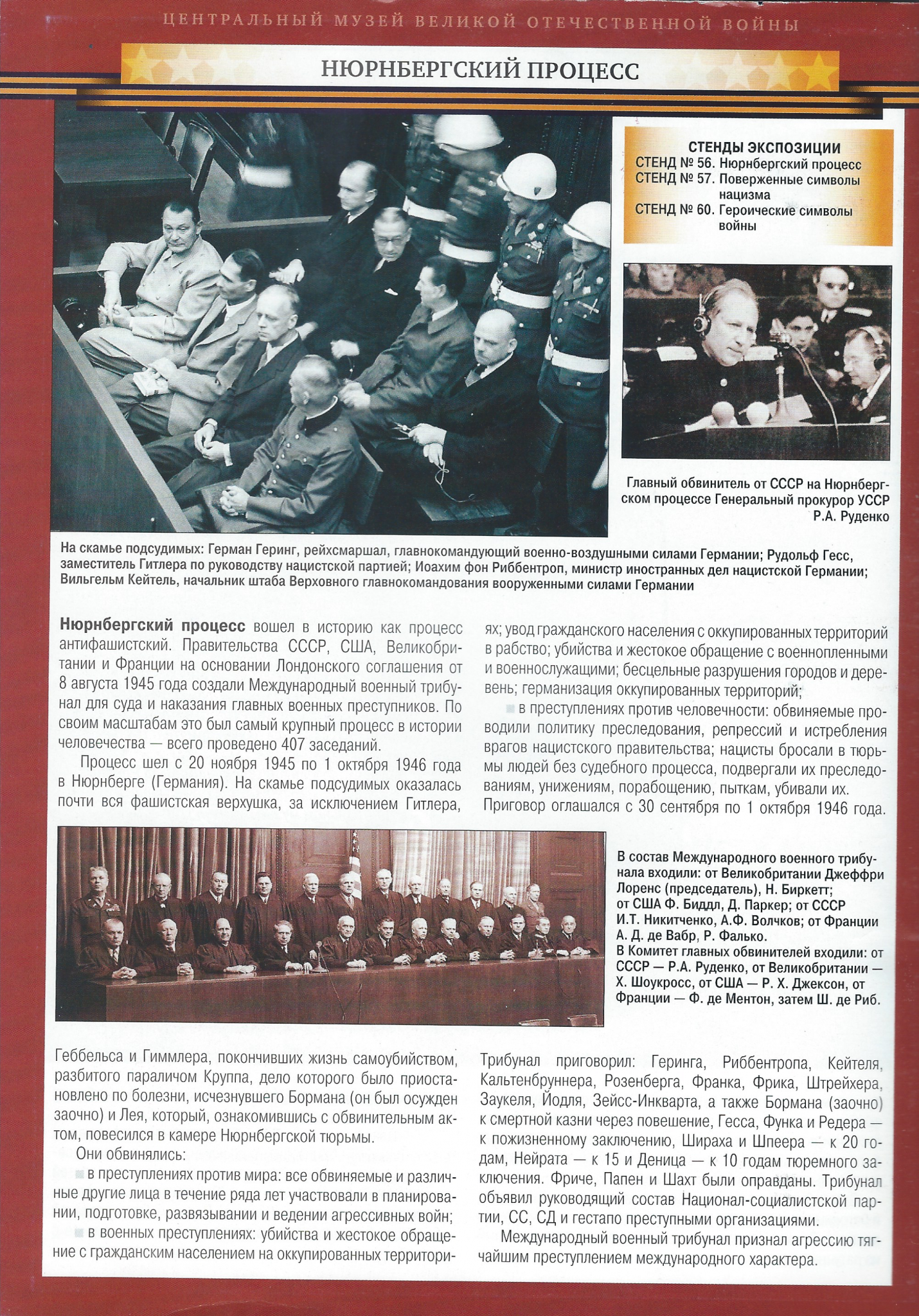
Нюрнбергский процесс вошел в историю как процесс антифашистский. Правительства СССР, США, Великобри- тании и Франции на основании Лондонского соглашения от 8 августа 1945 года создали Международный военный трибу- нал для суда и наказания главных военных преступников. По своим масштабам это был самый крупный процесс в истории человечества —всего проведено 407 заседаний.
Процесс шел с 20 ноября 1945 по 1 октября 1946 года в Нюрнберге (Германия). На скамье подсудимых оказалась почти вся фашистская верхущшка, за исключением Гитлера, Геббельса и Гиммлера, покончивших жизнь самоубийством, разбитого параличом Круппа, дело которого было приоста- новлено по болезни, исчезнувшего Бормана (он был осужден заочно) и Лея, который, ознакомившись с обвинительным актом, повесился в камере Нюрнбергской тюрьмы.
Они обвинялись:
- в преступлениях против мира: все обвиняемые и различные другие лица в течение ряда лет участвовали в планировании, подготовке, развязывании и ведении агрессивных войн;
- в военных преступлениях: убийства и жестокое обращение с гражданским населением на оккупированных территори-ях; увод гражданского населения С окупированных территорий в рабство; убийства и жестокое обращение с военнопленными и военнослужащими; бесцельные разрушения городов и деревень; германизация оккупированных территорий.
- в преступлениях против человечности: обвиняемые проводили политику преследования, репрессий и истребления врагов нацистского правительства; нацисты бросали в ткюрьмы людей без судебного процесса, подвергали их преследованиям, унижениям, порабощению, пыткам, убивали их.
Приговор оглашался с 30 сентября по 1 октября 1946 года. Трибунал приговорил: Геринга, Риббентропа, Кейтеля, Кальтенбруннера, Розенберга, Франка, Фрика, Штрейхера, Заукеля, Йодля, Зейсс-Инкварта, а также Бормана (заочно) к смертной казни через повешение, Гесса, Функа и Редера к пожизненному заключению, Шираха и Шпеера-к 20 годам, Нейрата-к 15 и Деница-к 10 годам тюремного за- ключения. Фриче, Папен и Шахт были оправданы. Трибунал объявил руководящий состав Национал-социалистской партии, СС, СД и гестапо преступными организациями.
Международный военный трибунал признал агрессию тягчайшим преступлением международного характера.
The Nuremberg trials went down in history as an anti-fascist process. The governments of the USSR, the USA, Great Britain, and France, on the basis of the London agreement of August 8, 1945, created the International Military Tribunal for the trial and punishment of major war criminals. In scale, it was the largest process in the history of mankind — a total of 407 meetings were held.
The process went from November 20, 1945 to October 1, 1946 in Nuremberg (Germany). Almost the entire fascist elite was on the dock, with the exception of Hitler, Goebbels and Himmler, who committed suicide, defeated by the paralysis of Krupp, whose case was suspended due to illness, Bormann’s disappeared (he was convicted in absentia) and Leah, who, having familiarized himself with the accuser act, hanged himself in the cell of the Nuremberg prison.
They were accused:
- in crimes against peace: all accused and various other persons for several years participated in the planning, preparation, unleashing and waging of aggressive wars;
- in war crimes: killings and ill-treatment of civilians in the occupied territories; the withdrawal of civilians from the occupied territories into slavery; killings and ill-treatment of prisoners of war and military personnel; aimless destruction of cities and villages; Germanization of the occupied territories.
- in crimes against humanity: the defendants pursued a policy of persecution, repression and extermination of the enemies of the Nazi government; the Nazis threw people into the prisons without trial, subjected them to harassment, humiliation, enslavement, torture, killed them.
The verdict was announced from September 30 to October 1, 1946. The Tribunal sentenced: Goering, Ribbentrop, Keitel, Kaltenbrunner, Rosenberg, Frank, Frik, Streicher, Sauckel, Jodl, Zeiss-Inquart, as well as Bormann (in absentia) to death by hanging, Hess, Funck and Roeder for life imprisonment Speer – to 20 years, Neurath – to 15 and Doenitz – to 10 years in prison. Frice, Papen and Schacht were acquitted. The Tribunal declared the leadership of the National Socialist Party, SS, SD and Gestapo criminal organizations.
The International Military Tribunal recognized aggression as a grave crime of an international nature.
СТЕНДЫ ЭКСПозиции
СТЕНД No 56. Hюрнбергский процесс
СТЕНД No 57. Поверженные символы нацизма
СТЕНД No 60. Героические символы войны
EXPOSITION STANDS
STAND No 56. Nuremberg Trials
STAND No 57. The defeated symbols of Nazism
STAND No 60. Heroic symbols of war
Photo Captions
Главный обвинитель от СССР на Нюрнбергском процессе Генеральный прокурор УССР Р.А. Руденко
The main prosecutor from the USSR at the Nuremberg trials, Attorney General of the USSR R.A. Rudenko
На скамье подсудимых: Герман Геринг, рейхсмаршал, главнокомандующий военно-воздушными силами Германии; Рудольф Гес, заместитель Гитлера по руководству нацистской партией; Иоахим фон Риббентроп, министр иностранных дел нацистской Германии; Вильгельм Кейтель, начальник штаба Верховного главнокомандования вооруженными силами Германии
In the dock: Hermann Goering, Reichsmarschall, Commander-in-Chief of the German Air Force; Rudolf Ges, Hitler’s deputy head of the Nazi Party; Joachim von Ribbentrop, Minister for Foreign Affairs of Nazi Germany; Wilhelm Keitel, Chief of Staff of the Supreme High Command of the Armed Forces of Germany
В состав Международного военного трибунала входили: от Великобритании Джеффри Лоренс (председатель), Н. Биркетт; от сША Ф. Биддл, Д. Паркер; от СССР И.Т. Никитченко, А.Ф. Волчков;B от Франции А. Д. де Вабр, Р. Фалько.
В Комитет главных обвинителей входили: от СССР — Р.А. Руденко, от Великобритании- Х. Шоукросс, от США – Р. Х. Джексон, от Франции- Ф. де Ментон, затем Ш. де Риб.
The International Military Tribunal included: from the United Kingdom, Jeffrey Lawrence (President), N. Birkett; from USA F. Biddle, D. Parker; from the USSR I.T. Nikitchenko, A.F. Volchkov; B from France A.D. de Wabr, R. Falco.
The Committee of the main prosecutors included: from the USSR – R.A. Rudenko, from Great Britain – H. Shawcross, from the USA – R. H. Jackson, from France – F. de Menton, then S. de Rib.
When complete, a link to the translation of the map insert of the map-guide will be placed here.





































